Asperger Syndrome
description: neurodevelopmental disorder affecting social interaction
73 results
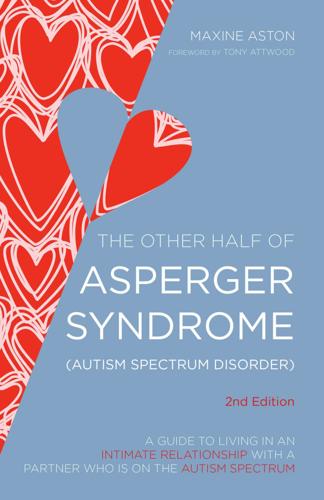
The Other Half of Asperger Syndrome (Autism Spectrum Disorder): A Guide to Living in an Intimate Relationship With a Partner Who Is on the Autism Spectrum Second Edition
by
Maxine Aston
Published 21 Feb 2014
Some studies have measured whether or not children diagnosed as having Asperger syndrome have a parent who has Asperger syndrome or autistic traits. One study (Gillberg 1989) discovered that, in 57 per cent of cases of children with Asperger syndrome, there was a parent who displayed autistic traits or who also had Asperger syndrome. These figures do not tell us how likely it is that a couple where one partner has Asperger syndrome will have a child who will also have the syndrome. However, they do tell us that in 43 per cent of cases neither parent has Asperger syndrome. This further highlights just how complex the genetic factors involved in inheritance are, and might suggest that in some cases the possibility of an environmental cause should not be ruled out.
…
He identified this condition as ‘autistic psychopathy’ and believed that it was an inherited personality disorder, as he recognised similar traits in the children’s parents. The name Asperger Syndrome was first introduced by Lorna Wing in her classic paper published in 1981 (Wing 1981). She used the name Asperger syndrome in preference to ‘autistic psychopathy’. The word ‘psychopathy’ means an abnormality of personality and implies sociopathic behaviour, a very different disorder from what we now think of as Asperger syndrome. What is the autistic spectrum? Asperger syndrome is an Autistic Spectrum Disorder. The autistic spectrum encompasses Asperger syndrome and autism, both of which may vary from severe to mild, or ‘high-functioning’.
…
A partner with Asperger syndrome may be male or female During the course of my original research, I was only able to make contact with two women who have Asperger syndrome and who are in an intimate long-term relationship. This is likely to be due to the fact that, as we have seen, Asperger syndrome seems to affect more males than females (Ehlers and Gillberg 1993; Gillberg 1989; Wing 1981). In my own work I am seeing more and more women with Asperger syndrome, and am of the opinion that there are far more women on the spectrum than statistics suggest. Women with Asperger syndrome are often excellent at learning social skills, and many have the ability to disguise their social difficulties.

Asperger Syndrome and Alcohol: Drinking to Cope?
by
Matthew Tinsley
and
Sarah Hendrickx
Published 31 May 2008
Veronica Bliss and Genevieve Edmonds Foreword by Bill O’Connell, Director of Training, Focus on Solutions ISBN 978 1 84310 513 8 Finding a Different Kind of Normal Misadventures with Asperger Syndrome Jeanette Purkis Foreword by Donna Williams ISBN 978 1 84310 416 2 Survival Strategies for People on the Autism Spectrum Marc Fleisher ISBN 978 1 84310 261 8 Asperger Syndrome and Employment Adults Speak Out about Asperger Syndrome Edited by Genevieve Edmonds and Luke Beardon ISBN 978 1 84310 648 7 Adults Speak Out about Asperger Syndrome series Asperger Syndrome and Social Relationships Adults Speak Out about Asperger Syndrome Edited by Genevieve Edmonds and Luke Beardon ISBN 978 1 84310 647 0 Adults Speak Out about Asperger Syndrome series ASPERGER SYNDROME and ALCOHOL DRINKING TO COPE?
…
ASPERGER SYNDROME and ALCOHOL by the same author Asperger Syndrome – A Love Story Sarah Hendrickx and Keith Newton Foreword by Tony Attwood ISBN 978 1 84310 540 4 Love, Sex and Long-Term Relationships What People with Asperger Syndrome Really Really Want Sarah Hendrickx Foreword by Stephen M. Shore ISBN 978 1 84310 605 0 of related interest The Complete Guide to Asperger’s Syndrome Tony Attwood ISBN 978 1 84310 495 7 (hardback) ISBN 978 1 84310 669 2 (paperback) A Self-Determined Future with Asperger Syndrome Solution Focused Approaches E. Veronica Bliss and Genevieve Edmonds Foreword by Bill O’Connell, Director of Training, Focus on Solutions ISBN 978 1 84310 513 8 Finding a Different Kind of Normal Misadventures with Asperger Syndrome Jeanette Purkis Foreword by Donna Williams ISBN 978 1 84310 416 2 Survival Strategies for People on the Autism Spectrum Marc Fleisher ISBN 978 1 84310 261 8 Asperger Syndrome and Employment Adults Speak Out about Asperger Syndrome Edited by Genevieve Edmonds and Luke Beardon ISBN 978 1 84310 648 7 Adults Speak Out about Asperger Syndrome series Asperger Syndrome and Social Relationships Adults Speak Out about Asperger Syndrome Edited by Genevieve Edmonds and Luke Beardon ISBN 978 1 84310 647 0 Adults Speak Out about Asperger Syndrome series ASPERGER SYNDROME and ALCOHOL DRINKING TO COPE?
…
Poor interaction with people, leading to social isolation, depression, lethargy and lack of ambition. (Male with Asperger Syndrome) Life-long difficulty making sense of what people get up to in their everyday lives and careers. Solitary habits…persistent and obsessive involvement in my own troubles and concerns. (Male with Asperger Syndrome) I can be aloof if I am worried that people do not want me to interact with them. I find it hard to cope with unpredictability. (Female with Asperger Syndrome) He doesn’t like large social gatherings…finds it difficult to figure why other people think as they do, has tantrums… (Wife of male with Asperger Syndrome) Mental exhaustion trying to figure out life, relationships and social dynamics and consequences; three mental breakdowns, two in the past five years.
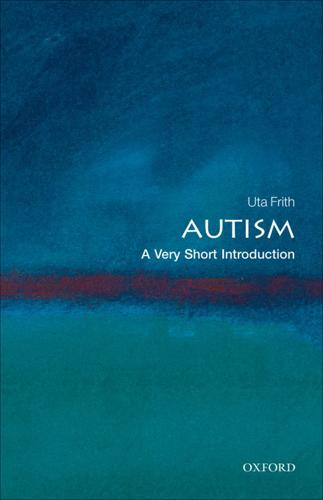
Autism: A Very Short Introduction
by
Uta Frith
Published 22 Oct 2008
Research still needs to uncover the early signs of Asperger syndrome. In contrast to autism language is not delayed, but rather it is often advanced, as in the case of Edward. Further, classic autism implies aloofness, while this is not necessarily found in Asperger syndrome. Individuals with Asperger syndrome often have a strong interest in other people. Children typically seek out adults as valued listeners to monologues, as answerers of questions, and providers of useful information. A striking difference between autism and Asperger syndrome in childhood is that the child with Asperger syndrome displays high verbal intelligence.
…
Not surprisingly, many parents craved the diagnosis Asperger syndrome rather than autism. The popularity of the label rose inexorably. Rightly or wrongly, Asperger syndrome has become a magnet that attracts cases. One of its attractions is that it has acquired the cachet of being linked to genius. No wonder then that a diagnosis of Asperger syndrome suggests a more interesting and possibly more tractable difficulty than autism. But this is not correct. The difficulty is just as persistent as in other autistic disorders. Nevertheless, Asperger syndrome has a special place in the popular imagination.
…
Many old people see their partners and friends die before them and they have to get used to being lonely, a very hard adaptation for most of us. Is it easier if you never had any friends? Asperger syndrome Asperger syndrome has gained such popularity that we need to give it some special attention. It can be seen as a variety of autism with similar biological causes and similar effects on the development of brain and mind, but with somewhat different behavioural manifestations. At least this is what we assume at present. Asperger syndrome is usually considered a mild form of autism. But this may be deceptive. It may be a form of relatively pure autism where massive learning and compensation are covering up the core problems.
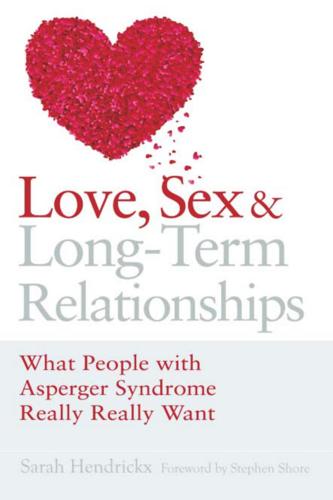
Asperger Syndrome: A Love Story
by
Sarah Hendrickx
and
Keith Newton
Published 14 Jun 2007
Love, Sex and Long-Term Relationships by the same author Asperger Syndrome – A Love Story Sarah Hendrickx and Keith Newton Foreword by Tony Attwood ISBN 978 1 84310 540 4 Asperger Syndrome and Employment What People with Asperger Syndrome Really Really Want Sarah Hendrickx ISBN 978 1 84310 677 7 of related interest The Complete Guide to Asperger’s Syndrome Tony Attwood ISBN 978 1 84310 495 7 Asperger’s Syndrome and Sexuality From Adolescence through Adulthood Isabelle Hénault Foreword by Tony Attwood ISBN 978 1 84310 189 5 Sex, Sexuality and the Autism Spectrum Wendy Lawson Foreword by Glenys Jones ISBN 978 1 84310 284 7 Aspergers in Love Maxine Aston Foreword by Gisela Slater-Walker ISBN 978 1 84310 115 4 An Asperger Marriage Gisela and Christopher Slater-Walker Foreword by Tony Attword ISBN 978 1 84310 017 1 Asperger Syndrome and Long-Term Relationships Ashley Stanford Foreword by Liane Holliday Willey ISBN 978 1 84310 734 7 Asperger Syndrome and Employment Adults Speak Out about Asperger Syndrome Edited by Genevieve Edmonds and Luke Beardon ISBN 978 1 84310 648 7 Adults Speak Out about Asperger Syndrome series Love, Sex and Long-Term Relationships What People with Asperger Syndrome Really Really Want Sarah Hendrickx Foreword by Stephen Shore Jessica Kingsley Publishers London and Philadelphia First published in 2008 by Jessica Kingsley Publishers 116 Pentonville Road London N1 9JB, UK and 400 Market Street, Suite 400 Philadelphia, PA 19106, USA www.jkp.com Copyright © Sarah Hendrickx 2008 Foreword copyright © Stephen Shore 2008 All rights reserved.
…
Love, Sex and Long-Term Relationships by the same author Asperger Syndrome – A Love Story Sarah Hendrickx and Keith Newton Foreword by Tony Attwood ISBN 978 1 84310 540 4 Asperger Syndrome and Employment What People with Asperger Syndrome Really Really Want Sarah Hendrickx ISBN 978 1 84310 677 7 of related interest The Complete Guide to Asperger’s Syndrome Tony Attwood ISBN 978 1 84310 495 7 Asperger’s Syndrome and Sexuality From Adolescence through Adulthood Isabelle Hénault Foreword by Tony Attwood ISBN 978 1 84310 189 5 Sex, Sexuality and the Autism Spectrum Wendy Lawson Foreword by Glenys Jones ISBN 978 1 84310 284 7 Aspergers in Love Maxine Aston Foreword by Gisela Slater-Walker ISBN 978 1 84310 115 4 An Asperger Marriage Gisela and Christopher Slater-Walker Foreword by Tony Attword ISBN 978 1 84310 017 1 Asperger Syndrome and Long-Term Relationships Ashley Stanford Foreword by Liane Holliday Willey ISBN 978 1 84310 734 7 Asperger Syndrome and Employment Adults Speak Out about Asperger Syndrome Edited by Genevieve Edmonds and Luke Beardon ISBN 978 1 84310 648 7 Adults Speak Out about Asperger Syndrome series Love, Sex and Long-Term Relationships What People with Asperger Syndrome Really Really Want Sarah Hendrickx Foreword by Stephen Shore Jessica Kingsley Publishers London and Philadelphia First published in 2008 by Jessica Kingsley Publishers 116 Pentonville Road London N1 9JB, UK and 400 Market Street, Suite 400 Philadelphia, PA 19106, USA www.jkp.com Copyright © Sarah Hendrickx 2008 Foreword copyright © Stephen Shore 2008 All rights reserved.
…
Statistics of Sex 83 7. Asperger Syndrome Between the Sheets 93 8. Gender Identity and Sexuality 107 9. Infidelity and Inappropriate Behaviour 117 10. Great Sex! 127 11. Conclusion 137 REFERENCES 141 INDEX 143 Foreword Often shrouded in secrecy and shame, sexuality and intimate relationships can be a difficult topic to just talk about, never mind to research. For people with Asperger Syndrome these challenges are magnified still further due to myths and misconceptions of how we relate to others. However, Sarah Hendrickx has masterfully taken the vastly under-researched area of Asperger Syndrome and sexuality.
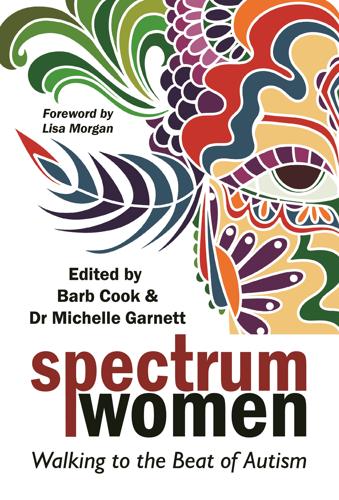
Spectrum Women: Walking to the Beat of Autism
by
Barb Cook
and
Samantha Craft
Published 20 Aug 2018
This is not a reflection of our personal choice in identification. • Asperger syndrome, Asperger’s, and the personal identifying term of aspie. We recognize that Asperger syndrome was removed from the current Diagnostic and Statistical Manual of Mental Disorders (DSM-5) and was brought together under the Autism Spectrum Disorder classification. At time of printing of this book, the International Classification of Diseases (ICD-10) still formally recognizes Asperger syndrome as a diagnosis. We have included these terms to encompass those who were/are diagnosed with Asperger syndrome and in a historical sense for academia. • High and low functioning.
…
A Guide to Autism and Asperger’s Self-Diagnosis for Adults, Lydia Andal (New Idealist, 2015) An Adult with an Autism Diagnosis: A Guide for the Newly Diagnosed, Gillan Drew (Jessica Kingsley Publishers, 2017) Asperger Syndrome in Adolescence: Living with the Ups, the Downs and Things in Between, Liane Holliday Willey (Jessica Kingsley Publishers, 2003) Asperger Syndrome in the Family: Redefining Normal, Liane Holliday Willey (Jessica Kingsley Publishers, 2001) Aspergirls: Empowering Females with Asperger Syndrome, Rudy Simone (Jessica Kingsley Publishers, 2010) Aspergirls: Empowering Females with Asperger Syndrome, Rudy Simone (Jessica Kingsley Publishers, 2010) Autism in Adulthood, Quarterly Journal (Mary Ann Liebert Inc.
…
St Leonards, Australia: Allen & Unwin. Singer, J. (2016) NeuroDiversity: The Birth of an Idea. Australia: Judy Singer. Stewart, C. (2011) “Hermeneutic Phenomenology: Experiences of girls with Asperger syndrome and anxiety” (PhD thesis), Napier University, Edinburgh. Stewart, C. (2012) “Where can we be what we are? The experiences of girls with Asperger syndrome and their mothers.” Good Autism Practice 13, 1, 40–48. Wing, L. (1981) “Asperger syndrome: A clinical account.” Psychological Medicine 11, 115–130. Chapter 6 Attwood, A. and Garnett M.S. (2016) Exploring Depression and Beating the Blues: A CBT Self-Help Guide to Understanding and Coping with Depression in Asperger’s Syndrome.

Thinking in Pictures: And Other Reports From My Life With Autism
by
Temple Grandin
Published 10 Jan 2006
They are not able to figure out that Dick, who is now outside the room, thinks that the box still contains a candy bar. People with Asperger's syndrome, who tend to be far less handicapped than people with Kanner-type autism, can usually pass this test and generally perform better on tests of flexible problem-solving than Kanner's syndrome autistics. In fact, many Asperger individuals never get formally diagnosed, and they often hold jobs and live independently. Children with Asperger's syndrome have more normal speech development and much better cognitive skills than those with classic Kanner's. Another label for Asperger's syndrome is “high-functioning autism.” One noticeable difference between Kanner's and Asperger's syndromes is that Asperger children are often clumsy.
…
His voice lacks tone, and he looks young and boyish for his age. Clothes and hygiene are low on his list of important things. Mild autistic traits can provide the singlemindedness that gets things done. Hans Asperger stresses the value of people with Asperger's syndrome, recognizing that they often achieve success in highly specialized academic professions. Individuals with Asperger's syndrome who are not retarded or afflicted with extreme rigidity of thinking can excel. Asperger concludes that narrowmindedness can be very valuable and can lead to outstanding achievement. There are few Einsteins today. Maybe they all flunk the Graduate Record Exam or get poor grades.
…
A. 2003 Neurodevelopmental disorders following thimerosal containing vaccines. Experimental Biology and Medicine, 228: 660–664 A. Gilchrist, J. Green, A. Cox, D. Burton, M. Rutter, A. LeCooteur 2001 Development and cortical functioning in adolescents with Asperger's syndrome: A comparative study. Journal of Child Psychiatry, 42: 227–240 C. Hart 1989 Development and cortical functioning in adolescents with Asperger's syndrome: A comparative study. Journal of Child Psychiatry, 42: 227–240 C. Holden 2005 Mating for autism, Science, 308: 948 M. Horney, D. Chian, Lipkin W. I. 2004 Neurotoxic effects of postnatal thimerosal mouse strain dependent.
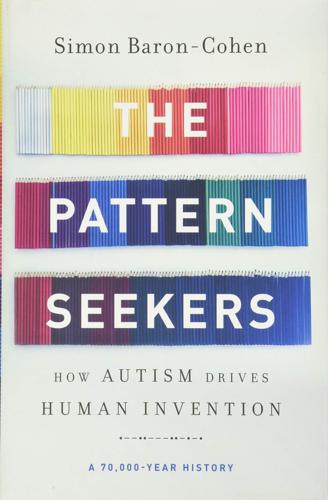
The Pattern Seekers: How Autism Drives Human Invention
by
Simon Baron-Cohen
Published 14 Aug 2020
Baron-Cohen (2017), “Toward autonomy and self-determination,” UN speech on Autism Awareness Day 2017, March 31, webtv.un.org/meetings-events/watch/toward-autonomy-and-self-determination-world-autism-awareness-day-2017/5380816054001. 7. On autism and emotion recognition, see O. Golan et al. (2006), “The Cambridge Mindreading (CAM) Face-Voice Battery: Testing complex emotion recognition in adults with and without Asperger syndrome,” Journal of Autism and Developmental Disorders 36, 169–183; O. Golan and S. Baron-Cohen (2006), “Systemizing empathy: Teaching adults with Asperger syndrome or high functioning autism to recognize complex emotions using interactive multimedia,” Development and Psychopathology 18, 591–617; and O. Golan et al. (2006), “The ‘Reading the Mind in Films’ task: Complex emotion recognition in adults with and without autism spectrum conditions,” Social Neuroscience 1, 111–123. 8.
…
Understanding propositions and propositional attitudes by normally developing children, and children with autism,” Israel Journal of Psychiatry 34, 174–178. 9. On feeling as if one is from a different planet, see Wrong Planet, www.wrongplanet.net; and C. Sainsbury (2009), Martian in the playground: Understanding the school child with Asperger syndrome (London: Sage Publications). Many autistic children identify with the title of Clare Sainsbury’s book. Clare’s foundation, Three Guineas Trust, kindly funded our clinic for the late diagnosis of Asperger syndrome from 1997 through 2010, at a time when the National Health Service said that diagnosing adults was not a priority. See S. Baron-Cohen (2007), “The lost generation,” Communication 41, 12–13; and M.
…
Rueda et al. (2015), “Dissociation between cognitive and affective empathy in youth with Asperger syndrome,” European Journal of Developmental Psychology 12, 85–98; and S. Baron-Cohen (2013), “Empathy deficits in autism and psychopaths: Mirror opposites?,” in M. Banaji and S. Gelman, eds., Navigating the social world: What infants, children, and other species can teach us (Oxford: Oxford University Press). 12. On Daniel Tammet, see S. Baron-Cohen et al. (2007), “Savant memory in a man with colour form-number synaesthesia and Asperger syndrome,” Journal of Consciousness Studies 14, 237–251; and D. Bor et al. (2007), “Savant memory for digits in a case of synaesthesia and Asperger syndrome is related to hyperactivity in the lateral prefrontal cortex,” Neurocase 13, 311–319.
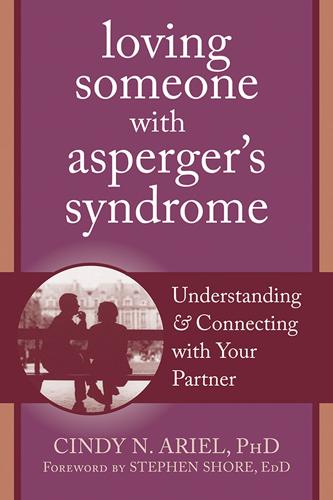
Loving Someone With Asperger's Syndrome: Understanding and Connecting With Your Partner
by
Cindy Ariel
Published 1 Mar 2012
London: Jessica Kingsley Publishers. Aston, M. C. 2001. The Other Half of Asperger Syndrome: A Guide to Living in an Intimate Relationship with a Partner Who Has Asperger Syndrome. London: The National Autistic Society. Bentley, K. 2007. Alone Together: Making an Asperger Marriage Work. London: Jessica Kingsley Publishers. Hendrickx, S., and K. Newton. 2007. Asperger Syndrome: A Love Story. London: Jessica Kingsley Publishers. Jacobs, B. 2006. Loving Mr. Spock: Understanding an Aloof Lover—Could It Be Asperger Syndrome? New ed. London: Jessica Kingsley Publishers. Simone, R. 2009. 22 Things a Woman Must Know: If She Loves a Man with Asperger’s Syndrome.
…
You can also find online support groups through many of the sites listed here. Asperger Syndrome Education Network (ASPEN) includes helpful resources for family and friends of people with Asperger’s syndrome on its website: www.aspennj.org. The Asperger Syndrome and High Functioning Autism Association of New York provides support, information, and useful resources: www.ahany.org. The Asperger’s Association of New England (AANE) has a helpful website with a few resources specifically for partners of adults with AS: www.aane.org. Aspires (Asperger Syndrome Partners and Individuals: Resources, Encouragement, and Support) devotes a website to issues that partners and family members face: http.aspires-relationships.com.
…
Living Well on the Spectrum: How to Use Your Strengths to Meet the Challenges of Asperger Syndrome / High-Functioning Autism. New York: The Guilford Press. Hénault, I. 2006. Asperger’s Syndrome and Sexuality: From Adolescence through Adulthood. London: Jessica Kingsley Publishers. Ortiz, J. M. 2008. The Myriad Gifts of Asperger’s Syndrome. London: Jessica Kingsley Publishers. Shore, S., and L. G. Rastelli. 2006. Understanding Autism for Dummies. Hoboken, NJ: Wiley Publishing. Simone, R. 2010. Aspergirls: Empowering Females with Asperger Syndrome. London: Jessica Kingsley Publishers. About Intimacy with Partners Who Have Asperger’s Aston, M. 2003.
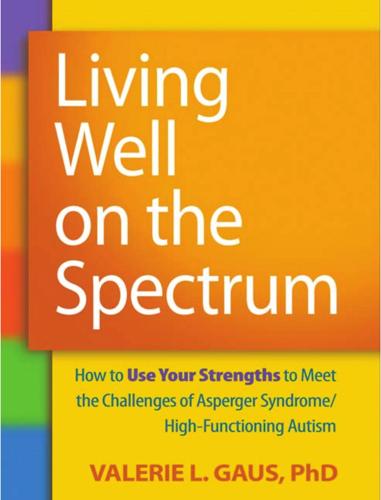
Living Well on the Spectrum
by
Valerie L. Gaus
Published 4 Feb 2011
Baron-Cohen, S. (2008). Autism and Asperger syndrome: The facts. London: Oxford University Press. McPartland, J. C., Klin, A., & Volkmar, F. R. (Eds.). (2014). Asperger syndrome (2nd ed.). New York: Guilford Press. Shore, S. M., & Rastelli, L. G. (2006). Understanding autism for dummies. Hoboken, NJ: Wiley. Autobiographical Accounts of ASD Carley, M. J. (2008). Aspergers from the inside out: A supportive and practical guide for anyone with Asperger’s syndrome. New York: Penguin. Finch, D. (2012). The journal of best practices: A memoir of marriage, Asperger syndrome, and one man's quest to be a better husband.
…
Elijah’s cup: A family’s journey into the community and culture of highfunctioning autism and Asperger syndrome. London: Jessica Kingsley. Prince-Hughes, D. (2004). Songs of the gorilla nation: My journey through autism. New York: Harmony Books. Robison, J. E. (2007). Look me in the eye: My life with Asperger’s. New York: Crown. Shore, S. (2003). Beyond the wall: Personal experiences with autism and Asperger syndrome (2nd ed.). Shawnee Mission, KS: Autism Asperger. Slater-Walker, C., & Slater-Walker, G. (2002). An asperger marriage. London: Jessica Kingsley. Wiley, L. H. (2001). Asperger syndrome in the family: Redefining normal. London: Jessica Kingsley.
…
Autism Society: www.autism-society.org Basic information about autism and Autism Society chapter locater by state for people who would like to be more involved. 372 Resources Global and Regional Asperger Syndrome Partnership (GRASP): www.grasp.org An educational and advocacy organization serving and run by people on the autism spectrum. Offers articles and interviews, lists of support groups on- and offline, and e-lists. OASIS@MAAP (jointly operated by Online Asperger Syndrome Information and Support and MAAP Services for Autism and Asperger Syndrome: www.aspergersyndrome. org A resource for families, individuals, and medical professionals that provides articles, educational resources, links to local, national, and international support groups, sources of professional help, conference information, recommended reading, and moderated support message boards.

Marriage and Lasting Relationships With Asperger's Syndrome: Successful Strategies for Couples or Counselors
by
Eva A. Mendes
Published 1 Sep 2015
What makes this book so helpful—what makes it stand apart—is her ability to elucidate the realities of both partners in a neurodiverse relationship, with helpful insights and genuine compassion for everyone involved.” —David Finch, New York Times best-selling author of The Journal of Best Practices: A Memoir of Marriage, Asperger Syndrome, and One Man’s Quest to Be a Better Husband Marriage and Lasting Relationships with Asperger’s Syndrome (Autism Spectrum Disorder) of related interest The Other Half of Asperger Syndrome (Autism Spectrum Disorder) A Guide to Living in an Intimate Relationship with a Partner who is on the Autism Spectrum 2nd Edition Maxine Aston Foreword by Tony Attwood ISBN 978 1 84905 498 0 eISBN 978 0 85700 920 3 The Asperger Couple’s Workbook Practical Advice and Activities for Couples and Counsellors Maxine Aston ISBN 978 1 84310 253 3 eISBN 978 1 84642 851 7 Alone Together Making an Asperger Marriage Work Katrin Bentley Foreword by Tony Attwood ISBN 978 1 84310 537 4 eISBN 978 1 84642 623 0 Troubleshooting Relationships on the Autism Spectrum A User’s Guide to Resolving Relationship Problems Ashley Stanford ISBN 978 1 84905 951 0 eISBN 978 0 85700 808 4 Sex, Sexuality and the Autism Spectrum Wendy Lawson Foreword by Glenys Jones ISBN 978 1 84310 284 7 eISBN 978 1 84642 112 9 Been There.
…
E. (2000) “Couples’ shared + participation in novel and arousing activities and experienced relationship quality.” Journal of Personality and Social Psychology, 78, 2, 273–284. Aston, M. (n.d.) “Cassandra Affective Deprivation Disorder.” Available at www.maxineaston.co.uk/cassandra, accessed July 5, 2014. Aston, M. (2001) The Other Half of Asperger Syndrome: A Guide to Living in an Intimate Relationship with a Partner who has Asperger Syndrome. London: National Autistic Society. Attwood, T., Evans, C. R. and Lesko, A. (2014) Been There. Done That. Try This: An Aspie’s Guide to Life on Earth. London: Jessica Kingsley Publishers. Attwood, T. (2007) The Complete Gudie to Asperger’s Syndrome.
…
Journal of Autism Developmental Disorders, 24, 5, 565–576. Finch, D. (2012) The Journal of Best Practices: A Memoir of Marriage, Asperger Syndrome, and One Man’s Quest to Be a Better Husband. New York, NY: Scribner. Finch, D. and Finch, K. (2012) “Yes, You Are Supposed to Hug Me Now: Best Practices for Neurologically-Mixed Marriages and Other Harrowing Relationships.” Talk presented by AANE in Waltham, MA. December 1, 2012. Gaus, V. L. (2007) Cognitive-Behavioral Therapy for Adult Asperger Syndrome. New York, NY: Guilford Press. Goleman, D. (2005) Emotional Intelligence: Why it can Matter More than IQ. New York, NY: Bantam Books.
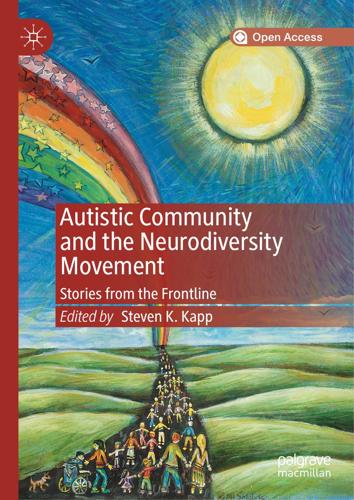
Autistic Community and the Neurodiversity Movement: Stories From the Frontline
by
Steven K. Kapp
Published 19 Nov 2019
I read nothing more about autism until 1999, after our first meeting with his fourth-grade teacher.1 Her classroom observations led us back to the Sacks article, which resonated anew. A psychologist encouraged us to obtain an evaluation, and after several months of testing, in mid-2000 our child was diagnosed with Asperger syndrome. 1 Since mid-2006, I have consistently used masculine pronouns to refer to the person identified in many of my earlier advocacy letters as my youngest daughter. K. Seidel (B) Peterborough, NH, USA © The Author(s) 2020 S. K. Kapp (ed.), Autistic Community and the Neurodiversity Movement, https://doi.org/10.1007/978-981-13-8437-0_7 89 90 K.
…
Laura Tisoncik’s and Mel (then Amanda) Baggs’s “Institute for the Study of the Neurologically Typical” [13] (see Tisoncik, Chapter 5) made a strong impression, and both eventually became friends. Janet NormanBain’s “Oops …Wrong Planet! Syndrome” website led to hours of exploration [14]. I gave Gunilla Gerland’s Finding Out about Asperger Syndrome [15] to my child to help him understand his diagnosis. Every reading sparked new shocks of recognition. 7 Neurodiversity.Com: A Decade of Advocacy 91 I began to notice autistic traits in every interaction I had with my father, and my mother—a music and special education teacher–increasingly shared that recognition.
…
Retrieved from https://www.newyorker.com/magazine/ 1993/12/27/anthropologist-mars. 2. Wing, L. (1998). Autistic children: A guide for parents. New York, NY: Kensington Publishing Corp. 3. Frith, U. (2003). Autism: Explaining the enigma. Malden, MA: Blackwell Publishing. 4. Attwood, T. (1997). Asperger syndrome: A guide for parents and professionals. London, UK: Jessica Kingsley Publishers. 5. Baron-Cohen, S., & Cosmides, L. (1997). Mindblindness: An essay on autism and theory of mind. Cambridge, MA: MIT Press. 6. St. John’s University. (1999–2006). Autism and developmental disabilities list (Archived website).
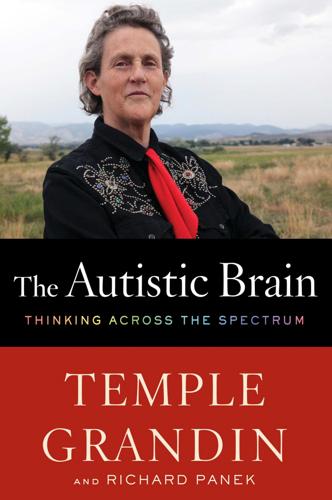
The Autistic Brain: Thinking Across the Spectrum
by
Temple Grandin
and
Richard Panek
Published 15 Feb 2013
The 1987 edition of the DSM also expanded an earlier diagnosis in the PDD category, atypical pervasive developmental disorder, into a catchall diagnosis that covered cases in which the symptoms of autism were milder or in which most but not all symptoms were present: pervasive developmental disorder not otherwise specified (PDD-NOS). The DSM-IV, which was published in 1994, further complicated the definition of autism by adding a new diagnosis altogether: Asperger syndrome. In 1981, the British psychiatrist and physician Lorna Wing had introduced to English-language audiences the work Austrian pediatrician Hans Asperger had done in 1943 and 1944. Even as Kanner was trying to define autism, Asperger was identifying a class of children who shared several distinct behaviors: “a lack of empathy, little ability to form friendships, one-sided conversations, intense absorption in a special interest, and clumsy movements.”
…
He also noted that these children could talk endlessly about their favorite subjects; he dubbed them “little professors.” Asperger called the syndrome “autistic psychopathy,” but Wing felt that because of the unfortunate associations that had attached to the word psychopathy over the years, “the neutral term Asperger syndrome is to be preferred.” This addition to the DSM is important in two ways. The obvious one is that it gave Asperger’s formal recognition by the psychiatric authorities. But when taken together with the PDD-NOS and its autistic-symptoms-but-not-quite-autism diagnostic criteria, Asperger’s was also meaningful in how it changed the way we think about autism in general.
…
But when taken together with the PDD-NOS and its autistic-symptoms-but-not-quite-autism diagnostic criteria, Asperger’s was also meaningful in how it changed the way we think about autism in general. The inclusion of autism in the DSM-III in 1980 was significant for formalizing autism as a diagnosis, while the creation of PDD-NOS in the DSM-III-R in 1987 and the inclusion of Asperger’s in the DSM-IV in 1994 were significant for reframing autism as a spectrum. Asperger syndrome wasn’t technically a form of autism, according to the DSM-IV; it was one of five disorders listed as a PDD, alongside autism disorder, PDD-NOS, Rett syndrome, and childhood disintegrative disorder. But it quickly gained a reputation as “high-functioning autism,” and by the time the revision of the DSM-IV appeared in 2000, diagnosticians were using pervasive developmental disorder and autism spectrum disorder (or ASD) interchangeably.
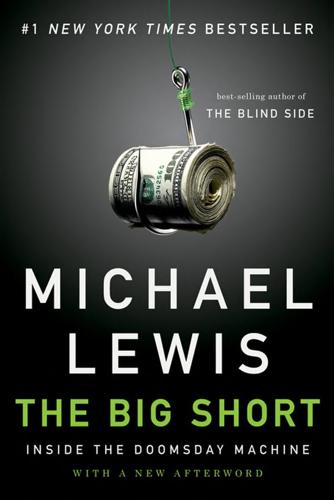
The Big Short: Inside the Doomsday Machine
by
Michael Lewis
Published 1 Nov 2009
Instead, the tests administered by a child psychologist proved that their child had Asperger's syndrome. A classic case, she said, and recommended that the child be pulled from the mainstream and sent to a special school. And Dr. Michael Burry was dumbstruck: He recalled Asperger's from med school, but vaguely. His wife now handed him the stack of books she had accumulated on autism and related disorders. On top were The Complete Guide to Asperger's Syndrome, by a clinical psychologist named Tony Attwood, and Attwood's Asperger's Syndrome: A Guide for Parents and Professionals. "Marked impairment in the use of multiple non-verbal behaviors such as eye-to-eye gaze..."
…
"...One of the reasons why computers are so appealing is not only that you do not have to talk or socialize with them, but that they are logical, consistent and not prone to moods. Thus they are an ideal interest for the person with Asperger's Syndrome..." Check. "Many people have a hobby.... The difference between the normal range and the eccentricity observed in Asperger's Syndrome is that these pursuits are often solitary, idiosyncratic and dominate the person's time and conversation." Check...Check...Check. After a few pages, Michael Burry realized that he was no longer reading about his son but about himself.
…
With them were a handful of government officials--the same government officials who should have known a lot more about what Wall Street firms were doing, back when they were doing it. All shared a distinction: They had proven far less capable of grasping basic truths in the heart of the U.S. financial system than a one-eyed money manager with Asperger's syndrome. By late September 2008 the nation's highest financial official, U.S. Treasury Secretary Henry Paulson, persuaded the U.S. Congress that he needed $700 billion to buy subprime mortgage assets from banks. Thus was born TARP, which stood for Troubled Asset Relief Program. Once handed the money, Paulson abandoned his promised strategy and instead essentially began giving away billions of dollars to Citigroup, Morgan Stanley, Goldman Sachs, and a few others unnaturally selected for survival.
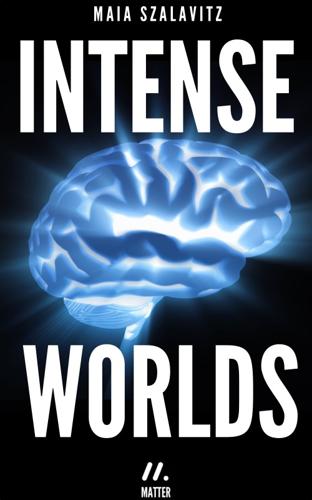
Intense Worlds
by
Maia Szalavitz
Published 11 Dec 2013
Even just trying to go to the movies became an ordeal: Kai would refuse to enter the cinema or hold his hands tightly over his ears. However, Kai also loved to hug people, even strangers, which is one reason it took years to get a diagnosis. That warmth made many experts rule out autism. Only after multiple evaluations was Kai finally diagnosed with Asperger syndrome, a type of autism that includes social difficulties and repetitive behaviors, but not lack of speech or profound intellectual disability. “We went all over the world and had him tested, and everybody had a different interpretation,” Markram says. As a scientist who prizes rigor, this infuriated him.
…
“The overwhelmingness of understanding how people feel can lead to either what is perceived as inappropriate emotional response, or to what is perceived as shutting down, which people see as lack of empathy,” says Emily Willingham. Willingham is a biologist and the mother of an autistic child; she also suspects that she herself has Asperger syndrome. But rather than being emotional, she says, autistic people are “taking it all in like a tsunami of emotion that they feel on behalf of others. Going internal is protective.” At least one study supports this idea, showing that while autistic people score lower on cognitive tests of perspective-taking—recall Anne, Sally, and the missing marble—they are more affected than typical folks by other people’s feelings.
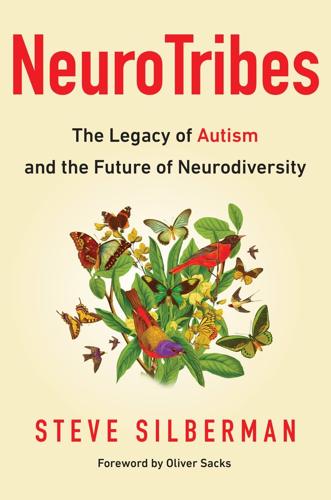
NeuroTribes: The Legacy of Autism and the Future of Neurodiversity
by
Steve Silberman
Published 24 Aug 2015
“virtually unheard of among autistic people”: “Dustin and Me.” more than a million people a year: “Joseph’s Story.” Autism Services Center. http://www.autismservicescenter.org/about/josephs_story CHAPTER 10. PANDORA’S BOX “I have felt like Pandora”: “Past and Future Research on Asperger Syndrome,” Lorna Wing. Asperger Syndrome, A. Klin, F. Volkmar, and S. Sparrow, eds. Guildford Press, 2000, p. 418. “I just didn’t know what the hell to do”: “The Dictionary of Disorder,” Alix Spiegel. New Yorker, Jan. 3, 2005. “Compared to other types of [medical] services there is less clarity”: The Making of DSM-III: A Diagnostic Manual’s Conquest of American Psychiatry, Hannah S.
…
Thankfully I received only a few e-mails like this one: Like many people, I’m starting to get fed up with the multiplication of psychological disorders such as attention deficit disorder and Asperger’s syndrome. In the old days, if you didn’t pay attention in class, you got whacked, and that usually did the trick for many youngsters. I also got a call from a supervisor at Microsoft who told me, “All of my top debuggers have Asperger syndrome. They can hold hundreds of lines of code in their head as a visual image. They look for the flaws in the pattern, and that’s where the bugs are.” At a conference a few months after my article came out, the grandmother of a young girl asked me to sign a copy of my article that had been photocopied so many times that I could barely make out the text.
…
Hedin borrowed a guidebook from the public library, holed up in his ham shack, and earned his First Class Radiotelephone License within six months. He worked behind the scenes in broadcast television for the rest of his life. After discovering that he and his sons were on the spectrum, Hedin joined the Global and Regional Asperger Syndrome Partnership (GRASP), one of the largest support groups for people with autism in the United States. Looking back, he feels certain that a number of hams he knew in the course of fifty-five years of surfing the airwaves would have qualified for a diagnosis. The society of hams also enabled shy introverts to study the protocols of personal engagement from a comfortable distance.
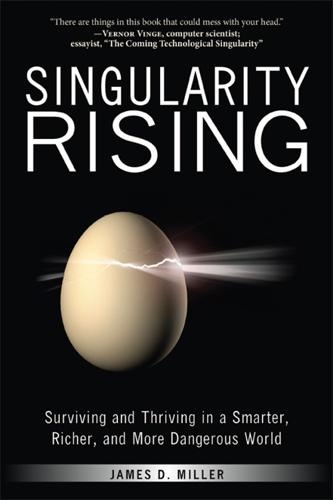
Singularity Rising: Surviving and Thriving in a Smarter, Richer, and More Dangerous World
by
James D. Miller
Published 14 Jun 2012
SELECTING AGAINST CERTAIN TYPES OF INTELLIGENCE Embryo selection against autism would likely reduce the number of geniuses. High-functioning autistics often excel at pattern recognition, a skill vital to success in science and mathematics. Albert Einstein, Isaac Newton, Charles Darwin, and Socrates have all been linked to Asperger syndrome, a disorder (or at least a difference) on the autism spectrum.206 Parents with strong math backgrounds are far more likely to have autistic children, perhaps an indication that having lots of “math genes” makes one susceptible to autism.207 Magnetic resonance imaging has shown that on average, autistic two-year-olds have larger brains than their non-autistic peers do.208 A Korean study found the percentage of autistics who had a superior IQ was greater than that found in the general population.209 Some autistics have an ability called “hyperlexia,” characterized by having average or above-average IQs and word-reading ability well above what would be expected given their ages.
…
Governments could correct a bias against autistic children by paying parents to have them. Although it seems unlikely that the United States would do this, I can easily imagine that Singapore would. Lee Kuan Yew, the former prime minister of Singapore, described his daughter’s child, diagnosed with Asperger syndrome, as being “intellectually normal . . . good-natured and the best-behaved and most likeable of my grandchildren.”214 Technology might soon reduce the social costs of autism. Much human-to-human communication takes place on an unconscious, nonverbal level. Most neurotypicals send nonverbal signals and automatically incorporate the signals they receive into their behavior.
…
I draw this conclusion based on my extensive understanding of autism and my research on von Neumann. Von Neumann’s well-above-average social skills and the pleasure he took from socializing make this an easy determination. 212. Moses (2009). 213. Born on the Wrong Planet (Hammerschmidt 2008) is the title of one book on autism; Right Address . . . Wrong Planet: Children with Asperger Syndrome Becoming Adults (Barn-hill 2002) is the title of another. http://www.wrongplanet.net is the address of a “web community designed for individuals (and parents/professionals of those) with Autism, Asperger’s Syndrome, ADHD, PDDs, and other neurological differences.” 214. Lee (2000). 215. kjmtchl (2010). 216. kjmtchl (2010). 217. kjmtchl (2010). 218. http://www.sociopathworld.com/2009/08/sociopath-voices.html 219.
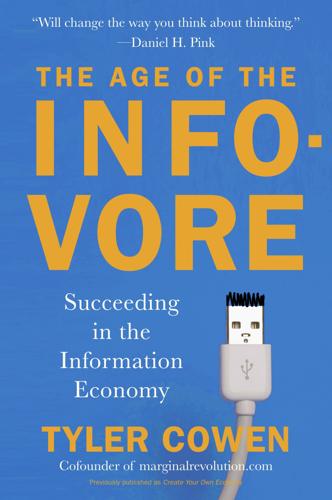
The Age of the Infovore: Succeeding in the Information Economy
by
Tyler Cowen
Published 25 May 2010
FURTHER READING AND REFERENCES CHAPTER 1: THE FUTURE OF THINKING DIFFERENTLY On Mark Donohoo, see “One Man’s Story: When an Autistic Child Grows Up,” April 1, 2008, www.cnn.com/2008/HEALTH/conditions/04/01/autism.jeffs.story/index.html. For the story of Ethan, see Michael D. Powers and Janet Poland, Asperger Syndrome and Your Child: A Parent’s Guide (New York: Collins Living, 2003), chapter 2. To the best of my knowledge, the phrase “infovores” originates with USC professor Irving Biederman. For a good presentation of framing effects, see for instance Richard H. Thaler and Cass R. Sunstein, Nudge: Improving Decisions About Health, Wealth, and Happiness (New Haven: Yale University Press, 2008).
…
On autistics and humor, see Victoria Lyons and Michael Fitzgerald, “Humor in Autism and Asperger’s Syndrome,” Journal of Autism and Developmental Disorders 34, no. 5 (October 2004), 521–31. The Dr. Sandi Chapman quotation can be found in “UTD Docs Use Online World to Treat Form of Autism,” July 9, 2008, cbs11tv.com/local/aspergers.syndrome.treatment.2.767511.html. The Jim Sinclair passage is from “Some Thoughts About Empathy,” web.syr.edu/%7Ejisincla/empathy.htm. Jason Seneca’s words are from his essay “An Aspie’s Guide to Everyone Else,” in Voices of Autism: The Healing Companion: Stories for Courage, Comfort and Strength, edited by The Healing Project (New York: LaChance Publishing, 2008), 113–18; see p. 117.
…
Pring, “Can children with autistic spectrum disorders perceive affect in music? An experimental investigation,” Psychological Medicine 29, no. 6 (1999), 1405–10. See Rebecca Delaney, “Music critic describes life with Asperger’s syndrome,” Columbia Missourian, March 13, 2008, www.columbiamissourian.com/stories/2008/03/13/music-critic-describes-life-wth-aspergers-syndrome/. On Oe, see Lindsley Cameron, The Music of Light: The Extrarodinary Story of Hikari and Kenzaburo Oe (New York: The Free Press, 1998). The quotation from the critic is on p. 125. On cognition and atonal music, see for instance Diana Raffman, “Is Twelve-Tone Music Artistically Defective?” Midwest Studies in Philosophy (2003), 69–87, and the literature surveyed therein.
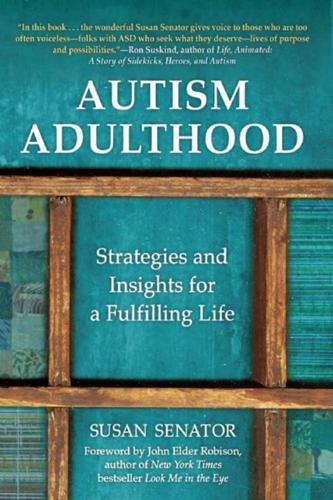
Autism Adulthood: Strategies and Insights for a Fulfilling Life
by
Susan Senator
Published 4 Apr 2016
• Growing Up on the Spectrum: A Guide to Life, Love, and Learning for Teens and Young Adults with Autism and Asperger’s, by Claire S. LaZebnik (Penguin, 2009). • Decoding Dating: A Guide to the Unwritten Social Rules of Dating for Men With Asperger Syndrome (Autism Spectrum Disorder), by John Miller (Jessica Kingsley, 2014). • Autism and Its Medical Management, by Michael Chez MD (Jessica Kingsley, 2009). • Living Well on the Spectrum: How to Use Your Strengths to Meet the Challenges of Asperger Syndrome/High-Functioning Autism, by Valerie L. Gaus, PhD (Guilford Press, 2007). • Living Independently on the Autism Spectrum: What You Need to Know to Move into a Place of Your Own, Succeed at Work, Start a Relationship, Stay Safe, and Enjoy Life as an Adult on the Autism Spectrum, by Lynne Soraya (Adams Media, 2013)
…
(www.massadvocates.org/mac-victory-autism-omnibus-bill) Hopefully other states will follow, and then we have to hope that along with the legislation, there will be funds appropriated to implement it. Through the Autism-Asperger’s Association of New England (AANE), Scott discovered the LifeMAP (Life Management Assistance Program) program, which led to finding his life coach. The AANE website describes LifeMAP as follows: LifeMAP provides practical assistance to individuals with Asperger Syndrome (AS) and related conditions. LifeMAP provides intensive, highly individualized coaching by professionals with expertise in both AS and specific content areas. Coaches focus on identifying and overcoming the specific barriers each client faces so that the clients can increase their levels of independence towards reaching their full potential.
…
(Autism Asperger Publishing Company, 2008). • Lynn Kern Koegel and Claire S. LaZebnik, Growing Up on the Spectrum: A Guide to Life, Love, and Learning for Teens and young Adults with Autism and Asperger’s (Penguin, 2009). • John Miller, Decoding Dating: A Guide to the Unwritten Social Rules of Dating for Men with Asperger Syndrome (Autism Spectrum Disorder) (Jessica Kingsley, 2014). • Haley Moss, A Freshman Survival Guide For College Students with Autism Spectrum Disorders (Jessica Kingsley, 2014). • Valerie Paradiz, The Integrated Self-Advocacy ISA™ Curriculum: A Program for Emerging Self-Advocates with Autism Spectrum and Other Conditions.

Free as in Freedom
by
Sam Williams
Published 16 Nov 2015
[He was] very knowledgeable but also very hardheaded in some ways." 28 Such descriptions give rise to speculation: are judgment-laden adjectives like "intense" and "hardheaded" simply a way to describe traits that today might be categorized under juvenile behavioral disorder? A December, 2001, Wired magazine article titled "The Geek Syndrome" paints the portrait of several scientifically gifted children diagnosed with high-functioning autism or Asperger Syndrome. In many ways, the parental recollections recorded in the Wired article are eerily similar to the ones offered by Lippman. Even Stallman has indulged in psychiatric revisionism from time to time. During a 2000 profile for the Toronto Star, Stallman described himself to an interviewer as "borderline autistic,"See Judy Steed, Toronto Star, BUSINESS, (October 9, 2000): C03.
…
Stallman considers himself afflicted, to some degree, by autism: a condition that, he says, makes it difficult for him to interact with people. a description that goes a long way toward explaining a lifelong tendency toward social and emotional isolation and the equally lifelong effort to overcome it. Such speculation benefits from the fast and loose nature of most socalled " behavioral disorders" nowadays, of course. As Steve Silberman, author of " The Geek Syndrome," notes, American psychiatrists have only recently come to accept Asperger Syndrome as a valid umbrella term covering a wide set of behavioral traits. The traits range from poor motor skills and poor socialization to high intelligence and an almost obsessive affinity for numbers, computers, and ordered systems.See Steve Silberman, "The Geek Syndrome," Wired (December, 2001).
…
Watch the Stallman gaze for an extended period of time, and you will begin to notice a subtle change. What appears at first to be an attempt to intimidate or hypnotize reveals itself upon second and third viewing as a frustrated attempt to build and maintain contact. If, as Stallman himself has suspected from time to time, his personality is the product of autism or Asperger Syndrome, his eyes certainly confirm the diagnosis. Even at their most high-beam level of intensity, they have a tendency to grow cloudy and distant, like the eyes of a wounded animal preparing to give up the ghost. My own first encounter with the legendary Stallman gaze dates back to the March, 1999, LinuxWorld Convention and Expo in San Jose, California.
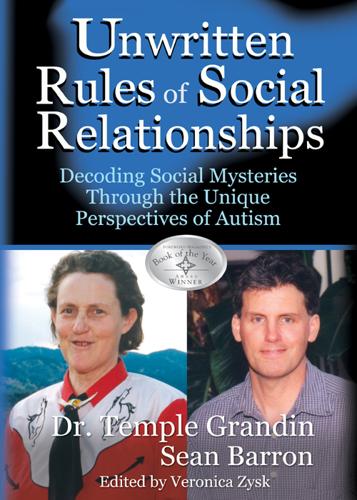
The Unwritten Rules of Social Relationships: Decoding Social Mysteries Through the Unique Perspectives of Autism
by
Temple Grandin
and
Sean Barron
Published 30 Sep 2012
“Learning Social Rules.” Autism Asperger’s Digest magazine. January-February 2005. Grandin, T. & Duffy, K. (2004). Developing Talents: Careers for Individuals with Asperger Syndrome and High-Functioning Autism. Shawnee Mission, KS: Autism Asperger’s Publishing Company. Grant, K. (2005). Private email communication. Katz, I., Yellen, A. (2000). Social Facilitation in Action. West Hills, CA: Real Life Story Books. Meyer, R., Root, A., Newland, L. (2003). “Asperger Syndrome Grows Up: Recognizing AS Adults in Today’s Challenging World.” From the website: www.aspires-relationships.com. Miller, B.L. (1998). “Emergence of Art Talent in Frontal Temporal Dementia.”
…
The stress can be so severe as to be immobilizing for them, which reinforces the need for parents and teachers to clearly distinguish honesty/lying from being courteous and diplomatic in situations involving other people. Patricia Rakovic, a speech/language therapist in Rhode Island, has been running a social skills group for boys with Aspergers Syndrome for several years now within one of the school districts in the state. The students range in age from twelve to fifteen, and the group includes typical peers. In developing material for this chapter of the book, we asked her to query her students on the subject of honesty. As an experiment, she broke the group into AS students and non-AS students and individually asked each group their opinions on the subject of honesty, telling the truth, white lies, etc.
…
References Aron, A., Fisher, H., Mashek, D.J., Strong, G., Li, H., Brown, L.L. (2005). “Reward, motivation and emotion systems associated with early-stage intense romantic love.” Journal of Neurophysiology, 94: 327-337. Baron-Cohen, S. (1995). Mindblindness: An Essay on Autism and Theory of Mind. Cambridge, MA: The MIT Press. Bolick, T. (2001). Asperger Syndrome and Adolescence: Helping Preteens and Teens Get Ready for the Real World. Gloucester, MA: Fair Winds Press. Courchesne, E. et al. (2004). “The Autistic Brain: Birth Through Adulthood.” Current Opinion in Neurology. Vol. 17: pp. 489-496. Grandin, T. (1999). “Social Problems: Understanding Emotions and Developing Talents.”
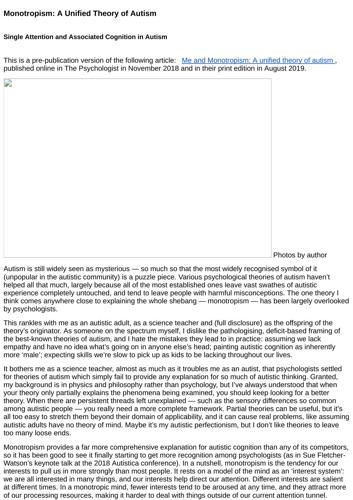
Monotropism: A Unified Theory of Autism
by
Unknown
My hope is that in a few years psychologists will look back at the fragmentary accounts they have been working with, and wonder why it all seemed such a puzzle for so long. But I’m not a psychologist, I’m just an autistic schoolteacher; perhaps you should take what I say with a grain of salt. References Beardon, L. (2017). Autism and Asperger Syndrome in Adults. Chown, N. (2016). Understanding and evaluating autism theory . Jessica Kingsley Publishers. Chown N., Beardon L. (2017) Autism Theory. In: Volkmar F. (eds) Encyclopedia of Autism Spectrum Disorders. Springer, New York, NY Fletcher-Watson, S., Adams, J., Brook, K., Charman, T., Crane, L., Cusack, J., … & Pellicano, E. (2018).
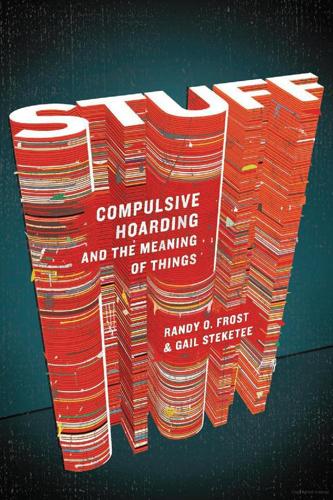
Stuff: Compulsive Hoarding and the Meaning of Things
by
Gail Steketee
and
Randy Frost
Published 19 Apr 2010
Amy For the first five years of her life, Amy lived with an abusive and neglectful mother who suffered from a host of problems, including alcohol and drug addiction, OCD, and AIDS. Both Amy and her younger sister were in and out of foster placements until they landed at the home of Krystal and her husband. Krystal's household contained a mixture of foster, adopted, and biological children, many suffering from various disorders, including Asperger's syndrome, attention deficit hyperactivity disorder (ADHD), Tourette's syndrome, and OCD. Amy and her younger sister arrived as foster children and were adopted by Krystal and her husband within two years. Krystal was a very bright and capable woman who seemed undaunted by the problems in her brood. She spoke of them all lovingly, without minimizing the significance of the problems they faced.
…
But it was one the parents could control with some clear rules and careful planning. Perhaps parents' ability to control this problem explains why so few clinicians have seen hoarding in children. When kids are brought to therapists for help, it is usually for other problems, such as OCD, ADHD, or Asperger's syndrome. Hoarding is often not mentioned at all. In addition, mental health clinics do not ask questions about clutter and saving possessions as part of their routine diagnostic interviews. Julian's hoarding was episodic and seemed to occur mostly when he was upset about something—such as his broken arm or his new math class.
…
Rufer, M., Grothusen, A., MaB, R., Peter, H., & Hand, I. (2005). Temporal stability of symptom dimensions in adult patients with obsessive-compulsive disorder. Journal of Affective Disorders, 88, 99–102. Russell, A. J., Mataix-Cols, D., Anson, M., & Murphy, D.G.M. (2005). Obsessions and compulsions in Asperger syndrome and high-functioning autism. British Journal of Psychiatry, 186, 525–528. Storch, E. A., Lack, C. W., Merlo, L. J., Geffken, G. R., Jacob, M. L., Murphy, T. K., et al. (2007). Clinical features of children and adolescents with obsessive-compulsive disorder and hoarding symptoms. Comprehensive Psychiatry, 48, 313–318.
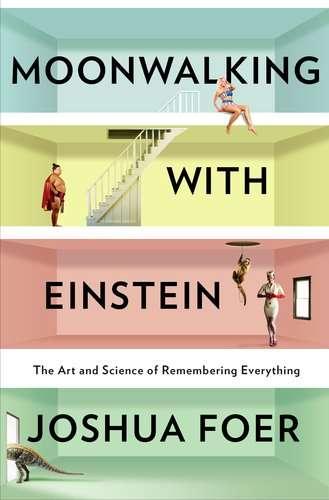
Moonwalking With Einstein
by
Joshua Foer
Published 3 Mar 2011
It includes a caveat: “As in all cases like this we need to consider the fact that Arithmos may be performing almost all of his ‘mental feats’ via pure memorization.” 230 they didn’t find this: D. Bor, J. Bilington, and S. Baron-Cohen (2007), “Savant memory for digits in a case of synaesthesia and Asperger syndrome is related to hyperactivity in the lateral prefrontal cortex.” Neurocase 13, 311-319. BIBLIOGRAPHY Baddeley, A. D. (2006). Essentials of human memory. Hove, East Sussex, UK: Psychology Press. Barlow, F. (1952). Mental prodigies: an enquiry into the faculties of arithmetical, chess and musical prodigies, famous memorizers, precocious children and the like, with numerous examples of “lightning” calculations and mental magic.
…
Mental prodigies: an enquiry into the faculties of arithmetical, chess and musical prodigies, famous memorizers, precocious children and the like, with numerous examples of “lightning” calculations and mental magic. New York: Philosophical Library. Baron-Cohen, S., Bor, D., Wheelwright, S., Ashwin, C. (2007). Savant Memory in a Man with Colour Form-Number Synaesthesia and Asperger Syndrome. Journal of Consciousness Studies, 14(9-10), 237-251. Batchen, G. (2004). Forget me not: photography remembrance. New York: Princeton Architectural Press. Battles, M. (2003). Library: an unquiet history. New York: W.W. Norton. Beam, C. A., Conant, E. F., Sickles, E. A. (2003). Association of Volume and Volume-Independent Factors with Accuracy in Screening Mammogram Interpretation.
…
The gallery of memory: literary and iconographic models in the age of the printing press. Toronto: University of Toronto Press. Bolzoni, L. (2004). The web of images: vernacular preaching from its origins to Saint Bernardino of Siena. Aldershot, Hants, England: Ashgate. Bor, D., Billington, J., Baron-Cohen, S. (2007). Savant memory for digits in a case of synaesthesia and Asperger syndrome is related to hyperactivity in the lateral prefrontal cortex. Neurocase, 13(5-6), 311-319. Bourtchouladze, R. (2002). Memories are made of this: how memory works in humans and animals. New York: Columbia University Press. Brady, T. F., Konkle, T., Alvarez, G. A., Oliva, A. (2008). Visual Long-Term Memory Has a Massive Storage Capacity for Oject Details.
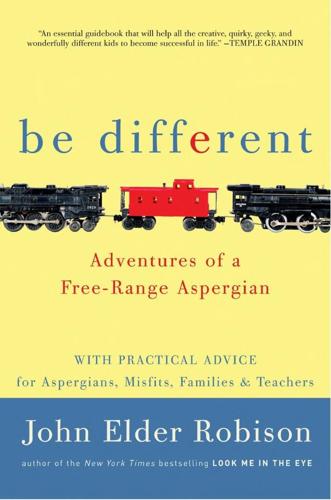
Be Different: Adventures of a Free-Range Aspergian With Practical Advice for Aspergians, Misfits, Families & Teachers
by
John Elder Robison
Published 22 Mar 2011
A list of local and regional chapters can be found on the national website, which is www.autism-society.org. In New England we are fortunate to have the Asperger’s Association of New England, online at www.aane.org. It runs support groups and seminars, and has an excellent annual conference. The Global Regional Asperger Syndrome Partnership (www.grasp.org) sponsors support groups all over the country, with special emphasis on New York. On Long Island, I admire the work of Pat Schissel and AHA. Find them at www.ahany.org. In the Philadelphia area I like the ASCEND Group, online at www.ascendgroup.org. Movies In the introduction to this book, I mention the documentary film Billy the Kid.
…
And there is The Curious Incident of the Dog in the Night-Time by Mark Haddon. In addition, these lesser-known books may be of help to you: Atypical: Life with Asperger’s in 20⅓ Chapters by Jesse A. Saperstein, a young Aspergian Asperger’s from the Inside Out by GRASP founder Michael John Carley Freaks, Geeks, and Asperger Syndrome: A User Guide to Adolescence by Luke Jackson Of Mice and Aliens: An Asperger Adventure (Asperger Adventures) by Kathy Hoopmann Blue Bottle Mystery: An Asperger Adventure (Asperger Adventures) by Kathy Hoopmann Everybody Is Different: A Book for Young People Who Have Brothers or Sisters with Autism by Fiona Bleach Parallel Play by Tim Page Songs of the Gorilla Nation by Dawn Prince-Hughes, Ph.D.
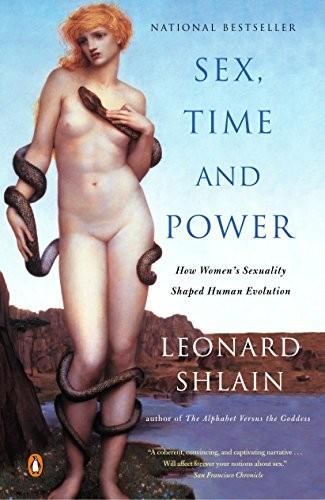
Sex, Time, and Power: How Women's Sexuality Shaped Human Evolution
by
Leonard Shlain
Published 2 Aug 2004
Schizophrenia, autism, and the latter’s milder form, Asperger syndrome, are psychiatric conditions in which the individual, most commonly a male, seems to be missing the part of his nervous system that promotes healthy human relationships.* Someone afflicted with autism prefers to be alone, lacks empathy, and displays a single-minded pursuit of solitary interests. Men with these conditions can be characterized as having a very weak anima, and they would generally cluster at the opposite end of the curve from gay men. In general, habitual criminals have too much animus, and autistic men and those diagnosed with Asperger syndrome have too little anima.
…
The male bell-shaped anima-animus distribution curve is therefore flatter and wider than the female one, resulting in greater numbers of individuals who exist out at either extreme. There are more gays than lesbians. There are more male psychopaths than female psychopaths. There are more autistic and schizophrenic men than there are autistic and schizophrenic women. Asperger syndrome afflicts approximately one male in three hundred. It is exceedingly rare in females. When the two male extremes are compared with all other species, certain aspects are thrown into sharp relief. The behavior humans attribute to rapists and murderers is exceptionally rare among wild animals. So, too, are behaviors consistent with the symptoms of autism and schizophrenia.
…
Aborigines, 302, 383n abortion, 31 abstract thinking, 263 Aché tribe, 112 adolescence, see menarche; puberty adolescent subfertility, 138 African Eve, 6–7, 11–12, 76, 80, 118, 336, 364 afterbirth, 29, 29n afterlife, 277–78, 375n Ahlquist, Jon, 371n AIDS epidemic, 236–37, 273 Aiello, Leslie, 41n, 242–43, 243n Alexander, Richard, 48 altruism, 242 American Journal of Obstetrics and Gynecology, 79 American Psychiatric Association, 232 Amini, Fari, 321, 331 amino acids, 123–24, 127, 128, 133, 262, 364 ancestor worship, 279 anemia, ix–x, xn, 43, 133, 152, 152n, 363 effects of, 26 hookworm infection and, 35 menstruation and, 35 vegetarian diet and, 41 vitamin C and, 132 Angier, Natalie, 88 anima-animus duality, 209–25, 210, 257 as cultural behavior, 216–17 double helix and, 258 homosexuality and, 232–35, 243 hormones and, 211–12 male-female relationship and, 217–19, 222–25 in nonhumans, 214–15 rarity of rape and, 220–22 as sexual strategy, 217–20 small talk and, 222–23 testosterone and, 211–12, 215 Antigone (Sophocles), 255 anxiety, 281 death and, 264, 266–67 superstition and, 276–77 Aquatic Ape Theory, 104, 194n Aquinas, Saint Thomas, 339 Ardrey, Robert, 103 Aristophanes, 224, 225, 321 Aristotle, 244, 339 art, 362, 368 Creative Explosion in, 269, 269n, 287, 300, 383n and fear of death, 272, 275, 286 homosexuality and, 243–44 Madonna theme in, 384n reductionism and, 263 ascorbic acid, see vitamin C Asperger syndrome, 233–34, 234n Atwood, Margaret, 205 auditory constancy, 196–97 Augustine, Saint, 339, 375n Australia, species extinction in, 251n Australopithecus afarensis, 107–8 autism, 233–34 Bacon, Francis, 339 Baker, Josephine, 254 Baker, Robin, 72, 304n balanitis, 89 baldness, 242, 246, 248–53 brain and, 250–51 barter, 285–86, 285n Batak tribe, 302 Batten, Mary, 117, 289 beauty, 353, 356 Beauvoir, Simone de, 341 Becker, Ernest, 265, 266–67 Bellis, Mark, 72, 304n Bellow, Saul, 335 Benedek, Therese, 153 Benshoof, L., 51 Bernard, Claude, 149 Bettelheim, Bruno, 143n Bickerton, Derek, 191, 363 Biogenetic Law, 270, 299 bipedalism, 58, 197 childbirth and, 4–5, 8n evolution of, 3–4 hunting and, 103–4, 107, 251–52 lunar cycles and, 175–76 male genitalia and, 221 menstruation and, 175–76 orgasm and, 71–72 Pole Ax Theory of Orgasm and, 71–72 Sentinel Behavior Theory of, 251–52 birth control, 363 birth defects, 312 bisexuality, 233, 236 Blackfoot Indians, 96 Blood, Bread, and Roses (Grahn), 58 bloodletting practice, 342n–43n Blood Relations (Knight), 55, 111–12 Bloom, Paul, 190 Boas, Franz, 179 Bodger, Joan, 80–81 bonobos (Pan paniscus), 16n, 17n, 46, 50, 52n, 53, 105, 128n, 135 Bororo tribe, 112 Bowlby, John, 15 brain, xn, xi, 41, 170, 228, 336 baldness and, 250–51 Broca’s area of, 195, 195n cholesterol in, 126–28 evolution of enlarged, 4, 12, 19 Executive Function of, 145, 145n, 150 and exercise of free will, 19 iron and development of, 26 language and, 196–97 of left-handed persons, 247 lipoproteins in, 125, 125n metabolic demands of, 13 myelination of, 143–46 structure of, 144–45 triune, 143–44 breast-feeding, 29–30, 32, 342 “love hormone” and, 82 orgasm and, 82 Bribri Indians, 64 bride-barter, 313–17, 313n culture and, 314–16 women as commodity in, 314 women’s power and, 317–19 Briffault, Robert, 180 Broca’s area, 195, 195n Brooks, Mel, 281 Brown, Norman O., 303–4 Brownmiller, Susan, 220 Bruner, Ann, 128n Buddha, 340, 375n Buddhism, 361, 375n Burley, Nancy, 49 Butler, Samuel, 167 caduceus, 255, 258 calendars, 378n–80n Calvin, John, 339 Calvin, William, 190–91 Camus, Albert, 282–83 Canetti, Elias, 316n cannibalism, 36 Cannon, Walter, 157 carbohydrates, 122 carbon dioxide, 195n “Carmina” (Horace), 284 Carroll, Lewis, xiiin, 73 Cassatt, Mary, 254 Cather, Willa, 254 cause-and-effect logic, 263 Cavilla-Sforza, Luigi Luca, 371n cellulite, 355n cervix, 61, 61, 73, 156 chelation, process of, 40 childbirth, 12 bipedalism and, 4–5 as bottleneck in human evolution, 5–8 G spot and pain of, 79–80 iron depletion in, 27–28, 28n orgasm in, 75, 80–81 childhood, prolonged, 5, 8n chimpanzees (Pan troglodytes), xi, 29, 41, 46, 49, 50, 53, 111n, 128n, 135, 152n, 275n, 276, 353 awareness of death in, 265–66, 265n genes of, 7, 11 grooming in, 213 homosexuality in, 230 hunting by, 101, 105 language capacity of, 189–90 laughter in, 281n mating competition and, 159–60 mating patterns in, 356, 356n menopause in, 87 menstruation in, 138 orgasm in, 70 self-awareness in, 169 chlorophyll, 39–40 cholesterol: in brain, 126–28 male sex drive and, 127 sex hormones and, 126–27 Chomsky, Noam, 190 Christiansen, Morton, 191 chromosomes, 24 X, 228, 244 Y, 228, 371n Chukchi tribe, 301–2 circadian rhythms, 171–73 circumcision, 88–94, 94n, 374n fertility and, 92–93 and function of foreskin, 90 health benefits of, 89–91 male sexuality and, 92–93 orgasm and, 92–93 religion and, 374n–76n Civilization and Its Discontents (Freud), xi Cleopatra, Queen of Egypt, 376n clitoris, 79, 228 Coleridge, Samuel Taylor, 258 collagen, 135 color-blindness, 241, 244–45, 253, 253n Columbus, Christopher, 89 Comfort, Alex, 45 commerce, 316 commitment, 328–29 complete blood count (CBC), vii–viii, xi Confucius, 340 Congo tribe, 180 Congreve, William, 203 Conkey, Margaret, 269n Constitution, U.S., 316n Coolidge Effect, 75 Corballis, Michael, 191 Cortés, Hernán, 280 cortisol, 230 cosmetics, 351, 352–54 Cosmides, Leda, 17n, 190 courtship, 324–25, 327 Crack in the Teacup, The (Bodger), 80–81 Crawford, Michael, 40, 125, 125n, 252 Creative Explosion: death and, 269, 271 language and, 300–301, 300n mutation and, 383n synchronous development of, 301 Crick, Francis, 258 Cro-Magnons, 290, 290n, 383n daddy-at-home theory of, 48 infanticide and, 49–51 jealousy and, 51–52 many fathers theory of, 49 cryptic ovulation (cont.)
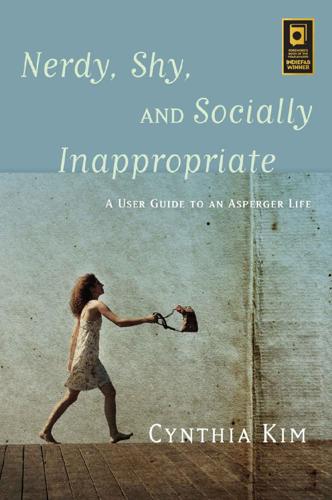
Nerdy, Shy, and Socially Inappropriate
by
Cynthia Kim
Published 20 Sep 2014
—Lynne Soraya, blogger for Psychology Today and author of Living Independently on the Autism Spectrum of related interest Pretending to be Normal Living with Asperger’s Syndrome (Autism Spectrum Disorder) 2nd Edition Liane Holliday Willey ISBN 978 1 84905 755 4 eISBN 978 0 85700 987 6 Aspergirls Empowering Females with Asperger Syndrome Rudy Simone Foreword by Liane Holliday Willey ISBN 978 1 84905 826 1 eISBN 978 0 85700 289 1 Been There. Done That. Try This! An Aspie’s Guide to Life on Earth Edited by Tony Attwood, Craig R. Evans and Anita Lesko ISBN 978 1 84905 964 0 eISBN 978 0 85700 871 8 Nerdy, Shy, AND Socially Inappropriate A USER GUIDE TO AN ASPERGER LIFE CYNTHIA KIM Jessica Kingsley Publishers London and Philadelphia First published in 2015 by Jessica Kingsley Publishers 73 Collier Street London N1 9BE, UK and 400 Market Street, Suite 400 Philadelphia, PA 19106, USA www.jkp.com Copyright © Cynthia Kim 2015 All rights reserved.
…
It also means that I’ve been called cold, selfish, and mean when what I was feeling was overwhelmed, confused, or frightened. The dual challenges of impaired perspective taking and impaired emotional awareness have made emotional connection one of the most difficult aspects of relating to others. 1.Rogers, K., Dziobek, I. et al. (2007) “Who cares? Revisiting empathy in Asperger Syndrome.” Journal of Autism and Developmental Disorders 37, 709–715. 10 Executive Function THE BRAIN’S CONTROL CENTER When I was in middle school, I spent a week visiting my college-age cousin in Brooklyn. It all felt very grown-up, with her living in the studio apartment she shared with a roommate and me on my first extended trip away from home.
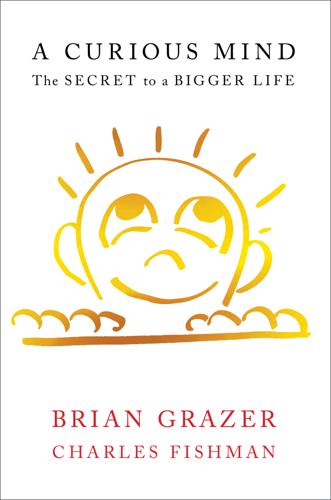
A Curious Mind: The Secret to a Bigger Life
by
Brian Grazer
and
Charles Fishman
Published 6 Apr 2014
Mullany: former special agent for the FBI, pioneered FBI’s offender profiling Kary Mullis: biochemist, Nobel laureate in chemistry for his work with DNA Takashi Murakami: artist, painter, sculptor Blake Mycoskie: entrepreneur, philanthropist, founder and chief shoe giver of TOMS shoes Nathan Myhrvold: former chief technology officer at Microsoft Ed Needham: former managing editor of Rolling Stone and editor in chief of Maxim Sara Nelson: cofounder of the public interest law firm Christic Institute Benjamin Netanyahu: prime minister of Israel Jack Newfield: journalist, author, former columnist for the Village Voice Nobuyuki “Nobu” Matsuhisa: chef and restaurateur Peggy Noonan: speechwriter and special assistant to President Ronald Reagan, author, columnist for the Wall Street Journal Anthony Norvell: expert on metaphysics, author Barack Obama: president of the United States, former U.S. senator from Illinois ODB: musician, music producer, founding member of Wu-Tang Clan Richard Oldenburg: former director of the Museum of Modern Art, New York City Mary-Kate and Ashley Olsen: actresses, fashion designers Olu Dara & Jim Dickinson: musicians, record producers Estevan Oriol: photographer whose work often depicts Los Angeles urban and gang culture Lawrence Osborne: journalist, author of American Normal: The Hidden World of Asperger Syndrome Manny Pacquiao: professional boxer, first eight-division world champion David Pagel: art critic, author, curator, professor of art history at Claremont College specializing in contemporary art Anthony Pellicano: high-profile private investigator in Los Angeles Robert Pelton: conflict-zone journalist, author of The World’s Most Dangerous Places books Andy Pemberton: former editor in chief of Blender magazine David Petraeus: director of the CIA, 2011–2012, retired four-star U.S.
…
Abrahamson, Joan, 154–55 Academy Awards, 107–8, 139, 165, 177 accountability and curiosity, 182 and democracy, 183–84 action, taking, 9, 129, 149 See also: doing nothing actors: characteristics of great, 140–41 Adam and Eve story, 11–13 advertising executives: curiosity of, 94 Affleck, Ben, 90 Allen, Herbert A., 117 Allende, Salvador, 70 Allred, Gloria, 53 American dream: Imagine movies about, 167–68 American Gangster (movie), 6, 36, 77, 167–68, 169 Andersen, Hans Christian, 104 animals: curiosity of, 6–7 answers to questions: and familiarity as enemy of curiosity, 159 paying attention to, 9 purpose of, 152 and questioning culture, 152 “right,” 146–52 surprising, 63–67 See also: listening anti-curiosity and Cry-Baby movie, 173–74 definition of, 170 of Grazer, 172–74 and “making the case,” 170, 171 need for, 169–85 and “no,” 170–71, 172–73 and when to be anti-curious, 175 and when not to be curious, 173–75 Apollo 13 (movie): and curiosity as shared knowledge, 82 and curiosity as storytelling, 35–36 Hanks’s role in, 148 as Howard-Grazer production, 31 influence of Grazer’s early career on, 6 London showing of, 226–29 Lovell-Grazer curiosity conversation and, 24 reality and, 78 “right” version of, 148 as story of real people, 164 which parts are true, 279 White House screening of, 129–31 See also: Lovell, Jim archiving results of curiosity, 198–99 Arrested Development (TV show), 79, 119 art: of Jeff Koons, 219–21 and Grazer’s interest in painting, 124 artistic curiosity, 199 Ashley, Ted, 17 Asimov, Isaac, 23, 97–100, 110, 281 Asimov, Janet Jeppson, 99, 110, 281 Aspen Ideas Festival: Koons-Grazer meeting at, 221 Asperger Syndrome: and Grazer’s curiosity on behalf of Riley, 162 audience expectations, 112 autonomy: curiosity and, 192 Avco Theater (Los Angeles): Cry-Baby at, 218 Splash at, 108, 218 Backdraft (movie), 31, 45, 128 Bailey, F. Lee, 26–28, 73 Baldridge, Letitia, 87–88, 90, 91 baseball: McCain-Grazer conversation about, 208 baseball cap: as Grazer’s gift to Bush (George W.), 212–13 Beastie Boys, 48 Beatty, Warren, 5, 106 A Beautiful Mind (movie), 6, 31, 45, 119, 148, 163–66, 168 A Beautiful Mind (Nasar), 163, 164 bee-car story, 187–88, 190–91, 285 Bel-Air Hotel (Los Angeles): Oprah-Grazer conversation at, 225–26 Benedict, Barbara, 13, 194–95, 196 Berle, Milton, 217 Bible: Adam and Eve story in, 11–13 Asimov’s literary guides to, 98 bin Laden, Osama, 49 Blatty, William Peter, 5 Blue Crush (movie), 124 Blue sky question, 274–75 Boredom, curiosity as cure, 1 Boseman, Chad, 137 “boss”: asking questions of, 150 in entertainment industry, 141 at Imagine Entertainment, 127–32 using curiosity as, 134–37, 139–43, 144–50 boxing: Mailer-Grazer conversation about, 221–23 Braddock, James J., 207, 221, 222 bravery: curiosity and, 97, 124, 169, 191 Brin, Sergey, 146, 147 Brolin, Josh, 93 Bronfman, Clarissa, 131 Bronfman, Edgar Jr., 128–29, 130, 131 Brown, Brené, 127, 283–84 Brown, James, 101, 137–39, 149 See also: Get On Up Brown, Paul, 57, 278 Bush, George H.W., 42, 276 Bush, George W., 205, 207, 209, 212–13, 221 Calley, John, 17, 18–19, 20, 21, 28, 275 Cameron, James, 178 Captain Phillips (movie), 78 car-bee story, 187–88, 190–91, 284–85 car cup holders, 55, 278 Carrey, Jim, 28, 45, 110, 111, 176 Cartel (movie script), 93–94 Carter, Graydon, 125–26, 163, 203, 206 Casey, Bill, 49 Castro, Fidel, 126, 202–6 CBS, 125, 203, 204, 274–75 Charles (British prince), 226 children: curiosity of, 3, 7, 10–11, 193 and Dr.
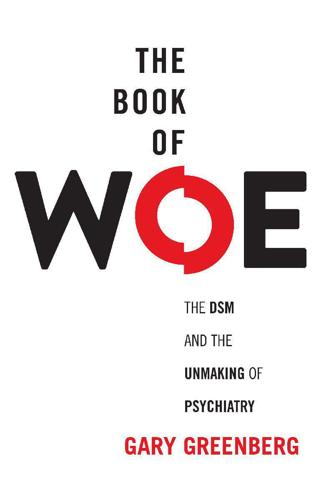
The Book of Woe: The DSM and the Unmaking of Psychiatry
by
Gary Greenberg
Published 1 May 2013
That’s a skill Carley has put to a different use since he got his diagnosis. Shortly after his visit with the psychiatrist, he took over a loose network of Asperger’s support groups in New York, and in 2003, he used his NGO savvy and his forceful personality to wangle money from the Fund for Social Change and turn the network into GRASP, the Global and Regional Asperger Syndrome Partnership, the largest organization for adolescents and adults with Asperger’s. Like AANE, Nomi Kaim’s group, GRASP works to provide patients and their families with information and resources. But Carley has a larger agenda, captured in GRASP’s mission statement. At GRASP we envision a world14 where all individuals on the autism spectrum are respected, valued, and fairly represented; where appropriate supports and services are readily available to those in need; and where people on the spectrum are empowered to participate in policy and personal decisions that affect their lives.
…
“There has never been an agenda”: Debra Brauser, “Concern over Changes to Autism Criteria Unfounded,” Medscape Medical News, January 25, 2012. 7. “10,000 plus e-mails”: This exchange, not reported in the press, is available at http://grasp.org/profiles/blogs/dsm-5-update-a-poor-poor-descent-into-pettiness. 8. a Carey-penned DSM piece: Benedict Carey, “Grief Could Join List of Disorders,” The New York Times, January 24, 2012. 9. a World Psychiatry article by Jerry Wakefield and Michael First: Wakefield and First, “Validity of the Bereavement Exclusion to Major Depression: Does the Empirical Evidence Support the Proposal to Eliminate the Exclusion in DSM-5?” 10. “set out realistic expectations”: Kraemer et al., “DSM-5: How Reliable Is Reliable Enough?,” 13. 11. a pair of op-ed columns: Paul Steinberg, “Asperger’s History of Overdiagnosis,” and Benjamin Nugent, “I Had Asperger Syndrome, Briefly,” The New York Times, January 31, 2012. 12. “The proposals in DSM-5”: See “Psychologists Fear US Manual Will Widen Mental Illness Diagnosis,” The Guardian, February 9, 2012. 13. The Lancet . . . in a single issue, a report: See http://www.thelancet.com/journals/lancet/issue/vol379no9816/PIIS0140-6736%2812%29X6007-0. 14.
…
See also Feeding and Eating Disorders Food and Drug Administration (FDA), 48, 73, 84, 98 Foucault, Michel, 19 Frances, Allen, 22, 26, 44–48, 93–95, 119, 148, 167, 190, 230–38, 246, 248, 274–81, 301, 304–9, 330, 332–34, 344, 346–47, 350, 352 articles and blogs on DSM by, 105–9, 111, 120, 123, 127, 130–31, 133, 136–40, 142–44, 155–57, 165, 179, 215, 300, 307, 328–29, 331, 339, 361–63 Chapman and, 293–94 Columbia medical school presentation by, 138–39, 146, 168 in documentary film, 331–33 DSM-IV task force chaired by, 22–23, 47–48, 76, 95–96, 98–99, 106–8, 118, 132, 140, 144–45, 147, 171, 180, 202, 234–38, 264, 271, 314, 332 e-mails to APA leadership from, 209–10 Harvard bioethics seminar address of, 331, 334–35 Kraemer’s broadside against, 311–12 letter to APA trustees from Spitzer and, 109–10 open letters to APA from, 275–76, 306–7 at party for Columbia-affiliated psychiatrists, 95–99, 105 on personality disorders, 262–64, 267, 270 on primary care doctors’ treating mental disorders, 349, 353 Regier’s denunciations of, 173–74, 296 and revision of DSM-III, 44–48, 262–63 at Spitzer’s retirement celebration, 168–69 Frances, Vera, 93–94 Frankfurt, Harry, 24, 134, 317 Freud, Sigmund, 16–18, 24, 30, 31, 35, 38, 53, 91, 111, 120, 145, 168, 197, 262, 272, 347 Freudianism, 34, 39, 41, 50, 58, 62, 123, 261–63, 284, 330 Frotteurism, 72, 235 Functional magnetic resonance imaging (fMRI), 60–62 Fund for Social Change, 193 Galileo Galilei, 102, 174, 175 Gambling, 25, 57, 86 pathological, 140–41, 320 Gays, 4, 9, 35–36, 42–43, 219, 287 activists, 20, 42, 101, 117, 209 conservative Christian antagonism toward, 233–34 See also Homosexuality Gender Identity Disorder (GID), 100, 182 Male-to-Eunuch, 337 General Motors, 247 General paresis, 121 Generalized Anxiety Disorder (GAD), 65, 141, 247, 308, 313, 323, 348 diagnosis of, 67, 250, 255, 260, 355 Genetics, 239, 267 Gerontophilia, 243 GlaxoSmithKline, 89, 163 Global Assessment of Functioning, 128 Global and Regional Asperger Syndrome Partnership (GRASP), 193–94, 297–98 Goffman, Erving, 19 Goodwin, Frederick, 88 Gould, Glenn, 201 Gould, Stephen Jay, 125 Grassley, Charles, 85–90, 107, 154 Great Britain, 19, 302 Greeks, ancient, 1, 8, 10, 11 Grief. See Bereavement Guze, Samuel, 120–22, 161 Haldol, 348 Hallucinations, 13, 29, 39, 96, 122, 333 Hansen, Helena, 274–75 Harris, Gardiner, 85, 88 Harvard University, 49, 77, 81, 87, 184, 237, 303, 334 medical school, 331 Health and Human Service, U.S.

JPod
by
Douglas Coupland
Published 30 Apr 2007
Part Three Part Three Breakfast Is for Losers Five Months Later Kwantlen College Learning Annex Course 3072-A Assignment: Write about What You Know . . . and the People You Know "All Rise and Pray to the Hug Machine" Meeting Today's New Tech Worker by Kaitlin Anna Boyd Joyce After having worked at my current tech firm for the larger part of a year, I have come to the conclusion that my co-workers aren't so much idiots as they are fellow citi2ens in the thrall of various modes of persistent low-grade autism. The clinical definition is that they are suffering from mild versions of "pervasive development disorders" or "sensory integration dysfunctions." Asperger's syndrome is one variant that has recently garnered much media hype. People with this sort of condition are known as "high functioning" autistics because they can more or less operate in the day-to-day world. Some people like to think of high-functioning autism as a trendy disease. Wrong. It is not a disease, it's a condition.
…
Here is another example. My cubicle mate John Doe (yes, that is his legal name—a long story) is a complete geek. He finds an immense sense of relief in performing small specific tasks that cumulatively lead to something larger—a textbook prerequisite of the previously mentioned condition called Asperger's syndrome. John is ideally suited to the coding universe, where tens of thousands of lines of numbingly dull code string together to make a hockey puck shoot and score with thrilling real-time physics. I, too, am a geek and have my own set of autism-related problems. I have a mild version of facial blindness, prosopagnosia.

Heart of the Machine: Our Future in a World of Artificial Emotional Intelligence
by
Richard Yonck
Published 7 Mar 2017
A team at the Daniel Felix Ritchie School of Engineering and Computer Science used NAO, an autonomous programmable robot made by French robotics company Aldebaran, to explore these interactions. The robot platform, which can be programmed to walk, dance, and even sing, is equipped with four microphones and two cameras. These were used to measure facial expression recognition, gaze tracking and response, and imitation in children with high-functioning autism and Asperger syndrome. Simple social exercises were given, and when a task was completed successfully, the child received a reward, such as a congratulatory high-five. Again, because the robot’s features are simplified and its movements are far more predictable than a person’s, the children apparently didn’t feel as threatened by it as they might by an adult.
…
See Access-consciousness AARP (2010 study), 153 Abigail, 3–4, 161–162 Access-consciousness, 242–249, 270 ACLU, 145 adaptive learning technology, 117–118 addictive behaviors and digitized emotion, 220 adrenaline, 186, 221 Affdex, 66, 69 affect, 47 Affect in Speech, 57 Affectiva, 66, 68–72, 118, 275 Affective Computing Company (tACC), 72 Affective Computing (Picard), 47–48, 51 Affective Computing Research Group, Media Lab, 52–54, 57, 60 AI and social experiments, 195–198 AI Watson, 197 “AI winter,” 37–38 AIBO, 200 “AI-human symbiote,” 264 Air Force Research Lab, Wright-Patterson AFB, OH, 128–129 Aldebaran, 82, 112–113, 152 alexithymia, 34 Alone Together (Turkle), 199 AlphaGo, 68, 233 Alzheimer’s disease, 205 AM (deranged supercomputer), 232 American Psychiatric Association’s Diagnostic and Statistical Manual of Mental Disorders (DSM-5), 187 Amin, Wael, 59 amygdala, 19, 34, 221 anterior cingulate cortex (ACC), 19–20, 34, 247 anthropomorphism, 80–81 Apollo Program, 272 Apple, 75 application programming interfaces (APIs), 65, 72 Ardipethicus ramidus, 14 artificial intelligence, 52–53 development of, 35–36 foundations of, 36 term coined, 37 artificial neural networks (ANNs), 66, 251 artificially generated emotions, 102. See also emotional awareness technology artificially intelligent scheduling systems, 5 ASD (autistic spectrum disorder). See autism Asimov, Isaac, 165, 207, 230–233, 262 Asperger syndrome. See autism assignment of emotional value, 44 Atanasoff-Berry Computer, 210 Australopithecus afarensis, 10, 12–15 autism advantages of robotic interactions, 112–113 and affective computing, 29 computer aids for, 108–112 and discrete mirror neurons, 22–23 and emotion communications computing, 57–61 and perception of affect, 66 and self-awareness, 247–248 self-awareness and prefrontal cortex activities, 247–248 Zeno and early detection, 114 Autism Research Center, Cambridge, 59–60, 112 Autom, 85–86 autonomous weapons systems (AWS), 130–133 Ava (Ex Machina), 236–238 AWS.
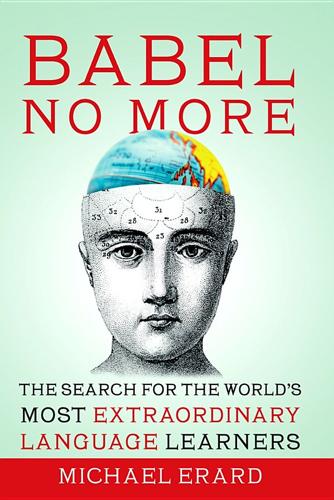
Babel No More: The Search for the World's Most Extraordinary Language Learners
by
Michael Erard
Published 10 Jan 2012
Desrocher, “Neuroimaging Studies of Obsessive-Compulsive Disorder in Adults and Children,” Clinical Psychological Review 26 (2006), 32–49. 229 When someone systemizes, she (or, more likely, he): Simon Baron-Cohen, “The Extreme Male Brain Theory of Autism,” TRENDS in Cognitive Sciences, 6:6 (2002), 248. 230 higher than doctors, veterinarians, and biologists: Simon Baron-Cohen et al., “The Autism-Spectrum Quotient (AQ): Evidence from Asperger Syndrome/High-Functioning Autism, Males and Females, Scientists and Mathematicians,” Journal of Autism and Developmental Disorders 31 (2001), 14. 230 has also found that autism occurs more frequently: Simon Baron-Cohen, “Does Autism Occur More Often in Families of Physicists, Engineers, and Mathematicians?,” Autism 2 (1998), 296–301. 230 relevant work on the obsessional interests of children with autism: Simon Baron-Cohen, “Obsessions in Children with Autism or Asperger Syndrome,” British Journal of Psychiatry, 175 (1999), 487. Chapter 17 232 talented mimics had lower levels of activation in brain regions related to speech: Many of these results and others are discussed in Grzegorz Dogil and Susanne Reiterer (eds.), Language Talent and Brain Activity (Berlin: Walter de Gruyter, 2009). 232 anatomically more complex than those in non-phonetician brains: Narly Golestani, Cathy J.
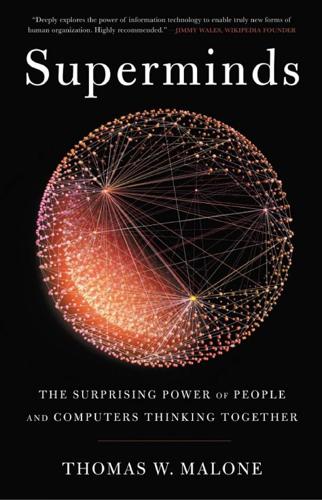
Superminds: The Surprising Power of People and Computers Thinking Together
by
Thomas W. Malone
Published 14 May 2018
Hill, Yogini Raste, and Ian Plumb, “The ‘Reading the Mind in the Eyes’ Test Revised Version: A Study with Normal Adults, and Adults with Asperger Syndrome or High-Functioning Autism,” Journal of Child Psychology and Psychiatry 42, no. 2 (2001): 241–51, doi:10.1017/S0021963001006643; Simon Baron-Cohen, Therese Jolliffe, Catherine Mortimore, and Mary Robertson, “Another Advanced Test of Theory of Mind: Evidence from Very High Functioning Adults with Autism or Asperger Syndrome,” Journal of Child Psychology and Psychiatry 38, no. 7 (1997): 813–22. Figure reproduced with author’s permission. 11. An adapted version of this figure was published in Anita Williams Woolley and Thomas W.

Personal Kanban: Mapping Work, Navigating Life
by
Jim Benson
and
Tonianne Demaria Barry
Published 2 Feb 2011
We are likewise grateful for the following people, whose actions and input not only enhanced this book, but enriched us in the process. For Jim: Vivian has been there since the start of this Personal Kanban ride and has been vital for its growth. My wife was there at the beginning, providing insight on learning styles, the intricacies of ADHD and Asperger Syndrome, and stages of language development. As a speech pathologist, Personal Kanban’s application were immediate and obvious. So, not only has she provided award-winning support by making it possible for us to write this book, she even inspired us to push the ideas forward in the first place. Thank you, Bunchie.

In Our Own Image: Savior or Destroyer? The History and Future of Artificial Intelligence
by
George Zarkadakis
Published 7 Mar 2016
Science and technology have become so competitive nowadays that success in these professions most often comes to those exhibiting high IQs and maximum dedication to the lab or the computer terminal. For them, the bustling noise of crowds or pointless chitchat by the water cooler seem distractions from a rewarding career. People with some degree of what is called Asperger syndrome can do exceptionally well in a world where the top jobs go to the top programmers and top scientists. In fact, this is already happening, and may explain to a certain degree false perceptions about an ‘autism epidemic’.25 If this trend in social selection persists, the intelligent computers of the future will most likely be the foster children of families composed of highly intelligent autistics.
…
(film) 56–7 AI Singularity 58, 126, 127, 129, 247, 270–5, 290, 302–3 Airbnb 233 algorithms 210–11 Al-Jazari 34 alternative therapies 40 Amazon 233, 246 androids 53–9, 66–73 Andronicus of Cyrrhus 30, 31 animal magnetism 40 Anthropic Principle 126–9 anthropomorphism 19–23, 25–7 antibody recognition system 282–3 Apple 81–2, 233 application programming interface (API) 265 Archimedes (287–212 BCbc) 30, 31 Aristotle 102, 103, 143, 134–42, 195–7 art 3–5, 9, 12–13, 15–18 Artificial Intelligence and human representations of the world 17–18 and the advent of computers 51–3 anthropomorphising inanimate objects 26–7 attitudes towards 45–7 challenges for researchers 52–3 computational model 211–16 current research directions 255 definitions of intelligence 48–9, 52 emergent properties of systems 182–3 emotional connection with 66–73 empirical perspective 152–3 evolution into a simulated universe 127–9 extracting meaning from data 255 human relationships with androids 53–9 imagining true AI 296–303 impacts in the second machine age 266–9 inability to perform basic human functions 275–9 limits of conventional computer technology 275–9 narrative of fear 45–7 narrative of love 45–7 origins of the discipline 256–9 potential for catastrophe 63–6 renewed interest from the 1980s 259–66 sentience in computers 65–6 theological reactions to 67 threat of taking over 58–9 see also AI artificial neural networks 285–7 Ashby, W. Ross 175, 176 Asimov, Isaac 51, 58 Asperger syndrome 301 attention 156–7, 160–1 Augustine, St 126 australopithecines 5, 6, 22 autism 300, 301 autocatalysis 183–4, 295 automata 217–18 autopoiesis concept 294–5 awareness 144–6, 156–7, 160–1, 162–3 see also self-awareness Babbage, Charles 62, 221–5 Analytical Engine 225–7, 235 Difference Engine 217, 223–5, 227 Bach, Johann Sebastian 186, 187 Bacon, Francis (1561–1626) 102 Bacon, Roger (c. 1214–1292) 35–6 barber paradox 204 Baron-Cohen, Simon 301 Bateson, Gregory 175 Baudrillard, Jean 76–8 behavioural psychology 50 behaviourism 154 Bell, Alexander Graham 230 Berger, Hans 159 Berkeley, George (Anglican bishop) 139–40 Berners-Lee, Sir Tim 241 Bicentennial Man (1999 film), robot Andrew 55, 57 big bang of the modern mind 10, 12–15 big data economy 249–55 binary arithmetic 149 binary logic 198 bioinformatics 123, 249 Blade Runner (1982 film) 53–4, 57, 72 Bletchley Park codebreakers 234–6 body, role in consciousness 169–71 body–mind dualism 124 and the simulated universe 126–9 problems for AI 129–31 body-mind problem 32, 114–19, 129–31 Bonaparte, Napoleon 37 Boole, George 197, 229 Boolean logic 197–200, 230 Borges, Jorge Luis 241–2, 294–5 Bostrom, Nick 129 brain (human) architecture in early humans 13 as a cybernetic system 175–9 as a guide for AI development 280–2 as a second-order cybernetic system 185–6 as a self-referencing entity 186–9 development in childhood 10–11 Human Brain Project (HBP) xiv–xvi, 164–5, 287 imaging techniques 158–60 research effort 163–5 structure of brain cells (neurons) 42–3 brain anatomy, the interpreter 24 brain-based devices (BBDs) 284–5 BRAIN project 287 brain size australopithecines 6 enlargement over time 13 Homo erectus 7 Homo habilis 6 modern humans 8 Neanderthals (H. neanderthalensis) 7, 8 Braitenberg, Valentino 175 brazen head stories 35–6, 58 Brooks, Rodney 275–6, 288 Butler, Samuel 289–90 Byrne, David 19 Byron, Lord 60, 62, 63–4, 226 Byzantine automata 33–4 calculating machines 219–27 Cameron, James 66 Capgras Syndrome 70–3 Cars (film) 20 cave paintings 9, 10, 16, 17, 20–1, 23 cellular automata 295–6 Chabris, Christopher 160 Chalmers, David xiv–xvi, 121 Chambers, John 252 Changeux, Jean-Pierre 166–7 chemistry, organic and inorganic 39–40 chess-playing automaton 37 chess-playing computer, Deep Blue 263 child development 10–11 chimpanzees 5, 12, 13 China, increasing use of industrial robots 267–8 Chomsky, Noam 13 Christianity, influence of Plato 101–2 Chua, Leon 286 Clarke, Arthur C. 193, 257 client-server architectures 245–9 cloud technologies 246 Clynes, Manfred 79 coding of information 149–52 cogito ergo sum (I think therefore I am) (Descartes) 112–13, 120, 131, 188 cognitive archaeology 75 cognitive psychology 154–5, 157–8 Cold War 236–8, 240–1, 257 Colossus (first programmable electronic computer) 235 Colossus: The Forbin Project (1970 film) 65–6 Columbus, Chris 55 coma 307 complex systems, emergent properties 41 computational theory of mind 210–16 computer metaphor for life 123–5 for the brain 43–4, 146 computer simulation, possibility of living in 127–9 computers as algorithms 210–11 as philosophical zombies (p-zombies) 122 creation of ‘electronic brains’ 51–3 computing history 217–31 advent of personal computers 237–8 automata 217–18 business-specific computer languages 237 calculating machines 219–27 Cold War developments 236–8, 240–1 digital revolution 243–8 distinction between machine and program 221, 225–9 first email 241 hardware development 229–30, 237 mobile devices 245 origins of the Internet 238–43 Second World War developments 234–6 servers 245–9 software development 229 telecommunications development 238–43 conflicting beliefs, inability of AI to cope with 277–8 conscious artefacts as objects of love 48–59 consciousness and the body–mind problem 114–19 as pure information 123–5 definition 156–7 emergence through self-referencing 188–9 empirical approach 143–6 nature of 91–4 problem in AI xi–xviii qualia of 120–3, 157–8 quantum hypothesis 106–9 role of the body 169–71 scientific study of 154–65 signatures of 158, 161–3 the hard problem of 120–3, 157–8 three states of 156–7 towards a theory of 166–71 uploading into a computer 91, 119, 146 view of Aristotle 137–8 Cook, Matthew 296 Cooke, Sir William Fothergill 42 Coppélia (ballet) 61–2 Cowen, Tyler 266, 269, 300, 313 creation myths 114 creationism 289 creativity, lacking in AI 276–7 Crick, Francis xiii, 155, 158 cultural relativism 114 cybernetic prostheses 79–84 cybernetic systems, first-and second-order 185–6 cybernetics disciplines spawned from 174–5 emergence of order 184–6 emergent properties of systems 182–3 lessons from 306–8 nature of cybernetic systems 172–5 origins of 175–83 cyberspace, human existence in 146–7 cyborgs (cybernetic organisms) 79–85 Damasio, Antonio 306–7 Darwin, Charles 289–90 Darwin, Erasmus 61 David (android in AI) 56–7 deductive logic 196, 197 Deep Blue (chess-playing IBM computer) 263 Dehaene, Stanislas 158, 161–3, 177, 185 Dehaene–Changeux theory of consciousness 166–7 Dennett, Daniel 12, 143–6 Descartes, René 36–42, 86–7, 92, 112–19, 139, 154–5 cogito ergo sum (I think therefore I am) 112–13, 120, 131, 188 Dick, Philip K. 36, 54, 71–2 Dickens, Charles 40 digital Artificial Life 105–6 digital biological data 123–4 digital heaven 125–9 digital lives 124–5 digital revolution 243–8 digital transformation 232–4 drivers for 254–5 risks associated with 250–3 DNA printing 123–4 DNA structure, discovery of 180–1 Doctor Mirabilis 35 Dow Jones Flash Crash (6 May 2010) 247–8 Dr Faustus myth 63 Dracula (Bram Stoker) 62 Drake equation 132–3 dreaming 110 Drexler, Eric 288–9 Dreyfus, Hubert 278 drugs, mind-altering 110, 111 du Bois-Reymond, Emil 39 du Vaucanson, Jacques 218 dualism Cartesian 37–42, 113–19 computer metaphor for the brain 43–4 cyborgs 83 versus monism 92–3 see also body–mind dualism dualist thinking 18, 25–6 Dunbar, Robin 14 Dune (Frank Herbert) 290 dwellings, construction by Homo sapiens 9 dynamic fluids metaphor for life 31–3 Dyson, Freeman 291 Eccles, Sir John 117–119 Edelman, Gerald 167, 282–5 Edison, Thomas 230 Einstein, Albert 166 Eisenhower, President Dwight D. 240 élan vital (spirit of life) 40–1 electric metaphor for life 38–40 electroencephalography (EEG) 159, 160, 161 email 241 emergence in complex systems 41 of order out of chaos 184–6 of self-awareness in AI 273–5 emergent properties of systems 182–3 empathy 11 empiricism 32, 102–3, 138–42, 196 employment, occupations at risk of automation 266–9 endorphins 170 enhancing cybertechnology 81–4 ENIAC computer 235–6 Enigma code 234–5 Enlightenment 139 Eno, Brian 19 entropy 128, 149–50 Epimenides’ paradox 204–5 Erewhon (Samuel Butler) 290 Escher, M.
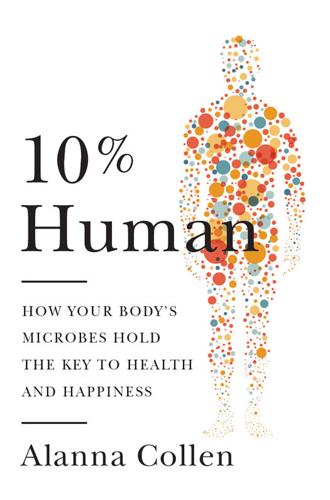
10% Human: How Your Body's Microbes Hold the Key to Health and Happiness
by
Alanna Collen
Published 4 May 2015
In the film, despite severe difficulties with social interaction and insistence on his daily routine, Hoffman’s character has an extraordinary memory and is able to recall years of data about the American baseball league. He is an autistic savant – both challenged and gifted. Despite the media interest in it, the remarkable musical, mathematical and artistic abilities of savantism are rare. In reality, autism forms a spectrum of symptoms, from those with average or above-average intelligence – known as Asperger syndrome – to those with severe autism and significant learning disabilities like Andrew Bolte. In common to all with autistic spectrum disorder (ASD) are difficulties with social behaviour. It was this feature that prompted the American psychiatrist Leo Kanner to identify autism as a distinct syndrome in 1943.
…
Page numbers in italic refer to the illustrations abscesses 37 Academic Medical Center, Amsterdam 255, 256–7 accidents, Toxoplasma infection and 97 acetate 107, 195, 217 acne 23, 129, 141, 142–4, 168 Actinobacteria 226, 230 adenoviruses 75, 76–7, 78 adipose cells see fat cells Adlerberth, Ingegerd 131 adrenalin 104–5 affluence, and twenty-first-century illnesses 46–8 Africa: asthma 50 births 214 diet and gut microbiota 184, 185, 262–3 Ebola epidemic 115 garden warblers 55 personal hygiene 176 age, and twenty-first-century illnesses 48–50 ageing 228, 231, 235, 268 agriculture: antibiotic use 147–8, 160–4, 165, 272 Neolithic Revolution 184–5, 201 Akkermansia 283–4 Akkermansia muciniphila 79–81, 193–4, 258 Alabama 46 alcohol hand-rubs 175 Alexander, Albert 37 Aliivibrio fischeri 12 Allen-Vercoe, Emma 109–10, 111, 112, 259–60, 261–2 allergies 24, 38–9, 43, 44, 48 affluence and 46–7 after Caesarean birth 212 antibacterial products and 171 antibiotics and 130, 166–7 antihistamines 39, 116, 269 bottle-feeding and 223 in developing countries 47 family size and 117, 118 gender differences 51, 52 hygiene hypothesis 117–19, 121, 130–2, 145 immune system and 44–5, 116–21, 130–1 increase in incidence 52, 116 and infections 116–19 microbes and 131–2 probiotics and 242 racial differences 50 Alm, Eric 253 Alps 115 alternative medicine 137–9 Alvarez, Walter 238 Amazon rainforest 262, 282 American Gut Project (AGP) 4–5, 281–2 Amerindians 262–3 amino acids 70, 71, 180, 271 ammonia 176–7 ammonia-oxidising bacteria (AOBs) 176–8 anaemia 221 anaerobic bacteria 95 anaphylactic attacks 38 androgens 143 Animalia 16, 17 animals: allergies to 119 antibiotics as growth promoters 147–8, 160–4, 272 coprophagy 245–8 Neolithic Revolution 184–5, 201 transmission of microbes 115 see also individual types of animal anthrax 115 antibacterial products 169–72, 175, 214–15 antibiotics 2, 147–68, 276–7, 281, 285 and acne 143 and allergies 130, 166–7 antibiotic resistance 152, 153, 154–5, 156 and autism 86, 90–2, 94–5, 106–7, 111, 165–6 and autoimmune diseases 167–8 benefits of 168 and birth 163, 215 broad-spectrum antibiotics 156, 270 and Clostridium difficile 157, 234, 250 development of 36–7 and diarrhoea 155, 157, 241–2 effects on microbiota 129, 157–8, 161 as growth promoters for animals 147–8, 160–4, 272 harmful side-effects 5–6, 155–6, 269 and immune system 129–30 and irritable bowel syndrome 64–5 lactobacilli and 206–7 and life expectancy 28 and obesity 147–9, 159–65 residues in vegetables 164–5 and stomach ulcers 74 and twenty-first-century illnesses 158–9 unnecessary prescriptions 152–3, 269–70 antibodies 30, 139, 231 antidepressants 269 antigens 132–3 antihistamines 39, 116, 269 ants 84 anxiety disorders 42, 51, 99, 175 AOBiome 176, 177–8 apes 16 apocrine glands 177 appendicitis 14, 15–16, 43, 223, 266 appendix 13–16, 21, 45, 203, 208, 266 appetite control 67–8, 72–3, 80, 196 arabinoxylan 194 Arabs 46 archaea 8 Argentina 210 arginine 271 arthritis 183, 196 asbestos 170 Asia 47, 214 Asperger syndrome 87 asthma 44, 49 antibiotics and 130, 166–7 bottle-feeding and 223 fibre and 199 immune system and 116, 196 incidence 38, 39, 47, 52 racial differences 50 wealth and 47 Atkinson, Richard 74–5, 77 attention deficit hyperactivity disorder (ADHD) 42, 98–9, 105, 108, 175 aureomycin 160 Australia: acne 142 birth 214–15 encephalitis lethargica 173 faecal transplants 250–1, 259 fruit and vegetable consumption 273 racial differences in diseases 50 sugar consumption 188, 189 twenty-first-century illnesses 46 autism 38, 43, 44, 49, 85–96 after Caesarean sections 212 antibiotics and 86, 90–2, 94–5, 106–7, 111, 165–6 autistic spectrum disorder (ASD) 87–8 behaviour problems 88, 108–9 and coprophagy 246 and ear infections 166 faecal transplants and 254–5 gastrointestinal symptoms 45, 85–7, 90 gender differences 51, 89 genetics and 89 immune system and 106, 108 incidence of 42, 46, 53, 88–9 lipopolysaccharide and 141 microbes and 90–2, 94–6, 109–12, 165–6 probiotics and 242 propionate and 107–9 racial differences 50–1 savants 87, 108 symptoms 87–8, 282 autoimmune diseases 24, 38, 39–41, 43 affluence and 47 and antibiotics 167–8 appendix and 16 and Caesarean sections 212 in childhood 49 in developing countries 47 faecal transplants and 254 gender differences 51, 52, 267 immune system and 44–5 incidence of 46 IPEX syndrome 133 probiotics and 242 racial differences 50 T helper cells and 119 see also individual diseases autointoxication 236–8 autopsies 33 babies 273–4 antibiotics 152–3, 158, 159–60, 161–2 bottle-feeding 220–6, 273–5 breast-feeding 216–20, 221, 222–6, 230–1, 274–5, 278, 285 Caesarean births 209–15, 220, 274, 278 caul births 214 colic 215–16 ear infections 151 gut microbiota 131, 217 immune system 208–9, 217, 227 infant mortality 222–3 probiotics and 242 transfer of microbes to 204–9, 212–14 vaginal delivery 209–12, 220, 274, 278 water birth 214 weaning 226 wet nursing 220–1 Bäckhed, Fredrik 66–7, 71, 147, 160 bacteria: alcohol hand-rubs 175 ammonia-oxidising bacteria 176–8 anaerobic bacteria 95 antibacterial products 169–72 antibiotic resistance 152, 153, 154–5, 156 collateral damage from antibiotics 155–6, 157 colony-forming units 244 DNA sequencing 17 lipopolysaccharide 140 and mitochondria 123, 123 prebiotics 258 probiotics 237–44 quorum sensing 136 and stomach ulcers 74 see also gut microbiota; microbes and individual types of bacteria bacteriocins 161, 206–7, 208 bacteriocytes 205 bacteriotherapy 245, 248 Bacteroides 23, 157, 194 Bacteroides fragilis 134–5 Bacteroides plebeius 192 Bacteroidetes 68–9, 70, 81, 185, 186, 187, 191, 226, 282 BALB mice 99 barley 139, 199 basal ganglia 174–5 bats 1–2, 100, 115, 124–5, 181, 182, 236 beans, fibre content 190, 191 Bedouin 201 Bedson, Henry 26 bees 124 behaviour: in autism 88, 108–9 changed by microbes 84–5, 96–7, 112–13 neurotransmitters 103, 104–5 propionate and 107–9 Bengmark, Stig 46 Bifidobacterium 193–4, 196–7, 217, 226, 239, 240, 258, 284 Bifidobacterium infantis 93 bile 145, 263 bioluminescence 12 bipolar disorder 105 birds 54–6, 205 birth 278 antibiotics in 163, 215 Caesarean section 209–15, 220, 274 caul births 214 childbed fever 32–3 home births 214 hormones 220 hygiene 214–15 transfer of microbes to babies 205–7, 212–13 vaginal deliveries 209–12, 220, 274, 278 water birth 214 bison 125–6 Blaser, Martin 162, 163, 182 blood 181 blood pressure 199, 231, 256 blood sugar levels 256 blood transfusions 249, 253, 254 bobcats 84, 97 Body Mass Index (BMI) 41, 69, 79, 161, 188, 193, 197 body odour 175–7 Bolte, Andrew 86–7, 88, 89–92, 94–6, 110, 111, 112, 165–6 Bolte, Ellen 86–7, 88, 89–92, 94–6, 106, 110–11, 112, 165–6 Bolte, Erin 86, 110, 111–12 Borody, Tom 250–2, 254–5, 259 bottle-feeding 220–6, 273–5 Boulpon, Burkina Faso 184, 185, 190 brain: connections to gut 92–3, 104–5, 106–7, 109–10 development of 93–4 encephalitis lethargica 173–4 immune system 103–4, 105 inflammation 108 memories 108–9 microbes and 98–9 neurotransmitters 103, 104–5 obsessive-compulsive disorder 172–3, 174 propionate and 107–9 strokes 50, 107, 183, 199, 256, 268 synapses 120 tetanus 91 Whipple’s disease 85 see also mental health conditions Brand-Miller, Jennie 215–16 Brazil 46, 47, 209, 212 bread 198, 199–200, 202 breast cancer 44, 145 breast-feeding 216–20, 221, 222–6, 230–1, 274–5, 278, 285 Britain: antibiotic use 130, 150–1 breast-feeding 225 Caesarean sections 210, 211–12 Clostridium difficile 156 consumption of fats and sugar 188 diabetes in children 40–1 fall in calorific intake 189 fruit and vegetable consumption 190–1, 273 gut microbes in babies 131 obesity 42, 58 broccoli 198 bronchitis 152 ‘Bubble Boy’ 126–8, 181 Burgess, James 253 Burkina Faso 184, 185, 190, 191, 263 Butler, Chris 153–4, 155 butyrate 107, 195, 196–7, 217, 257, 284 caecum 13, 21, 45, 128 Caesarean birth 209–15, 220, 274 caffeine 73, 74 cakes 198 California Institute of Technology 134 calories: calculating contents of foods 69–70 dieting 149, 186–7 differences in weight gain 77–8 fall in consumption of 189 microbes and extraction of 67, 70–2 and obesity 56–7, 61 Campylobacter jejuni 65 Canada 46, 47, 51, 62, 99, 106, 173, 259–60 cancer: ageing and 49 blood cancer 16 bottle-feeding and 223 breast cancer 44 as cause of death 268 cervical cancer 144 chemotherapy 270 colon cancer 23–4, 144, 145, 258 diet and 183 immune system and 120–1 infections and 144 liver cancer 144–5 lymphoma 127 metabolic syndrome and 256 microbes and 144–5 obesity and 42, 50, 145 prebiotics and 258 shingles and 271 stomach cancer 144 Cani, Patrice 78–9, 80–1, 193–4, 197 car accidents 97 carbohydrates: calorie content 69 dieting 185–8 digestion of 180 effects of 198 fibre 192 oligosaccharides 216–18 types of 197–8 carbolic acid 34, 36 Carmody, Rachel 179–80, 182, 198–9 carnivores 181–2, 192, 203, 263 casein 111, 200 cats 96 cattle 12–13, 181, 192, 201, 204, 272 caul births 214 cells, mitochondria 123, 123 cellulose 191, 192 centenarians 265 Centers for Disease Control (CDC) 88–9, 152, 212 Central America 100 Centre for Digestive Diseases, Sydney 250–2, 254 cervical cancer 144 Chain, Sir Ernst Boris 37 Charles University, Prague 97 cheese 159 cheetahs 124 chest infections 153 chickens: antibiotic treatment 147–8, 165 virus disease 57, 61, 74–5, 76–7, 78 Chida, Yoichi 93 childbed fever 32–3, 34 childbirth see birth children: allergies 38–9, 116–17 antibiotic use 151, 161–2, 165–6 autism 88–9, 165–6 brain development 93–4 death rates 28, 31 ear infections 86, 87, 90, 94, 151, 152, 153, 166, 222 fat intake 190 gut microbiota 226–7 hygiene 278–9 infectious diseases 31 obesity 58, 223–4 twenty-first-century illnesses 49 see also babies Children of the 90s project 130 chimpanzees 102, 245–7 China 47, 209, 249–50 chlorinated lime 33 chlorinated water 172 chlorine 35–6, 62 chloroform 172 cholera 15, 27, 30, 34–5, 45–6, 135–7, 139 Cholera Auto-Inducer 1 (CAI–1) 136 cholesterol 194, 229, 231, 256 Church, Andrew 173–4 ciprofloxacin 157–8 cleaning products 169–72, 175, 214–15 clindamycin 157 Clinton, Bill 10 Clostridium 96, 107, 145 Clostridium bolteae 106 Clostridium difficile 90, 271 antibiotics and 156–7, 234–5, 241, 250 in babies’ gut microbiota 213 bottle-feeding and 222 deaths from 156, 245 faecal transplants 249, 250, 251, 252–3, 259, 260 Lactobacillus and 206 symptoms 156 Clostridium tetani 90–2, 94, 95, 96, 110–11 clothing 176 cockroaches 204–5 coeliac disease 39, 41, 139–40, 183, 200, 202, 212 Cold Spring Harbor Laboratory, New York State 7, 24 colds 51, 129–30, 152, 167 colic, infantile 215–16 colitis, ulcerative 42, 49, 144 colon: autointoxication 236–8 colon cancer 23–4, 144, 145, 258 colonic irrigation 237 digestion 180–1 toxic megacolon 156, 245 see also gut microbiota; inflammatory bowel disease; intestines; irritable bowel syndrome colony-forming units (CFUs), bacteria 244 colostrum 217, 219, 220 constipation 62–3, 65, 238, 251, 254 contraceptives 102 cooking food 199 coprophagy 245–8 Cordyceps fungi 84 Cornell University 230 Corynebacterium 20, 21, 168–9, 177, 213 cough, sudden-onset 155 cowpox 27, 29 cows 12–13, 181, 192, 201, 204, 272 cow’s milk 216, 221 Crapsule 259 Crohn’s disease 42, 49, 52, 144 Cuba 210 Cyanobacteria 65 cytokines 48, 105, 106, 141 D-Day landings (1944) 37, 150, 158 dairy produce 200, 201 Dale, Russell 173–4 dander 119 Danish National Birth Cohort 161–2 Darwin, Charles 280 The Descent of Man 13, 14 The Expression of Emotions in Man and Animals 92 On the Origin of Species 124, 279 Dawkins, Richard, The Selfish Gene 125, 126 death 235–6 babies and children 28, 31, 222–3 causes of 268 Clostridium difficile 245 diarrhoea and 15 dementia 105 dendritic cells 219 Denmark 52, 161–2, 167–8 deodorants 175, 177, 178 deoxycholic acid (DCA) 145 depression 42, 45, 51, 65, 98, 103–4, 105, 141 dermatitis 23 developing countries: antibiotic use 153–4 twenty-first-century illnesses 53 Dhurandhar, Nikhil 56–7, 61, 74–5, 76–7, 82, 149 diabetes 38, 44, 139, 269 and antibiotics 167–8 bottle-feeding and 223, 224 breast-feeding and 231 and Caesarean sections 212 in childhood 4, 119 diet and 183 faecal transplants 255 gender differences 267 incidence of 39, 40–1, 47, 52, 158 leaky guts and 140 lipopolysaccharide and 141 metabolic syndrome 256–7 obesity and 42, 50, 256 probiotics and 242–3, 257–8 racial differences 50 symptoms 39–40 diarrhoea: antibiotics and 155, 157, 241–2 and autism 45, 85–7, 90 as cause of death 15, 27, 268 cholera 34–5, 135–7 Clostridium difficile 156, 222, 234–5, 241 and coprophagy 246 faecal transplants 250–1, 260 irritable bowel syndrome 62–5 probiotics and 241–2 diet see food dieting 59, 148–9, 184, 186–7, 197, 199 digestive system 180 see also colon; gut microbiota; intestines digoxin 271 diphtheria 27, 28 diseases: antibodies 30, 139, 231 diet and 183 epidemiology 35, 45–6 genes and 10, 43–4, 268 germ theory 34, 236 infectious diseases 27–9, 43, 115, 118, 153–4 obesity as infectious disease 75–7 pathogens 28–9 transmission of microbes 114–16 vaccinations 25, 26–7, 29–31, 35, 91, 118, 165 water-borne diseases 34–6 see also antibiotics and individual diseases DNA: and cancer 120–1, 144, 145 DNA sequencing 4, 9–11, 16–17, 65 human genome 279–80 doctors: antibiotic prescriptions 152–3, 277 hospital hygiene practices 31–4 Dodd, Diane 100–1 dogs 84, 85, 124 Dominguez-Bello, Maria Gloria 214, 278, 285 Dominican Republic 210 donors: faecal transplants 261, 262 sperm donors 260–1 dopamine 104–5 drugs: gut microbiota and 270–2 see also antibiotics dummies 151 dysbiosis 64–6 dysentery 15, 27 E. coli 62, 239, 254 ear infections 86, 87, 90, 94, 151, 152, 153, 166, 222 East Africa 176 Eastern Europe 47 Ebola 115 eccrine glands 177 ecological succession 208 eczema 38, 49 antibiotics and 130, 166–7 bottle-feeding and 223 incidence 39, 47, 52 prebiotics and 258 probiotics and 242 Eggerthella lenta 271 Egypt 201 Eiseman, Ben 251 elephants 245 Elizabeth II, Queen of England 265 emotions, and irritable bowel syndrome 92–3 encephalitis lethargica 173–4 energy: in food 69–72 mitochondria 123 storage in body 77–8 enterobacteria 131 Enterococcus 219 environment, and twenty-first-century illnesses 44 enzymes 12–13, 180, 182, 191, 192, 263 epidemiology 35, 45–6 epinephrine 104–5 Epstein-Barr virus 127 Eubacterium rectale 197 Eukarya 16 Europe: acne 142 antibiotic use 150, 163–4, 272 birth 214–15 breast-feeding 224 encephalitis lethargica 173 fat consumption 188 hygiene hypothesis 117 racial differences in diseases 50 see also individual countries evolution 11–12, 44, 84–5, 109, 124–6 fabrics, clothing 176 Faecalibacterium 284 Faecalibacterium prausnitzii 197 faeces: and birth 206, 207 coprophagy 245–7 DNA sequencing microbes in 23 faecal transplants 245, 248–57, 258–62 see also gut microbiota families, microbiotas 228 farming see agriculture Fasano, Alessio 136–7, 139–40, 200 fat cells: appetite control 72, 73 fibre and 196 lipopolysaccharide and 141 in obese people 78–9, 141 in pregnancy 230 storage of fat 72 FATLOSE (Faecal Administration To LOSE insulin resistance) 256–7 fats: calorie content 69, 77–8 consumption of 188, 189–90 dieting 186–8 digestion of 71, 180 high-fat diets 192–3, 194 fatty acids 180, 188 fibre: and Akkermansia 81, 193–4 and appendicitis 15 and butyrate 196–7 consumption of 190–1 in faeces 23 Five-a-Day campaign 273 and gut microbiota 191–9, 202–3, 204, 263, 276, 282–4 and obesity 192–5, 197 prebiotics 258 wheat and gluten intolerance 199–202 Finegold, Sydney 95–6, 106–7, 109 Firmicutes 68–9, 70, 81, 161, 185, 186, 187, 191, 226, 282 First World War 28, 36 fish, gut microbiota 205 Five-a-Day campaign 273 Fleming, Sir Alexander 36, 37, 154, 156 flies, fruit 100–1 Florence 184, 190, 191 Florey, Ethel 37 Florey, Howard 36–7 flour, fibre content 198 flu 27, 28, 48, 50, 129, 152, 167 folic acid 227–8 food 179–203, 272–3 and ageing 231 allergies and intolerances 38, 47, 49, 199–202 antibiotic residues in 164–5 calorie content 69–72 consumption of fats 188 cooking 199 digestion of 23 fibre content 190–9, 202–3, 273, 276, 282–4 and gut microbiota 184–8 healthy diet 183–4 Neolithic Revolution 184–5 packaged foods 182–3, 202 preservatives 202 sugar consumption 188–9 weaning babies 226 Food and Drug Administration (FDA) 172, 252, 272 food poisoning 15, 63–4, 65, 258 food supplements, prebiotics 258 formula milk 220–6 France 115, 160–1, 211 free-from foods 200 free will 112 Freud, Sigmund 98, 238 frogs 83–4, 124 fructo-oligosaccharides (FOS) 193–4, 258 fructose 180, 188 fruit 198, 273, 276 fruit flies 100–1 fungi 8, 84 galacto-oligosaccharides 258 galactose 207, 216 gangrene 34 garden warblers 54–6, 57, 73, 77, 78 gastric bypasses 81–2 gastritis 74 gastroenteritis 15, 16, 62, 63–4, 65, 167, 172, 222 Gattaca (film) 280 Ge Hong, Handbook of Emergency Medicine 249–50 gender differences: autism 51, 89 Toxoplasma infection 96–7 twenty-first-century illnesses 51–2, 267 Generation X 224 genes: appetite control 67–8 and autism 89 cholera bacteria 136–7 coeliac disease 139–40 faecal transplants 261 and gut microbiota 227 human genome 3–4, 7–10, 43–4, 279–80 in human microbiome 8, 11, 279 and lactose intolerance 201 and leaky gut 196–7 mutations 44 natural selection 125, 126 and obesity 60 and pheromones 102 and predisposition to disease 10, 43–4, 268 sperm donors 260–1 and vitamins 228 and weight control 71–2 genome-wide association studies (GWAS) 268 gentamycin 161 George V, King of England 265 germ-free mice 17–18, 66–9, 128, 134, 230 germ theory of disease 34, 236 Germany 46–7 giardiasis 15, 27 glucose 39–40, 180, 207, 216, 229, 256, 257 gluten 42, 111, 139–40, 142, 199–202 glycerols 180 gnotobiotic mice 17 goats 115, 201 Gombe Stream National Park, Tanzania 246 gonorrhoea 215 Goodall, Jane 246 Gordon, Jeffrey 18, 24, 67, 247, 262 GPR43 (G-Protein-coupled Receptor 43) 195–6, 195 grains 190, 191, 194, 197, 198 Gram-negative bacteria 140 Gram-positive bacteria 140 Gray, George 61 Group B strep 215 gut see colon; intestines ‘gut feelings’ 104 gut microbiota 2–4, 18, 21–4 and ageing 231, 235 American Gut Project 281–2 antibiotics and 157–8, 161 in appendix 14–16, 266 and autism 106, 165–6 bottle-feeding and 221–2 as cause of ill-health 236–7 in children 226–7 diet and 184–8 and digoxin 271 and drug outcomes 270–2 faecal transplants 245, 248–57, 258–62 and fibre 191–9, 202–3, 204, 263, 276, 282–4 and gastric bypasses 81–2 genes and 227 and infantile colic 216 and irritable bowel syndrome 63–6 and leaky gut 194–7 meat-eaters 191–2 and mental health conditions 99–100 and nutrition 180–2 and obesity 23–4, 66–72, 76 prebiotics 258 in pregnancy 229, 230 probiotics 237–44 raw-food diet 198–9 role in digestion 12–13, 70–1 transfer from mothers to babies 204–9, 213, 217 tribal societies 262–3, 282 Hai, Peggy Kan 233–5, 241, 245, 250, 251, 252 hairworms 84, 85 hand-washing 172–3, 175 happiness 103–5 Harvard University 179, 182, 198 Hawaii 233–5 Hawaiian bobtail squid 11 hay fever 38, 39, 46, 116, 117, 130, 166–7, 171, 242 healthy diet 183–4 heart disease: appendix and 16 as cause of death 268 diet and 183 digoxin 271 fibre and 199 heart attacks 50, 231 heart valve disease 161 lipopolysaccharide and 141 metabolic syndrome and 256, 257 obesity and 42, 47 statins 269 Helicobacter pylori 21, 74, 144 hepatitis A 119 herbivores 181, 192, 204, 263 herd immunity 30 herons 83 hibernation 61 high blood pressure 50, 231, 256 Hippocrates 61–2, 235 HIV 254 Hoffman, Dustin 87 holobiont 126 hologenome selection 126 home births 214 Hominidae 16 Homo sapiens 16 hookworms 118 hormones: acne 143 appetite control 67–8, 72–3, 80 contraceptives 102 in farming 272 and immune system 267 insulin 167, 256 in labour 220 leptin 67–8, 72–3, 78, 80, 196 menstrual cycle 229 sex hormones 51, 52 stress hormones 93 thyroid hormones 171 horses, rolling in dirt 176 hospitals, hygiene 31–4 houses, microbes in 228–9 Human Genome Project (HGP) 3–4, 7–10, 43–4, 279–80 Human Microbiome Project (HMP) 11, 18, 19–20, 22–3, 162 human papillomavirus (HPV) 144 Humphrys, John, The Great Food Gamble 272 Hungary 33 Huntington’s disease 44 hydrogen, in babies’ breath 216 hydrogen sulphide 248 hygiene 31–4, 168–72, 175–8, 214–15, 278–9 hygiene hypothesis, allergies 117–19, 121, 130–2, 145, 266 hyperphagia 55 idiopathic thrombocytopenia purpura 254 immune system 3, 114–46 and acne 144 and ageing 231 and allergies 39, 44–5, 116–21, 130–1 antibiotics and 37, 129–30 antibodies 30, 139, 231 antigens 132–3 appendix and 14–15, 16 and autism 106, 108 in babies 208–9, 217, 227 and the brain 103–4, 105 cell types 132–3 coeliac disease 139–40 evolution 126 and fat cells 78 fibre and 195–6 flu pandemic 48 germ-free mice 128 and gluten intolerance 202 and the gut 45 hygiene hypothesis 117–19, 121, 130–2, 145 inflammatory bowel diseases 144 IPEX syndrome 133 and leaky gut 137–42, 194–7 living without a microbiota 126–8 microbes and 121, 133–5 pheromones and 101, 102 probiotics and 242–3 targets 119–21 and twenty-first-century illnesses 51–2 vaccinations and 30 see also autoimmune diseases Imperial College, London 147 India 56–7, 173, 260 Indonesia 142 Industrial Revolution 221 infant mortality 222–3 infections, and allergies 116–19 infectious diseases 27–9, 43, 115, 118, 153–4 inflammation 145–6 and acne 144 and ageing 231 fibre and 196 leaky gut syndrome 142 and mental health conditions 105, 108 in obesity 79 in pregnancy 229 and twenty-first-century illnesses 243, 268 inflammatory bowel disease (IBD) 45, 63, 66 faecal transplants 251 gender differences 51 and gut microbiota 23–4, 144 incidence of 41, 42, 47, 49 influenza 27, 28, 48, 50, 129, 152, 167 insulin 38, 139, 269 faecal transplants and 256 insulin resistance 229, 256–7 lipopolysaccharide and 141 probiotics and 257–8 type 1 diabetes 39–40, 167 intestines 18–19, 22 appendix 13–16, 21, 203, 208, 266 caecum 13, 21, 45, 128 cholera 15, 27, 30, 34–5, 45–6, 135–7, 139 coeliac disease 41, 139–40 colorectal cancers 23–4, 144, 145, 258 connections to brain 92–3, 104–5, 106–7, 109–10 dysbiosis 64–6 germ-free mice 128 immune system and 45 leaky gut 137–42, 194–7, 200 mucus lining 79–80, 80, 129, 193, 283–4 necrotising enterocolitis 222 see also colon; diarrhoea; gut microbiota; inflammatory bowel disease; irritable bowel syndrome inulin 258 IPEX syndrome 133, 135 Iran 210 irritable bowel syndrome (IBS) 43, 45, 183 antibiotics and 64–5 emotions and 92–3 faecal transplants 251 gender differences 51 gluten-free diets 201 incidence of 42, 63 and mental health conditions 44 microbes and 63–6 post-infectious irritable bowel syndrome 62, 63 probiotics and 242 Italy 131, 150, 184, 185, 190, 191 Japan 142, 192, 247, 271 Jenner, Edward 25, 29 juices 198 Jumpertz, Reiner 70 Kanner, Leo 88, 89, 108–9 Kasthala, Gita 175–6 Khoruts, Alexander 248, 249, 259, 261–2 kidney cancer 145 kissing 102 kitchens, cleaning 169 Klebsiella 23 Knight, Rob 4, 213–14, 281–2 koalas 204, 217–18 Koch, Robert 34 Kolletschka, Jakob 33 Krau Wildlife Reserve, Malaysia 1–2 Kudzu bugs 205 labour see birth lactase 215–16 lactase persistence 201 lactate 217 lactic acid 217 lactic acid bacteria 206–8, 218–19, 222, 227, 229, 237 Lactobacillus 206–7, 213, 217, 219, 229, 239–40, 244, 257–9 Lactobacillus acidophilus 237 Lactobacillus bulgaricus 237 Lactobacillus johnsonii 208 Lactobacillus paracasei 239 Lactobacillus plantarum 101 Lactobacillus reuteri 161 Lactobacillus rhamnosus 239, 242 lactose 142, 200, 201–2, 207, 215–16, 218, 237 leaky gut walls 137–42, 194–7, 200 learning 108 leeches 181, 182 legumes, fibre content 276 Lemos de Goés, Adelir Carmen 209 lentils 198 leopards 115 leptin 67–8, 72–3, 78, 80, 196 leukaemia 223 Ley, Ruth 67–8, 186, 187, 230 life expectancy 28, 49, 237, 265–6, 268 light, bioluminescence 12 lime, chlorinated 33 lions 124 lipopolysaccharide (LPS) 79–80, 140–2, 187–8, 193, 194–5, 197, 284 Lister, Joseph 34, 36 lithium 98 liver cancer 144–5 lizards 245 London: cholera epidemic 34–5, 45–6, 135 Toxoplasma 96 Louisiana 46 low-carb diets 186, 187–8 low-fat diets 186 lungs 19 lupus 39, 41, 49, 50, 168 Lyman, Flo and Kay 108 lymph glands 45, 219 lymphoma 127 lysozyme 36 MacFabe, Derrick 106–7, 108, 109, 111, 112 McMaster University, Ontario 99 macrophages 132 Malawi 262–3, 282 Malaysia 1–2, 208 mammals 16, 122, 123–4, 204 manure, antibiotic contamination 164–5, 272 marmosets 77 Marseille 160–1 Marshall, Barry 74 marsupials 217–18 Massachusetts General Hospital for Children, Boston 40, 136–7, 200 mastoiditis 151, 153 Mazmanian, Sarkis 134 measles 27, 28, 31, 38, 119, 165, 266 meat 70–1, 181, 191–2 Medical Hypotheses 110 memory 108–9 memory B cells 132 meningitis 153 menstrual cycle 229 mental health conditions 42–3, 44 drug treatment 269 encephalitis lethargica 173–4 epidemiology 46 gastrointestinal symptoms 85–7, 106 gender differences 51 immune system and 105 lipopolysaccharide and 141 microbes and 24, 93–4, 97–9 probiotics and 238, 242 Streptococcus and 174–5 see also individual conditions mercury 263 metabolic syndrome 255–7, 258 metabolism 60, 229–30 metabolites 110, 111 Metchnikoff, Elie 180, 244 The Prolongation of Life 235–6, 237, 238 methicillin 154 metronidazole 129 Mexico 210 miasma theory 31–2, 34, 35 mice: antibiotics and 162–3 characteristic behaviours 99–100 diabetes in 267 faecal transplants 257 fibre in diet 193–4 genetically obese mice 67–9, 72–3 germ-free mice 17–18, 66–9, 128, 134, 230 microbial transplants 247 number of genes 7 ob/ob mice 67–9, 72–3, 194 probiotics and 242–4 microbes: and ageing 228, 231 and allergies 131–2 antibiotics and 129 antigens 132–3 and autism 90–2, 94–6, 106, 109–12 behaviour changes in host 84–5, 96–7, 112–13 in breast-milk 218–20, 222 and cancer 144–5 culturing 9 diversity 134, 282 DNA sequencing 4–5, 11 dysbiosis 64–6 evolution 11–12, 125–6 genes 279 in genetically obese mice 67–9 germ-free mice 17–18, 66–9, 128 germ theory of disease 34, 236 habitats in human body 18–23 in the home 228–9 hospital hygiene practices 31–4 immune system and 121, 133–5 kissing and 102 living without 126–8 and memory formation 109 and menstrual cycle 229 and mental health conditions 93–4, 97–9 in mouth 20–1 and neurotransmitters 104 in nostrils 21 Old Friends hypothesis 132, 145, 266 pheromones 100–2 Robogut 110, 111 on skin 19–20, 168–9 in stomach 21 and sweat 177 transfer from mothers to babies 122, 204–9, 212–14 transmission of 114–16 tree of life 16–17 in vagina 205–9, 212–14, 229 and vitamins 228 see also bacteria; gut microbiota; viruses Microbial Ecosystem Therapeutics 260 microbiome 8, 11, 227–9, 279, 280 Middle East 58 midwives 32–3 migraine 238 migrants, and twenty-first-century illnesses 50–1 migration, garden warblers 54–6 milk: antibiotics in 164 bottle-feeding 220–6, 273–5 breast-milk 216–20, 221, 222–6, 230–1, 274–5, 278, 285 cow’s milk 216, 221 lactobacilli and 207 lactose intolerance 200, 201 marsupials 218 milk banks 218–19 milk proteins 111 wet nursing 220–1 yogurt 206, 237 Millennials 224 Miller, Anne 149–50, 158 minerals 221, 227 Minnesota 170, 172 minocycline 168 Mississippi 46 mitochondria 123, 123 MMR vaccine 165 monkeys 16, 77 moorhens 124 Moraxella 21 mouth, microbes in 20–1 MRSA (methicillin-resistant Staphylococcus aureus) 154, 171, 172, 175, 212 mucus lining, intestines 79–80, 80, 129, 193, 283–4 multiple sclerosis (MS) 38, 39, 49 antibiotics and 168 and bottle-feeding 223 in children 119 faecal transplants and 254 incidence of 41, 52, 158 probiotics and 242 racial differences 50 Mumbai 56, 61 mumps 165 Munich University’s Children’s Hospital 46 muscles, tetanus 91 mutations, genes 44 Mycobacterium 27 myositis 39 National Food Survey (UK) 188, 189 National Health Service (NHS) 138, 210, 211–12 National Institute of Health, Phoenix, Arizona 70 National Institutes for Health (US) 18 natural killer cells 219 natural selection 124–6, 206 Nature 179 Nauru 58 necrotising enterocolitis 222 necrotising fasciitis 20 Neolithic Revolution 184–5, 187, 200, 201 nerves 104–5 nervous system, multiple sclerosis 41 Netherlands 52, 255, 256–7 neuropsychiatric disorders see mental health conditions neurotransmitters 103, 104–5 New York City 96 New York University 162, 214 New Zealand 46 Nicholson, Jeremy 147, 148, 160, 161 Nieuwdorp, Max 255, 256–7 nitric oxide 177 nitrite 177 Nitrosomonas eutropha 178 Nobel Prizes 37, 74, 180, 235 nori 192 North America 50, 117, 214–15, 224–6 Northern Ireland 47 nostrils, microbes in 21 nut allergies 38, 39 nutrition see food ob/ob mice 67–9, 72–3, 194 obesity 38, 43, 44, 54–61 Akkermansia and 79–81 antibiotics and 147–9, 159–65 appetite control 67–8, 72–3, 80, 196 breast-feeding and 223–4 and Caesarean sections 212 and cancer 145 in childhood 49 in developing countries 47 and diabetes 256 diet and 183 difficulty in losing weight 59–60 faecal transplants and 255–7 and fall in calorific intake 189 fat cells 78–9 garden warblers 54–6 gastric bypasses 81–2 gender differences 51 and genetics 60 gut microbiota and 23–4, 66–72, 76 incidence of 41–2, 46, 52–3 as infectious disease 75–7 and leaky gut syndrome 140–1 and liver cancer 145 and low fibre intake 197 metabolic syndrome 255–7 racial differences 50 surgery for 61, 66 viruses and 57, 61, 74–8 Obesity Society 82 obsessive-compulsive disorder (OCD) 42, 44, 51, 98–9, 105, 172–3, 174, 212, 246 oestrogen 171 Old Friends hypothesis 132, 145, 266 oligofructose 193–4 oligosaccharides 216–18, 220, 221, 222, 226 omnivores 276 OpenBiome 253–4, 261–2 oranges 198 overweight 41–2, 58 Oxford University 36, 37 oxygen 9 oxytocin 104–5 Pacific islands 58 Pakistan 26, 131 palaeo-diet 263 pancreas 39, 40, 180, 242–3 panda, giant 181–2 Papua New Guinea 84, 142 parasites 27, 83–4, 96–7, 98, 118 Paris 96 Parker, Janet 25, 26 Parkinson’s disease 105, 173, 174, 175, 254 passwords, beneficial microbes 134–5 Pasteur, Louis 34, 236 pathogens 28–9 peanut allergy 39 pectin 192 penicillin 36–7, 150, 154, 158, 162–3, 182 penicillinase 154 Penicillium 36 Peptostreptococcaceae 222 pesticides 272 Petrof, Elaine 259–60 Peyer’s patches 128 phagocytes 120, 141 pharyngitis 152 pheromones 100–2, 177 Phipps, James 29 pigs 148 pinworms 118 plague 30 plant foods see fruit; vegetables plants, ecological succession 208 pneumonia 27, 153, 268 polio 27–8, 29, 31, 38, 266 Pollan, Michael 202 pollen 119 polysaccharides 181 polysaccharide A (PSA) 134–5 Porpyhra 192 potatoes 191 poverty 48 Prague 97 prebiotics 258 pregnancy 205 antibiotics in 163 gut microbiota 229–31 metabolic changes 229–30 probiotics in 239 toxoplasmosis 96 vaginal bacteria 207–8 preservatives, food 202 Prevotella 185, 191, 192, 194, 206, 213, 263 primates 16, 102 probiotics 237–44, 257–9 propionate 107–9, 195, 217 Propionibacterium 20, 21, 168–9, 213, 239 Propionibacterium acnes 143–4 proteins 7, 9, 180, 196–7 Proteobacteria 65, 226, 230 Pseudomonas 206, 213 psoriasis 23, 49 psychoanalysis 238 Puerto Rico 214 pulses, fibre content 276 Pyrenees 115 Queen’s University, Kingston, Ontario 259 quorum sensing 136 rabbits 245 rabies 29–30, 84, 85 racial differences, twenty-first-century illnesses 50–1 Rain Man (film) 87 ram’s horn snails 83 rashes 155 rats 18, 84, 85, 96, 107–8, 185–6, 245 raw-food diet 198–9 RePOOPulate 260 reptiles, gut microbiota 205 respiratory tract infections 152, 153, 222 rheumatoid arthritis 39, 41, 223, 254 rice 198 rickets 221 Riley, Lee 165 Rio de Janeiro 209 Robogut 110, 111, 259 rodents 245 Roseburia intestinalis 197 Rosenberg, Eugene and Ilana 126 Rowen, Lee 7–8, 24 rubella 31, 165 Rush Children’s Hospital, Chicago 92 Russia 173 Rwanda 201 rye 139, 194, 199 sac-winged bats 100, 101 Salmonella 271 Sandler, Richard 92, 94, 95 sanitation 15, 35–6 Sardinia 52 savants, autistic 87, 108 Scandinavia 188 scarlet fever 27 scent see smells scent glands 177 schizophrenia 97–8, 105, 106, 108, 141, 246 Science 179 Scientific American magazine 97 scleroderma 50 scurvy 221 seaweed 192, 247 Second World War 37, 150, 158, 189 Semmelweis, Ignaz 32–3, 34, 215 sepsis 36 septicaemia 34 serotonin 103, 104–5 Severe Combined Immunodeficiency (SCID) 127 sewage systems 15 sex, pheromones 100–2, 177 sex hormones 51, 52 sexually-transmitted diseases 28 Sharon, Gil 101 sheep 201, 204 Shigella 128 shingles 271 short-chain fatty acids (SCFAs) 107–9, 195–6, 195, 197, 198, 217, 257 sinusitis 152, 157 skin 18, 23, 45 acne 23, 129, 141, 142–4, 168 hygiene 168–9 microbiota 19–20, 168–9, 213 pheromones 101–2 psoriasis 23, 49 rashes 155 sweat 177 washing 175, 177–8 see also eczema smallpox 25–7, 29, 30–1, 38, 266 smells: faeces 248 pheromones 100–2 Smith, Mark 252–3, 259, 261–2 smoking 145 snail, ram’s horn 83 Snow, John 35, 45–6 soaps 168–71, 172, 175, 177–8 social behaviour, autism 88 Soho, London 34–5, 45–6, 135 soil: ammonia-oxidising bacteria 176 antibiotic contamination 164–5 Somalia 25, 50–1 sore throats 152, 153, 173–4 South Africa 153–4 South America 47, 173, 214 South Pacific islands 58 Spain 151 sperm donors 260–1 spores, Clostridium difficile 234 squid, Hawaiian bobtail 11 Staphylococcus 20, 21, 36, 131, 172, 177, 213, 219 Staphylococcus aureus 154, 171, 172, 271 statins 269 steroids 116 stinkbugs 205 stomach 13 cancer 144 digestion 180 gastric bypasses 61, 66, 81–2 microbes in 21 ulcers 73–4, 144 stools see faeces Strachan, David 116–17, 118–19, 121, 131 Streptococcus 20, 150, 160, 172, 173–5, 206, 213, 215, 219, 229 Streptococcus pneumoniae 217 stress: irritable bowel syndrome 63, 92–3 leaky gut syndrome and 141 and stomach ulcers 73–4 stress hormones 93 strokes 50, 107, 183, 199, 256, 268 Stuebe, Alison 225 Stunkard, Dr Albert 59 Sudden Infant Death syndrome 222–3 Sudo, Nobuyuki 93 sugars 198 digestion 70, 180 falling consumption of 188–9 high-sugar diets 185–6, 192–3 and obesity 189–90 oligosaccharides 216 Sulawesi 142 superfoods 114 supermarkets 75, 159, 169, 182–3 surgery: antibiotic use 37 Caesarean sections 209–15, 220, 274 gastric bypasses 61, 66, 81–2 hygiene 34 Sutterella 282 sweat 101–2, 176–7 Sweden 51, 66–7, 131, 150, 157 Swiss mice 99 Switzerland 52 syphilis 27, 28, 158 T helper cells 118–19, 132 T regulatory cells (Tregs) 133–4, 144, 243 Tanzania 246 tapeworms 118 Tel Aviv University 101, 126 termites 181 testosterone 171, 267 tetanus 90–1 tetracycline antibiotics 168 throats, sore 152, 153, 173–4 thyroid hormones 171 ticks 1–2 tics, physical 282 toads 83–4 tonsillitis 223 Toronto 51 Tourette’s syndrome 42, 98–9, 175, 246 toxic megacolon 156, 245 Toxoplasma 84, 85, 96–7, 98–9, 112, 261 transplants, faecal 245, 248–57, 258–62 Transpoosion 245, 248 traveller’s diarrhoea 63–4 tree of life 16–17, 123–4 trematode worms 83–4 tribal societies: gut microbiota 262–3, 282 personal hygiene 175–6 triclosan 170–2 tryptophan 103, 105 tuberculosis 27, 29, 268 Turkey 97 Turnbaugh, Peter 68–70, 160, 182 Tutsi 201 twenty-first-century illnesses 37–43, 46–53, 266–9 antibiotics and 158–9 and Caesarean sections 212 diet and 183 dysbiosis 64–5 faecal transplants and 254 gender differences 267 inflammation 243, 268 see also allergies; autoimmune diseases; mental health conditions; obesity typhoid 27, 30 ulcerative colitis 42, 49, 144 ulcers, stomach 73–4, 144 United States of America: affluence and disease 47 antibacterial products 172 antibiotic use in livestock 147–8, 164, 165, 272 antibiotics 37, 150, 151, 152, 163, 215 breast-feeding 225–6 Caesarean sections 209–10 diabetes 52, 167 encephalitis lethargica 173 faecal transplants 252–4 fall in calorific intake 189 fibre consumption 197 gut microbiota 262–3 infant mortality 222–3 infectious diseases 27 irritable bowel syndrome 63 obesity 41–2, 46, 49, 58, 75, 81 supermarkets 183 vaccination schemes 31 University of Bern 101 University of Birmingham 25–6 University of Bristol 130 University of Colorado, Boulder 4, 213, 281–2 University of Gothenburg 66, 131 University of Guelph, Ontario 109, 111, 259 University of North Carolina School of Medicine 225 University of Western Ontario 106 University of Wisconsin 74–5 unsaturated fatty acids 188 upper respiratory tract infections (URI) 152, 153, 222 urinary tract 19 urinary tract infections 155, 157 urine, triclosan in 171 US Department of Agriculture (USDA) 189 US Navy 160 uterine cancer 145 vaccinations 25, 26–7, 29–31, 35, 91, 118, 165 vagina: microbes 19, 205–9, 212–14, 229 probiotic inserts 239 vaginal birth 209–12, 220, 274, 278 vagus nerve 91, 104–5 vampire bats 124–5, 181 vancomycin 91, 161 vegans 164 vegetables: antibiotic contamination 164–5, 272 digestion 70 fibre content 190–1, 276 Five-a-Day campaign 273 prebiotics 258 vegetarian diet 71, 192 Venezuela 262–3 Vetter, David 126–8, 181 Vibrio cholerae 135–7 Vienna General Hospital 32–3 viruses 8 antibiotics and 152 and autoimmune diseases 167 chicken disease 57, 61, 74–5, 76–7, 78 flu pandemic 48 menstrual cycle 229 and obesity 57, 61, 74–8 polio 27–8, 29, 31, 38, 266 rabies 29–30, 84, 85 smallpox 25–7, 29, 30–1, 38, 266 vitamins 16, 227–8 colon and 180–1 deficiencies 221 enzymes and 263 synthesis by bacteria 23 vitamin B12 23, 228 Vrieze, Anne 255, 256–7 VSL#3 242–4 Walkerton, Canada 62 wallabies 181 warblers, garden 54–6, 57, 73, 77, 78 Warren, Robin 74 washing 172–3, 175, 177–8 Washington University, St Louis 67, 247, 262 water birth 214 water supply: antibacterial products in 171, 172 cholera epidemic 34–5, 45–6, 135 chlorination 172 and irritable bowel syndrome 62 water-borne diseases 34–6 wealth, and twenty-first-century illnesses 46–8 weaning 226 weight gain: calories and 77–8 in pregnancy 230 see also obesity weight loss: dieting 59, 148–9, 184, 186–7, 197, 199 faecal transplants and 257 garden warblers 55–6 raw-food diet 199 Wellcome Collection, London 279 West Papua 176 Western diet 185–6 wet nursing 220–1 wheat 7, 111, 139, 194 wheat intolerance 38, 199–202 Whipple’s disease 85, 106, 107 white blood cells 45 Whitlock, David 176, 177–8 whooping cough 27 Whorwell, Peter 62–3, 252 Wold, Agnes 131–2, 134 women: acne 142–3 antibiotic use 150 breast-feeding 216–20, 221, 222–6, 230–1, 274–5, 278, 285 Caesarean births 209–15, 220, 274 consumption of fats 188 death in childbirth 32–3 lupus 168 menstrual cycle 229 obesity and cancer 145 pregnancy 229–30 Toxoplasma infection 96–7 transfer of microbes to babies 204–9, 212–14 and twenty-first-century illnesses 51–2, 267 vaginal births 209–12, 220, 274, 278 World Health Organisation (WHO) 25–6, 31, 211, 225, 239, 278, 285 The Worm, number of genes 7, 8 worms 83–4, 118 wounds 34, 36 Wrangham, Richard 198–9 xylan 191 Xylanibacter 185, 191 yeasts 8 yogurt 206, 237, 239–40, 244 Zobellia galactanivorans 192 zonula occludens toxin (Zot) 136–7, 139 zonulin 137, 139–40, 200 ABOUT THE AUTHOR ALANNA COLLEN is a science writer with a master’s degree in biology from Imperial College London and a PhD in evolutionary biology from University College London and the Zoological Society of London.

Infinite Powers: How Calculus Reveals the Secrets of the Universe
by
Steven Strogatz
Published 31 Mar 2019
Guicciardini, Reading the Principia, discusses how Newton’s contemporaries reacted to the Principia and what their criticisms of it were (some of their objections were cogent). A modern derivation of Kepler’s laws from the inverse-square law is given by Simmons, Calculus Gems, 326–35. 237 Neptune: Jones, John Couch Adams, and Sheehan and Thurber, “John Couch Adams’s Asperger Syndrome.” 237 Katherine Johnson: Shetterly, Hidden Figures, gave Katherine Johnson the recognition she so long deserved. For more about her life, see https://www.nasa.gov/content/katherine-johnson-biography. For her mathematics, see Skopinski and Johnson, “Determination of Azimuth Angle.” See also http://www-groups.dcs.st-and.ac.uk/history/Biographies/Johnson_Katherine.html and https://ima.org.uk/5580/hidden-figures-impact-mathematics/. 238 NASA official reminded the audience: Sarah Lewin, “NASA Facility Dedicated to Mathematician Katherine Johnson,” Space.com, May 5, 2016, https://www.space.com/32805-katherine-johnson-langley-building-dedication.html. 239 boisterous toast: Quoted in Kline, Mathematics in Western Culture, 282.
…
Theories of Light: From Descartes to Newton. Cambridge: Cambridge University Press, 1981. Schaffer, Simon. “The Laird of Physics.” Nature 471 (2011): 289–91. Schrödinger, Erwin. Science and Humanism. Cambridge: Cambridge University Press, 1951. Sheehan, William, and Steven Thurber. “John Couch Adams’s Asperger Syndrome and the British Non-Discovery of Neptune.” Notes and Records 61, no. 3 (2007): 285–99. http://rsnr.royalsocietypublishing.org/content/61/3/285. DOI: 10.1098/rsnr.2007.0187. Shetterly, Margot Lee. Hidden Figures: The American Dream and the Untold Story of the Black Women Mathematicians Who Helped Win the Space Race.

Visual Thinking: The Hidden Gifts of People Who Think in Pictures, Patterns, and Abstractions
by
Temple Grandin, Ph.d.
Published 11 Oct 2022
“A PET Meta-Analysis of Object and Spatial Mental Imagery.” Cognitive Psychology 16 (2004): 673–95. McFarland, M. “Why Shades of Asperger’s Syndrome Are the Secret to Building a Great Tech Company.” Washington Post, April 3, 2015. https://www.washingtonpost.com/news/innovations/wp/2015/04/03/why-shades-of-aspergers-syndrome-are-the-secret-to-building-a-great-tech-company/. Mellet, E., et al. “Functional Anatomy of Spatial Mental Imagery Generated from Verbal Instructions.” Journal of Neuroscience 16, no. 20 (2020): 6504–12. Mishkin, M., et al. “Object Vision and Spatial Vision: Two Cortical Pathways.” Trends in Neuroscience 6 (1983): 414–17.
…
Quotetab. https://www.quotetab.com/quotes/by-maya-lin/. McBride, J. Steven Spielberg. Jackson: University Press of Mississippi, 2011. McFarland, M. “Why Shades of Asperger’s Syndrome Are the Secret to Building a Great Tech Company.” Washington Post, April 3, 2015. https://www.washingtonpost.com/news/innovations/wp/2015/04/03/why-shades-of-aspergers-syndrome-are-the-secret-to-building-a-great-tech-company/. Mejia, Z. “Bill Gates Learned What He Needed to Start Microsoft in High School.” CNBC, May 24, 2018. https://www.cnbc.com/2018/05/24/bill-gates-got-what-he-needed-to-start-microsoft-in-high-school.html. Men, W., et al. “The Corpus Callosum of Albert Einstein’s Brain: Another Clue to His High Intelligence?”
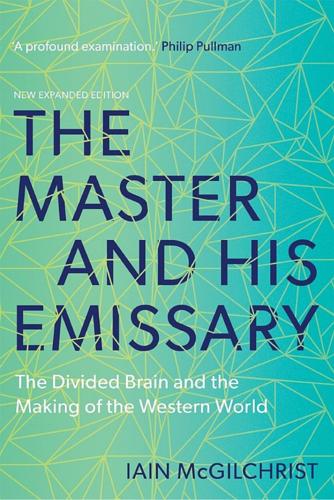
The Master and His Emissary: The Divided Brain and the Making of the Western World
by
Iain McGilchrist
Published 8 Oct 2012
. & Myklebust, H., Learning Disabilities: Educational Principles and Practices, Grune and Stratton, New York, 1967 Johnson, S., Preface to ‘The Plays of William Shakespeare’ [1765], in Nichol Smith, D. (ed.), Eighteenth Century Essays on Shakespeare, Clarendon Press, Oxford, 1963, pp. 112–61 Jolliffe, T.-D. & Baron-Cohen, S., ‘Are people with autism and Asperger syndrome faster than normal on the Embedded Figures Test?’, Journal of Child Psychology and Psychiatry, 1997, 38(5), pp. 527–34 ——, ‘A test of central coherence theory: linguistic processing in high-functioning adults with autism or Asperger syndrome: is local coherence impaired?’, Cognition, 1999, 71(2), pp. 149–85 Jones, C. R., Rosenkranz, K., Rothwell, J. C. et al., ‘The right dorsolateral prefrontal cortex is essential in time reproduction: an investigation with repetitive transcranial magnetic stimulation’, Experimental Brain Research, 2004, 158(3), pp. 366–72 Jones-Gotman, M. & Milner, B., ‘Design fluency: the invention of nonsense drawings after focal cortical lesions’, Neuropsychologia, 1977, 15(4–5), pp. 653–74 Jonson, B., Timber, or Discoveries: being Observations on Men and Manners, J.
…
, Cognition, 1985, 21(1), pp. 37–46 Baron-Cohen, S., Ring, H., Moriarty, J. et al., ‘Recognition of mental state terms: clinical findings in children with autism and a functional neuroimaging study of normal adults’, British Journal of Psychiatry, 1994, 165(5), pp. 640–49 Baron-Cohen, S., Tager-Flusberg, H. & Cohen, D. J. (eds.), Understanding Other Minds: Perspectives from Developmental Cognitive Neuroscience, Oxford University Press, Oxford, 2000 Baron-Cohen, S., Wheelwright, S. & Jolliffe, T., ‘Is there a “language of the eyes’‘? Evidence from normal adults, and adults with autism or Asperger syndrome’, Visual Cognition, 1997, 4(3), pp. 311–31 Barrash, J., Tranel, D. & Anderson, S. W., ‘Acquired personality disturbances associated with bilateral damage to the ventromedial prefrontal region’, Developmental Neuropsychology, 2000, 18(3), pp. 355–81 Barrick, T. R., Mackay, C. E., Prima, S. et al., ‘Automatic analysis of cerebral asymmetry: an exploratory study of the relationship between brain torque and planum temporale asymmetry’, NeuroImage, 2005, 24(3), pp. 678–91 Bartolomeo, P. & Chokron, S., ‘Left unilateral neglect or right hyperattention?’
…
(ed.), Functions of the Right Cerebral Hemisphere, Academic Press, London, 1983, pp. 33–64 ——, ‘The role of the right hemisphere in the Capgras delusion’, Psychopathology, 1994, 27(3–5), pp. 177–85 Ellis, H. D. & Florence, M., ‘Bodamer’s (1947) paper on prosopagnosia’, Cognitive Neuropsychology, 1990, 7(2), pp. 81–105 Ellis, H. D. & Gunter, H. L., ‘Asperger syndrome: a simple matter of white matter?’, Trends in Cognitive Sciences, 1999, 3(5), pp. 192–200 Ellis, H. D., Jeeves, M. A., Newcombe, F. et al. (eds.), Aspects of Face Processing, Martinus Nijhoff, Dordrecht, Netherlands, 1986 Ellis, S. J. & Small, M., ‘Denial of illness in stroke’, Stroke, 1993, 24(5), pp. 757–9 Elsner, J., ‘Physiognomics: art and text’, in Swain, S.
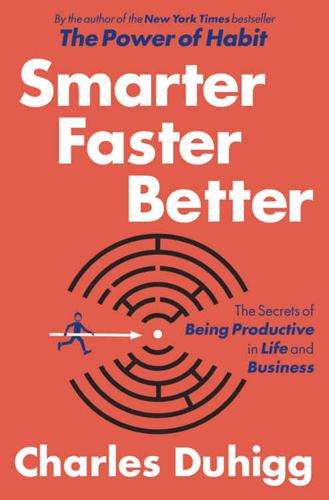
Smarter Faster Better: The Secrets of Being Productive in Life and Business
by
Charles Duhigg
Published 8 Mar 2016
So just as much as they can say something sharply funny, they can also jab you with a quick, hostile (but also funny) remark….The atmosphere at SNL, although we all liked each other, could become highly competitive based on the fact that there were 10 writers and only so many sketches could go on the show, so we all did our best to write the winning sketch or make (in my case) the best short film.” 58 percent The correct answers to the quiz are upset, decisive, skeptical, and cautious. These images come from Simon Baron-Cohen et al., “Another Advanced Test of Theory of Mind: Evidence from Very High Functioning Adults with Autism or Asperger Syndrome,” Journal of Child Psychology and Psychiatry 38, no. 7 (1997): 813–22. And Simon Baron-Cohen et al., “The ‘Reading the Mind in the Eyes’ Test Revised Version: A Study with Normal Adults, and Adults with Asperger Syndrome or High-Functioning Autism,” Journal of Child Psychology and Psychiatry 42, no. 2 (2001): 241–51. Science in 2010 Anita Williams Woolley et al., “Evidence for a Collective Intelligence Factor in the Performance of Human Groups,” Science 330, no. 6004 (2010): 686–88.

On the Edge: The Art of Risking Everything
by
Nate Silver
Published 12 Aug 2024
GO TO NOTE REFERENCE IN TEXT based on post-facto diagnoses: Michael Fitzgerald, “John von Neumann was on the autism spectrum,” ResearchGate, researchgate.net/publication/369141516_John_von_Neumann_was_on_the_autism_spectrum. GO TO NOTE REFERENCE IN TEXT classification scheme DSM-5: “What Is Asperger Syndrome?,” Autism Speaks, autismspeaks.org/types-autism-what-asperger-syndrome. GO TO NOTE REFERENCE IN TEXT moderately correlated personality: Lars-Olov Lundqvist and Helen Lindner, “Is the Autism-Spectrum Quotient a Valid Measure of Traits Associated with the Autism Spectrum? A Rasch Validation in Adults with and Without Autism Spectrum Disorders,” Journal of Autism and Developmental Disorders 47, no. 7 (July 2017): 2080–91, doi.org/10.1007/s10803-017-3128-y.
…
A Rasch Validation in Adults with and Without Autism Spectrum Disorders,” Journal of Autism and Developmental Disorders 47, no. 7 (July 2017): 2080–91, doi.org/10.1007/s10803-017-3128-y. GO TO NOTE REFERENCE IN TEXT The Autism-Spectrum Quotient: Simon Baron-Cohen et al., “The Autism-Spectrum Quotient (AQ): Evidence from Asperger Syndrome/High-Functioning Autism, Males and Females, Scientists and Mathematicians,” Journal of Autism and Developmental Disorders 31, no. 1 (2001): 5–17, doi.org/10.1023/A:1005653411471. GO TO NOTE REFERENCE IN TEXT into five subcategories: Although these category headings appear in the Baron-Cohen et. al. paper, ChatGPT helped me to formulate these definitions.
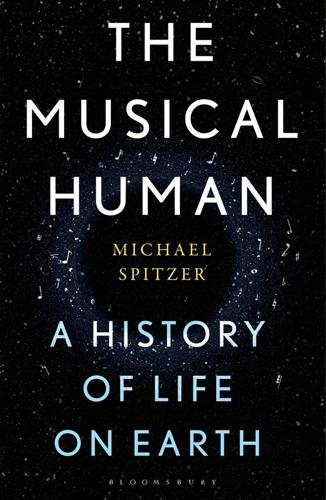
The Musical Human: A History of Life on Earth
by
Michael Spitzer
Published 31 Mar 2021
There is no indication that he understood these adult operatic emotions, or even felt them. It was enough that he knew which musical patterns evoked them. This final caveat is perhaps the most telling, given the still-raging debate in autism research on the recognition of emotion. Did Mozart have Asperger syndrome?34 Remarking on another of his students, the exceptionally gifted composer-pianist Derek Paravicini, a blind autistic savant, Ockelford makes a striking observation. Even if the twelve-year-old Paravicini didn’t appreciate the emotions he was improvising, the music itself taught him to understand emotion as he grew older.35 Before he was eighteen, Mozart had composed nothing with the emotional depth of Mendelssohn’s Octet or Midsummer Night’s Dream Overture, written when he was sixteen (although in his twenties, with a critical mass of experience, Mozart’s emotions go nuclear).
…
A ‘Prinner Riposte’ answers that with a melodic descent from the sixth to the third degree of the scale. An ‘Indugio’ (the Italian word for ‘procrastination’) is a playful tarrying on a chord. A ‘Ponte’ (meaning ‘bridge’), as the name suggests, is a bridge passage. 34Michele Raja, ‘Did Mozart suffer from Asperger syndrome?’, Journal of Medical Biography 23/2 (2013), pp. 84–92. 35https://vimeo.com/195606047 36Peter Pesic, ‘The Child and the Daemon: Mozart and Deep Play’, 19th-Century Music 25/2–3 (2001–2), pp. 91–107. 37John Blacking, Venda Children’s Songs: A Study in Ethnomusicological Analysis (Chicago: The University of Chicago Press, 1967), p. 29. 38John Blacking, How Musical is Man?

How to Write Your Will: The Complete Guide to Structuring Your Will, Inheritance Tax Planning, Probate and Administering an Estate
by
Marlene Garsia
Published 1 Jan 2008
Research Autism offers the best mechanism to achieve these aims.” New Philanthropy Capital “Research Autism allows people like me to get actively involved in their work and I feel like they value and encourage the contribution of people on the autism spectrum, something in my experience that is unique.” Joe Powell, adult with Asperger syndrome If you would like to know more about us and how you too can help, please visit our website at www.researchautism.net advertisement feature xli For children who are both deaf and blind, the world can be a lonely and frightening place. But with your support, there’s so much we can do to help.
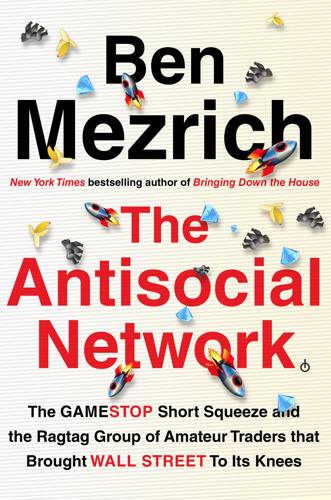
The Antisocial Network: The GameStop Short Squeeze and the Ragtag Group of Amateur Traders That Brought Wall Street to Its Knees
by
Ben Mezrich
Published 6 Sep 2021
In an interview with Barron’s, Burry had further pointed out that Sony and Microsoft were going to be launching consoles—and neither company had yet abandoned the physical disc drive, even if a significant portion of gamers had begun their games as digital downloads—which would draw more customers to GameStop—and that GameStop’s current situation “looks worse than it really is.” Burry’s buy didn’t just bolster the stock price; it galvanized a portion of the community on the WSB board—or at least warmed them to the idea that Keith might not be entirely crazy. The WSB board had a certain affinity for Burry; Burry self-identified as someone with Asperger syndrome, on the autism spectrum, and his quirky character in the movie, portrayed by Christian Bale, was extremely relatable to the subversives who often referred to themselves as “autists” in their comments. In some ways, the self-deprecation was a defense mechanism, and a way of marking the community as an antithesis to the mainstream: WSB wasn’t populated by Masters of the Universe; it was populated by “retards” whose wives all had boyfriends.

Shadow Work: The Unpaid, Unseen Jobs That Fill Your Day
by
Craig Lambert
Published 30 Apr 2015
Kiosk users may themselves tend to become robotic: cerebral, unemotional, and enslaved to digital data. This interactive style could gradually become accepted or even become a model of how to deal with humans as well as machines. Robots might instill behavior patterns that produce an epidemic of Asperger syndrome—in essence, creating a nation of biological automatons. For decades, people have been perfecting the art of building robots. The machines may now turn the tables and take over the manufacturing end, using human beings as their raw material. IN SOCIOLOGY, THE breakdown of bonds in a human community is called atomization.
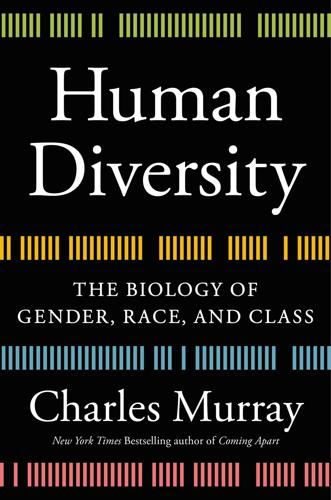
Human Diversity: The Biology of Gender, Race, and Class
by
Charles Murray
Published 28 Jan 2020
The Essential Difference: Male and Female Brains and the Truth About Autism. New York: Basic Books. Baron-Cohen, Simon, Jennifer Richler, Dheraj Bisarya et al. 2003. “The Systemizing Quotient: An Investigation of Adults with Asperger Syndrome or High–Functioning Autism, and Normal Sex Differences.” Philosophical Transactions of the Royal Society B: Biological Sciences 358 (1430): 361–74. Baron-Cohen, Simon, and Sally Wheelwright. 2004. “The Empathy Quotient: An Investigation of Adults with Asperger Syndrome or High Functioning Autism, and Normal Sex Differences.” Journal of Autism and Developmental Disorders 34 (2): 163–75. Barrett, J., and J. L. Armony. 2009.
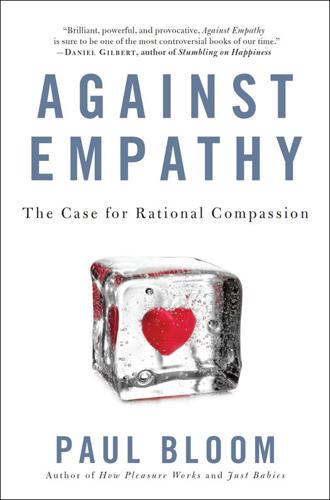
Against Empathy: The Case for Rational Compassion
by
Paul Bloom
belief in fate Konika Banerjee and Paul Bloom, “Why Did This Happen to Me? Religious Believers’ and Non-Believers’ Teleological Reasoning About Life Events,” Cognition 133 (2014): 277–303. 81 Another popular scale Simon Baron-Cohen and Sally Wheelwright, “The Empathy Quotient: An Investigation of Adults with Asperger Syndrome or High Functioning Autism, and Normal Sex Differences,” Journal of Autism and Developmental Disorders 34 (2004): 163–75. 83 overall the results are: meh Relevant sources here include Bill Underwood and Bert Moore, “Perspective-Taking and Altruism,” Psychological Bulletin 91 (1982): 143–73; Nancy Eisenberg and Paul A.
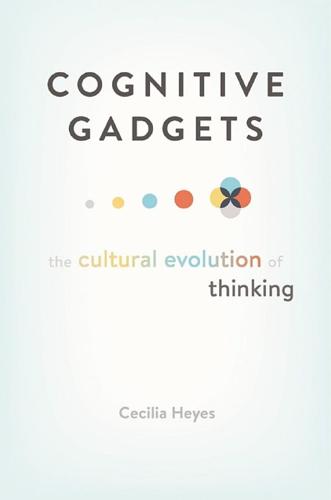
Cognitive Gadgets: The Cultural Evolution of Thinking
by
Cecilia Heyes
Published 15 Apr 2018
Annual Review of Neuroscience, 23(1), 473–500. Senju, A., and Csibra, G. (2008). Gaze following in human infants depends on communicative signals. Current Biology, 18(9), 668–671. Senju, A., Southgate, V., White, S., and Frith, U. (2009). Mindblind eyes: An absence of spontaneous theory of mind in Asperger syndrome. Science, 325(5942), 883–885. Senzaki, S., Masuda, T., and Ishii, K. (2014). When is perception top-down and when is it not? Culture, narrative, and attention. Cognitive Science, 38(7), 1493–1506. Shahaeian, A., Peterson, C. C., Slaughter, V., and Wellman, H. M. (2011). Culture and the sequence of steps in theory of mind development.

The Wisdom of Psychopaths: What Saints, Spies, and Serial Killers Can Teach Us About Success
by
Kevin Dutton
Published 15 Oct 2012
Andrews, “Development and Preliminary Validation of a Self-Report Measure of Psychopathic Personality Traits in Noncriminal Populations,” Journal of Personality Assessment 66, no. 3 (1996): 488–524. 30 The autistic spectrum, for instance … Autistic spectrum disorders include autism, Asperger’s syndrome, childhood disintegrative disorder, Rett syndrome, and pervasive developmental disorder not otherwise specified. For more information on autism in general, go to: www.autism.org.uk/. For more information on the idea of an autistic spectrum, go to www.autism.org.uk/about-autism/autism-and-asperger-syndrome-an-introduction/what-is-autism.aspx. 31 Less familiar, perhaps, but equally pertinent … For more information on schizophrenia—symptoms, diagnosis, treatment, and support—go to www.schizophrenia.com/. For more information on the schizophrenic spectrum, and possible underlying neural correlates, go to www.schizophrenia.com/sznews/archives/002561.html. 32 In an ingenious experiment, Newman demonstrated … See Kristina D.

I, Warbot: The Dawn of Artificially Intelligent Conflict
by
Kenneth Payne
Published 16 Jun 2021
A-10 Warthog abacuses Abbottabad, Pakistan Able Archer (1983) acoustic decoys acoustic torpedoes Adams, Douglas Aegis combat system Aerostatic Corps affective empathy Affecto Afghanistan agency aircraft see also dogfighting; drones aircraft carriers algorithms algorithm creation Alpha biases choreography deep fakes DeepMind, see DeepMind emotion recognition F-117 Nighthawk facial recognition genetic selection imagery analysis meta-learning natural language processing object recognition predictive policing alien hand syndrome Aliens (1986 film) Alpha AlphaGo Altered Carbon (television series) Amazon Amnesty International amygdala Andropov, Yuri Anduril Ghost anti-personnel mines ants Apple Aristotle armour arms races Army Research Lab Army Signal Corps Arnalds, Ólafur ARPA Art of War, The (Sun Tzu) art Artificial Intelligence agency and architecture autonomy and as ‘brittle’ connectionism definition of decision-making technology expert systems and feedback loops fuzzy logic innateness intelligence analysis meta-learning as ‘narrow’ needle-in-a-haystack problems neural networks reinforcement learning ‘strong AI’ symbolic logic and unsupervised learning ‘winters’ artificial neural networks Ashby, William Ross Asimov, Isaac Asperger syndrome Astute class boats Atari Breakout (1976) Montezuma’s Revenge (1984) Space Invaders (1978) Athens ATLAS robots augmented intelligence Austin Powers (1997 film) Australia authoritarianism autonomous vehicles see also drones autonomy B-21 Raider B-52 Stratofortress B2 Spirit Baby X BAE Systems Baghdad, Iraq Baidu balloons ban, campaigns for Banks, Iain Battle of Britain (1940) Battle of Fleurus (1794) Battle of Midway (1942) Battle of Sedan (1940) batwing design BBN Beautiful Mind, A (2001 film) beetles Bell Laboratories Bengio, Yoshua Berlin Crisis (1961) biases big data Bin Laden, Osama binary code biological weapons biotechnology bipolarity bits Black Lives Matter Black Mirror (television series) Blade Runner (1982 film) Blade Runner 2049 (2017 film) Bletchley Park, Buckinghamshire blindness Blunt, Emily board games, see under games boats Boden, Margaret bodies Boeing MQ-25 Stingray Orca submarines Boolean logic Boston Dynamics Bostrom, Nick Boyd, John brain amygdala bodies and chunking dopamine emotion and genetic engineering and language and mind merge and morality and plasticity prediction and subroutines umwelts and Breakout (1976 game) breathing control brittleness brute force Buck Rogers (television series) Campaign against Killer Robots Carlsen, Magnus Carnegie Mellon University Casino Royale (2006 film) Castro, Fidel cat detector centaur combination Central Intelligence Agency (CIA) centre of gravity chaff Challenger Space Shuttle disaster (1986) Chauvet cave, France chemical weapons Chernobyl nuclear disaster (1986) chess centaur teams combinatorial explosion and creativity in Deep Blue game theory and MuZero as toy universe chicken (game) chimeras chimpanzees China aircraft carriers Baidu COVID-19 pandemic (2019–21) D-21 in genetic engineering in GJ-11 Sharp Sword nuclear weapons surveillance in Thucydides trap and US Navy drone seizure (2016) China Lake, California Chomsky, Noam choreography chunking Cicero civilians Clarke, Arthur Charles von Clausewitz, Carl on character on culmination on defence on genius on grammar of war on materiel on nature on poker on willpower on wrestling codebreaking cognitive empathy Cold War (1947–9) arms race Berlin Crisis (1961) Cuban Missile Crisis (1962) F-117 Nighthawk Iran-Iraq War (1980–88) joint action Korean War (1950–53) nuclear weapons research and SR-71 Blackbird U2 incident (1960) Vienna Summit (1961) Vietnam War (1955–75) VRYAN Cole, August combinatorial creativity combinatorial explosion combined arms common sense computers creativity cyber security games graphics processing unit (GPU) mice Moore’s Law symbolic logic viruses VRYAN confirmation bias connectionism consequentialism conservatism Convention on Conventional Weapons ConvNets copying Cormorant cortical interfaces cost-benefit analysis counterfactual regret minimization counterinsurgency doctrine courageous restraint COVID-19 pandemic (2019–21) creativity combinatorial exploratory genetic engineering and mental disorders and transformational criminal law CRISPR, crows Cruise, Thomas Cuban Missile Crisis (1962) culmination Culture novels (Banks) cyber security cybernetics cyborgs Cyc cystic fibrosis D-21 drones Damasio, Antonio dance DARPA autonomous vehicle research battlespace manager codebreaking research cortical interface research cyborg beetle Deep Green expert system programme funding game theory research LongShot programme Mayhem Ng’s helicopter Shakey understanding and reason research unmanned aerial combat research Dartmouth workshop (1956) Dassault data DDoS (distributed denial-of-service) dead hand system decision-making technology Deep Blue deep fakes Deep Green DeepMind AlphaGo Atari playing meta-learning research MuZero object recognition research Quake III competition (2019) deep networks defence industrial complex Defence Innovation Unit Defence Science and Technology Laboratory defence delayed gratification demons deontological approach depth charges Dionysus DNA (deoxyribonucleic acid) dodos dogfighting Alpha domains dot-matrix tongue Dota II (2013 game) double effect drones Cormorant D-21 GJ-11 Sharp Sword Global Hawk Gorgon Stare kamikaze loitering munitions nEUROn operators Predator Reaper reconnaissance RQ-170 Sentinel S-70 Okhotnik surveillance swarms Taranis wingman role X-37 X-47b dual use technology Eagleman, David early warning systems Echelon economics Edge of Tomorrow (2014 film) Eisenhower, Dwight Ellsberg, Daniel embodied cognition emotion empathy encryption entropy environmental niches epilepsy epistemic community escalation ethics Asimov’s rules brain and consequentialism deep brain stimulation and deontological approach facial recognition and genetic engineering and golden rule honour hunter-gatherer bands and identity just war post-conflict reciprocity regulation surveillance and European Union (EU) Ex Machina (2014 film) expert systems exploratory creativity extra limbs Eye in the Sky (2015 film) F-105 Thunderchief F-117 Nighthawk F-16 Fighting Falcon F-22 Raptor F-35 Lightning F/A-18 Hornet Facebook facial recognition feedback loops fighting power fire and forget firmware 5G cellular networks flow fog of war Ford forever wars FOXP2 gene Frahm, Nils frame problem France Fukushima nuclear disaster (2011) Future of Life Institute fuzzy logic gait recognition game theory games Breakout (1976) chess, see chess chicken Dota II (2013) Go, see Go Montezuma’s Revenge (1984) poker Quake III (1999) Space Invaders (1978) StarCraft II (2010) toy universes zero sum games gannets ‘garbage in, garbage out’ Garland, Alexander Gates, William ‘Bill’ Gattaca (1997 film) Gavotti, Giulio Geertz, Clifford generalised intelligence measure Generative Adversarial Networks genetic engineering genetic selection algorithms genetically modified crops genius Germany Berlin Crisis (1961) Nuremburg Trials (1945–6) Russian hacking operation (2015) World War I (1914–18) World War II (1939–45) Ghost in the Shell (comic book) GJ-11 Sharp Sword Gladwell, Malcolm Global Hawk drone global positioning system (GPS) global workspace Go (game) AlphaGo Gödel, Kurt von Goethe, Johann golden rule golf Good Judgment Project Google BERT Brain codebreaking research DeepMind, see DeepMind Project Maven (2017–) Gordievsky, Oleg Gorgon Stare GPT series grammar of war Grand Challenge aerial combat autonomous vehicles codebreaking graphics processing unit (GPU) Greece, ancient grooming standard Groundhog Day (1993 film) groupthink guerilla warfare Gulf War First (1990–91) Second (2003–11) hacking hallucinogenic drugs handwriting recognition haptic vest hardware Harpy Hawke, Ethan Hawking, Stephen heat-seeking missiles Hebrew Testament helicopters Hellfire missiles Her (2013 film) Hero-30 loitering munitions Heron Systems Hinton, Geoffrey Hitchhiker’s Guide to the Galaxy, The (Adams) HIV (human immunodeficiency viruses) Hoffman, Frank ‘Holeshot’ (Cole) Hollywood homeostasis Homer homosexuality Hongdu GJ-11 Sharp Sword honour Hughes human in the loop human resources human-machine teaming art cyborgs emotion games King Midas problem prediction strategy hunter-gatherer bands Huntingdon’s disease Hurricane fighter aircraft hydraulics hypersonic engines I Robot (Asimov) IARPA IBM identity Iliad (Homer) image analysis image recognition cat detector imagination Improbotics nformation dominance information warfare innateness intelligence analysts International Atomic Energy Agency International Criminal Court international humanitarian law internet of things Internet IQ (intelligence quotient) Iran Aegis attack (1988) Iraq War (1980–88) nuclear weapons Stuxnet attack (2010) Iraq Gulf War I (1990–91) Gulf War II (2003–11) Iran War (1980–88) Iron Dome Israel Italo-Turkish War (1911–12) Jaguar Land Rover Japan jazz JDAM (joint directed attack munition) Jeopardy Jobs, Steven Johansson, Scarlett Johnson, Lyndon Joint Artificial Intelligence Center (JAIC) de Jomini, Antoine jus ad bellum jus in bello jus post bellum just war Kalibr cruise missiles kamikaze drones Kasparov, Garry Kellogg Briand Pact (1928) Kennedy, John Fitzgerald KGB (Komitet Gosudarstvennoy Bezopasnosti) Khrushchev, Nikita kill chain King Midas problem Kissinger, Henry Kittyhawk Knight Rider (television series) know your enemy know yourself Korean War (1950–53) Kratos XQ-58 Valkyrie Kubrick, Stanley Kumar, Vijay Kuwait language connectionism and genetic engineering and natural language processing pattern recognition and semantic webs translation universal grammar Law, Jude LeCun, Yann Lenat, Douglas Les, Jason Libratus lip reading Litvinenko, Alexander locked-in patients Lockheed dogfighting trials F-117 Nighthawk F-22 Raptor F-35 Lightning SR-71 Blackbird logic loitering munitions LongShot programme Lord of the Rings (2001–3 film trilogy) LSD (lysergic acid diethylamide) Luftwaffe madman theory Main Battle Tanks malum in se Manhattan Project (1942–6) Marcus, Gary Maslow, Abraham Massachusetts Institute of Technology (MIT) Matrix, The (1999 film) Mayhem McCulloch, Warren McGregor, Wayne McNamara, Robert McNaughton, John Me109 fighter aircraft medical field memory Merkel, Angela Microsoft military industrial complex Mill, John Stuart Milrem mimicry mind merge mind-shifting minimax regret strategy Minority Report (2002 film) Minsky, Marvin Miramar air base, San Diego missiles Aegis combat system agency and anti-missile gunnery heat-seeking Hellfire missiles intercontinental Kalibr cruise missiles nuclear warheads Patriot missile interceptor Pershing II missiles Scud missiles Tomahawk cruise missiles V1 rockets V2 rockets mission command mixed strategy Montezuma’s Revenge (1984 game) Moore’s Law mosaic warfare Mueller inquiry (2017–19) music Musk, Elon Mutually Assured Destruction (MAD) MuZero Nagel, Thomas Napoleon I, Emperor of the French Napoleonic France (1804–15) narrowness Nash equilibrium Nash, John National Aeronautics and Space Administration (NASA) National Security Agency (NSA) National War College natural language processing natural selection Nature navigation computers Nazi Germany (1933–45) needle-in-a-haystack problems Netflix network enabled warfare von Neumann, John neural networks neurodiversity nEUROn drone neuroplasticity Ng, Andrew Nixon, Richard normal accident theory North Atlantic Treaty Organization (NATO) North Korea nuclear weapons Cuban Missile Crisis (1962) dead hand system early warning systems F-105 Thunderchief and game theory and Hiroshima and Nagasaki bombings (1945) Manhattan Project (1942–6) missiles Mutually Assured Destruction (MAD) second strike capability submarines and VRYAN and in WarGames (1983 film) Nuremburg Trials (1945–6) Obama, Barack object recognition Observe Orient Decide and Act (OODA) offence-defence balance Office for Naval Research Olympic Games On War (Clausewitz), see Clausewitz, Carl OpenAI optogenetics Orca submarines Ottoman Empire (1299–1922) pain Pakistan Palantir Palmer, Arnold Pandemonium Panoramic Research Papert, Seymour Parkinson’s disease Patriot missile interceptors pattern recognition Pearl Harbor attack (1941) Peloponnesian War (431–404 BCE) Pentagon autonomous vehicle research codebreaking research computer mouse development Deep Green Defence Innovation Unit Ellsberg leaks (1971) expert system programme funding ‘garbage in, garbage out’ story intelligence analysts Project Maven (2017–) Shakey unmanned aerial combat research Vietnam War (1955–75) perceptrons Perdix Pershing II missiles Petrov, Stanislav Phalanx system phrenology pilot’s associate Pitts, Walter platform neutrality Pluribus poker policing polygeneity Portsmouth, Hampshire Portuguese Man o’ War post-traumatic stress disorder (PTSD) Predator drones prediction centaur teams ‘garbage in, garbage out’ story policing toy universes VRYAN Prescience principles of war prisoners Project Improbable Project Maven (2017–) prosthetic arms proximity fuses Prussia (1701–1918) psychology psychopathy punishment Putin, Vladimir Pyeongchang Olympics (2018) Qinetiq Quake III (1999 game) radar Rafael RAND Corporation rational actor model Rawls, John Re:member (Arnalds) Ready Player One (Cline) Reagan, Ronald Reaper drones reciprocal punishment reciprocity reconnaissance regulation ban, campaigns for defection self-regulation reinforcement learning remotely piloted air vehicles (RPAVs) revenge porn revolution in military affairs Rid, Thomas Robinson, William Heath Robocop (1987 film) Robotics Challenge robots Asimov’s rules ATLAS Boston Dynamics homeostatic Shakey symbolic logic and Rome Air Defense Center Rome, ancient Rosenblatt, Frank Royal Air Force (RAF) Royal Navy RQ-170 Sentinel Russell, Stuart Russian Federation German hacking operation (2015) Litvinenko murder (2006) S-70 Okhotnik Skripal poisoning (2018) Ukraine War (2014–) US election interference (2016) S-70 Okhotnik SAGE Said and Done’ (Frahm) satellite navigation satellites Saudi Arabia Schelling, Thomas schizophrenia Schwartz, Jack Sea Hunter security dilemma Sedol, Lee self-actualisation self-awareness self-driving cars Selfridge, Oliver semantic webs Shakey Shanahan, Murray Shannon, Claude Shogi Silicon Valley Simon, Herbert Single Integrated Operations Plan (SIOP) singularity Siri situational awareness situationalist intelligence Skripal, Sergei and Yulia Slaughterbots (2017 video) Slovic, Paul smartphones Smith, Willard social environments software Sophia Sorcerer’s Apprentice, The (Goethe) South China Sea Soviet Union (1922–91) aircraft Berlin Crisis (1961) Chernobyl nuclear disaster (1986) Cold War (1947–9), see Cold War collapse (1991) Cuban Missile Crisis (1962) early warning systems Iran-Iraq War (1980–88) Korean War (1950–53) nuclear weapons radar technology U2 incident (1960) Vienna Summit (1961) Vietnam War (1955–75) VRYAN World War II (1939–45) Space Invaders (1978 game) SpaceX Sparta Spike Firefly loitering munitions Spitfire fighter aircraft Spotify Stanford University Stanley Star Trek (television series) StarCraft II (2010 game) stealth strategic bombing strategic computing programme strategic culture Strategy Robot strategy Strava Stuxnet sub-units submarines acoustic decoys nuclear Orca South China Sea incident (2016) subroutines Sukhoi Sun Tzu superforecasting surveillance swarms symbolic logic synaesthesia synthetic operation environment Syria Taliban tanks Taranis drone technological determinism Tempest Terminator franchise Tesla Tetlock, Philip theory of mind Threshold Logic Unit Thucydides TikTok Tomahawk cruise missiles tongue Top Gun (1986 film) Top Gun: Maverick (2021 film) torpedoes toy universes trade-offs transformational creativity translation Trivers, Robert Trump, Donald tumours Turing, Alan Twitter 2001: A Space Odyssey (1968 film) Type-X Robotic Combat Vehicle U2 incident (1960) Uber Uexküll, Jacob Ukraine ultraviolet light spectrum umwelts uncanny valley unidentified flying objects (UFOs) United Kingdom AI weapons policy armed force, size of Battle of Britain (1940) Bletchley Park codebreaking Blitz (1940–41) Cold War (1947–9) COVID-19 pandemic (2019–21) DeepMind, see DeepMind F-35 programme fighting power human rights legislation in Litvinenko murder (2006) nuclear weapons principles of war Project Improbable Qinetiq radar technology Royal Air Force Royal Navy Skripal poisoning (2018) swarm research wingman concept World War I (1914–18) United Nations United States Afghanistan War (2001–14) Air Force Army Research Lab Army Signal Corps Battle of Midway (1942) Berlin Crisis (1961) Bin Laden assassination (2011) Black Lives Matter protests (2020) centaur team research Central Intelligence Agency (CIA) Challenger Space Shuttle disaster (1986) Cold War (1947–9), see Cold War COVID-19 pandemic (2019–21) Cuban Missile Crisis (1962) culture cyber security DARPA, see DARPA Defense Department drones early warning systems F-35 programme Gulf War I (1990–91) Gulf War II (2003–11) IARPA Iran Air shoot-down (1988) Korean War (1950–53) Manhattan Project (1942–6) Marines Mueller inquiry (2017–19) National Security Agency National War College Navy nuclear weapons Office for Naval Research Patriot missile interceptor Pearl Harbor attack (1941) Pentagon, see Pentagon Project Maven (2017–) Rome Air Defense Center Silicon Valley strategic computing programme U2 incident (1960) Vienna Summit (1961) Vietnam War (1955–75) universal grammar Universal Schelling Machine (USM) unmanned aerial vehicles (UAVs), see drones unsupervised learning utilitarianism UVision V1 rockets V2 rockets Vacanti mouse Valkyries Van Gogh, Vincent Vietnam War (1955–75) Vigen, Tyler Vincennes, USS voice assistants VRYAN Wall-e (2008 film) WannaCry ransomware War College, see National War College WarGames (1983 film) warrior ethos Watson weapon systems WhatsApp Wiener, Norbert Wikipedia wingman role Wittgenstein, Ludwig World War I (1914–18) World War II (1939–45) Battle of Britain (1940) Battle of Midway (1942) Battle of Sedan (1940) Bletchley Park codebreaking Blitz (1940–41) Hiroshima and Nagasaki bombings (1945) Pearl Harbor attack (1941) radar technology V1 rockets V2 rockets VRYAN and Wrangham, Richard Wright brothers WS-43 loitering munitions Wuhan, China X-37 drone X-drone X-rays YouTube zero sum games

Power, for All: How It Really Works and Why It's Everyone's Business
by
Julie Battilana
and
Tiziana Casciaro
Published 30 Aug 2021
Gruenfeld et al., “Power and the Objectification of Social Targets,” Journal of Personality and Social Psychology 95, no. 1 (2008): 111–27; Joe C. Magee and Pamela K. Smith, “The Social Distance Theory of Power,” Personality and Social Psychology Review, no. 2 (May 2013): 158–86. 8 Simon Baron-Cohen et al., “The ‘Reading the Mind in the Eyes’ Test Revised Version: A Study with Normal Adults, and Adults with Asperger Syndrome or High-Functioning Autism,” Journal of Child Psychology and Psychiatry and Allied Disciplines 42, no. 2 (2001): 241–51. 9 Michael W. Kraus et al., “Social Class, Contextualism, and Empathic Accuracy,” Psychological Science 21, no. 11 (2010): 1716–23. 10 Cameron Anderson et al., “The Local-Ladder Effect: Social Status and Subjective Well-Being,” Psychological Science 23, no. 7 (2012): 764–71. 11 Vanessa K.
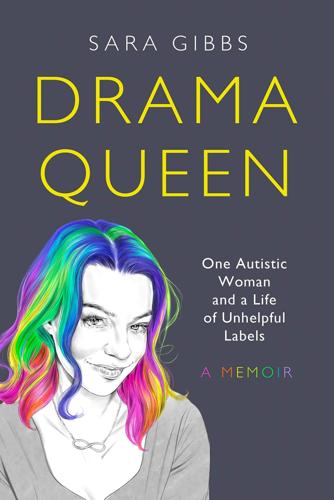
Drama Queen: One Autistic Woman and a Life of Unhelpful Labels
by
Sara Gibbs
Published 23 Jun 2021
I in no way wish to claim that these are universal, nor that I speak for all autistic people. At points in this book, particularly when reporting my early diagnosis, I refer to terminology that is now outdated or defunct in order to accurately describe my experience as it unfolded at the time. Asperger syndrome in particular has been widely retired as a diagnostic label, although many people still use it, as it was their original diagnosis. I can’t teach you about autism. All I can offer is a tour inside this one autistic brain. Please come in. I’m so sorry about the mess, but there’s plenty of comfy seating.
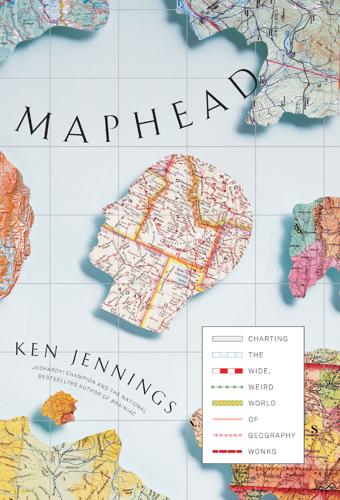
Maphead: Charting the Wide, Weird World of Geography Wonks
by
Ken Jennings
Published 19 Sep 2011
Isn’t it more like, well, child abuse? “Do you ever think, no geography is worth this?” I ask Mary Lee Elden after the match. “I think they learn something from it,” she says. “Yes, they feel disappointed, but they learn to handle their disappointment.” The bee, as you might expect, attracts more than its share of kids with Asperger syndrome and other social interaction issues, and these kids are particularly prone to losing control after a tough loss. “I’ll be honest with you,” says Mary Lee. “As a teacher and a parent, I don’t think I’d put my child through it.” But the organizers do what they can to soothe crushed dreams and bruised egos.

Chavs: The Demonization of the Working Class
by
Owen Jones
Published 14 Jul 2011
Originally, New Labour promised that under-eighteens would only have ASBOs served under exceptional circumstances but, as it turned out, year on year around half were imposed on the young. Overwhelmingly, those on the receiving end were both poor and working class-s-end, according to a survey in 2005, nearly four out of every ten ASBOs went to young people with mental health problems such as Asperger's Syndrome. In one case, a child with Tourette's was given an ASBO for his compulsive swearing. Whether or not you agree with ASBOs, it is difficult to deny that they have increased the bad reputation of young working-class kids and popularized the chav caricature. After all, members of the Bullingdon Club-whose great tradition is to smash up pubs and restaurants-- were never likely to be awarded an ASBO.
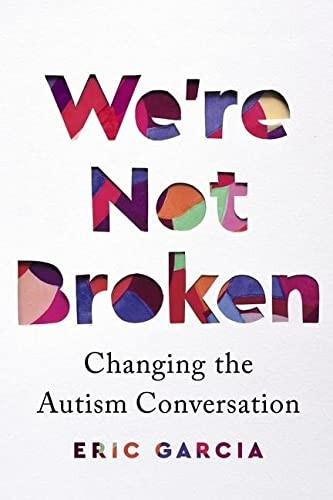
We're Not Broken: Changing the Autism Conversation
by
Eric Garcia
Published 2 Aug 2021
compared to just 6.6 per every 1,000 girls: Jon Baio et al., “Prevalence of Autism Spectrum Disorder Among Children Aged 8 Years—Autism and Developmental Disabilities Monitoring Network, 11 Sites, United States, 2014,” Centers for Disease Control and Prevention, April 27, 2018, https://www.cdc.gov/mmwr/volumes/67/ss/ss6706a1.htm#suggestedcitation. three girls out of eleven: Kanner, “Autistic Disturbances of Affective Contact.” “an extreme variant of male intelligence”: Hans Asperger, “‘Autistic Psychopathy’ in Childhood,” in Autism and Asperger Syndrome, ed. Uta Frith (Cambridge: Cambridge University Press, 1991), 37–92, https://blogs.uoregon.edu/autismhistoryproject/archive/hans-asperger-autistic-psychopathy-in-childhood-1944/. “autism can be considered as an extreme of the normal male profile”: Simon Baron-Cohen, “The Extreme Male Brain Theory of Autism,” Trends in Cognitive Science 2, no. 2 (June 2002), https://pubmed.ncbi.nlm.nih.gov/12039606/.
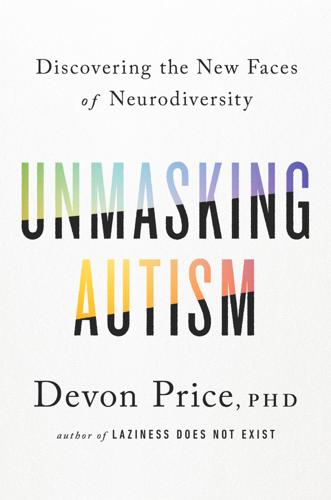
Unmasking Autism: Discovering the New Faces of Neurodiversity
by
Devon Price
Published 4 Apr 2022
BACK TO NOTE REFERENCE 91 https://autisticadvocacy.org/2012/10/october-2012-newsletter/. BACK TO NOTE REFERENCE 92 https://www.iidc.indiana.edu/irca/articles/social-communication-and-language-characteristics.html. See also: Foley-Nicpon, M., Assouline, S. G., & Stinson, R. D. (2012). Cognitive and academic distinctions between gifted students with autism and Asperger syndrome. Gifted Child Quarterly, 56(2), 77–89. BACK TO NOTE REFERENCE 93 For more on this, see Price, D. (2021). Laziness Does Not Exist. New York: Atria Books. BACK TO NOTE REFERENCE 94 Chapter 3 Hume, K. (2008). Transition Time: Helping Individuals on the Autism Spectrum Move Successfully from One Activity to Another.
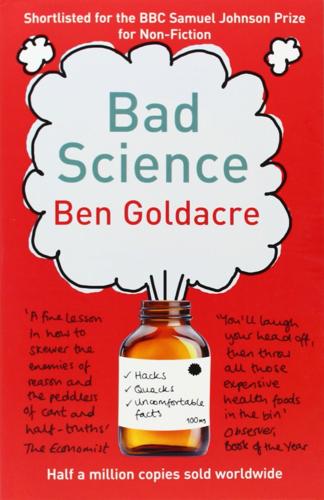
Bad Science
by
Ben Goldacre
Published 1 Jan 2008
Among other things, it’s a disorder of language, which might touch a particular chord with writers; but it’s also philosophically enjoyable to think about, because the flaws in social reasoning which are exhibited by people with autism give us an excuse to talk and think about our social norms and conventions. Books about autism and the autistic outlook on the world have become bestsellers. Here are some wise words for us all from Luke Jackson, a thirteen-year-old with Asperger’s syndrome, who has written a book of advice for teenagers with the condition (Freaks, Geeks and Asperger Syndrome). This is from the section on dating: If the person asks something like ‘Does my bum look fat?’ or even ‘I am not sure I like this dress’ then that is called ‘fishing for compliments’. These are very hard things to understand, but I am told that instead of being completely honest and saying that yes their bum does look fat, it is politer to answer with something like ‘Don’t be daft, you look great.’

Is the Internet Changing the Way You Think?: The Net's Impact on Our Minds and Future
by
John Brockman
Published 18 Jan 2011
If the Internet didn’t exist, or if it weren’t so ubiquitous, I’d have been forced long ago to submit to the tyranny of the cell phone and I would be an altogether less nice person to know. A Thousand Hours a Year Simon Baron-Cohen Psychologist, Autism Research Centre, Cambridge University; author, Autism and Asperger Syndrome: The Facts Possibly like you, all my e-mail goes into my Sent mailbox, just sitting there in case I want to check back on what I said to whom years ago. So what a surprise to see that I send approximately 18,250 e-mails each year (roughly 50 a day). Assuming three minutes per e-mail (let’s face it, I can’t afford to spend too long thinking about what I want to say), that’s about 1,000 hours a year on e-mail alone.
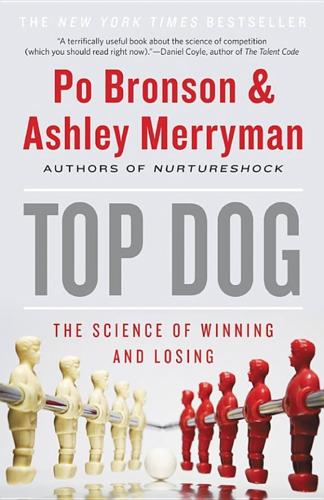
Top Dog: The Science of Winning and Losing
by
Po Bronson
and
Ashley Merryman
Published 19 Feb 2013
Watson, “The Hidden Dimensions of the Competition Effect: Basal Cortisol and Basal Testosterone Jointly Predict Changes in Salivary Testosterone after Social Victory in Men,” Psychoneuroendocrinology, vol. 37(11), pp. 1855-1865 (2012) … And Oxytocin…: Baron-Cohen, Simon, The Essential Difference: Men, Women, and the Truth about Autism, New York: Basic Books (2004) Baron-Cohen, Simon, Sally Wheelwright, Jacqueline Hill, Yogini Raste, & Ian Plumb, “The ‘Reading the Mind in the Eyes’ Test Revised Version: A Study with Normal Adults, and Adults with Asperger Syndrome or High-Functioning Autism,” Journal of Child Psychology & Psychiatry, vol. 42(2), pp. 241–251 (2001) Bartz, Jennifer, “Interactionist Perspective on the Prosocial Effects of Oxytocin in Humans,” Paper Presentation, Social Neuroendocrinology Pre-Conference, San Diego (2012) Bartz, Jennifer, Daphne Simeon, Holly Hamilton, Suah Kim, Sarah Crystal, Ashley Braun, Victor Vicens, & Eric Hollander, “Oxytocin Can Hinder Trust and Cooperation in Borderline Personality Disorder,” Social Cognitive & Affective Neuroscience, vol. 6(5), pp. 556–563 (2011) Bos, Peter A., Jaak Pansepp, Rose-Marie Bluthé, & Jack van Honk, “Acute Effects of Steroid Hormones and Neuropeptides on Human Social–Emotional Behavior: A Review of Single Administration Studies,” Frontiers in Neuroendocrinology, vol. 33(1), pp. 17–35 (2012) Bullock, Sandra, Quinton Aaron (perfs.), Hancock, John Lee (dir.

Stakeholder Capitalism: A Global Economy That Works for Progress, People and Planet
by
Klaus Schwab
Published 7 Jan 2021
An edited version of this speech can be found in under the title, “Our house is on fire’: Greta Thunberg, 16, Urges Leaders to Act on Climate,” The Guardian, January 2019, https://www.theguardian.com/environment/2019/jan/25/our-house-is-on-fire-greta-thunberg16-urges-leaders-to-act-on-climate.2“Ibidem”. 2 “Ibidem”. 3 “School Strike for Climate—Save the World by Changing the Rules,” Greta Thunberg, TEDxStockholm, December 2018, https://www.youtube.com/watch?v=EAmmUIEsN9A&t=1m46s. 4 Asperger Syndrome, National Autistic Society, United Kingdom, https://www.autism.org.uk/about/what-is/asperger.aspx. 5 Greta Thunberg, Twitter, August 2019, https://twitter.com/GretaThunberg/status/1167916636394754049. 6 “Greta Thunberg: How One Teenager Became the Voice of the Planet,” Amelia Tait, Wired, June 2019, https://www.wired.co.uk/article/greta-thunberg-climate-crisis. 7 “Summary for Policymakers of IPCC Special Report on Global Warming of 1.5ºC, Approved by Governments,” IPCC, October 2018, https://www.ipcc.ch/site/assets/uploads/sites/2/2019/05/pr_181008_P48_spm_en.pdf. 8 “The Limits to Growth,” The Club of Rome, 1972, https://www.clubofrome.org/report/the-limits-to-growth/. 9 “A Partner in Shaping History,” World Economic Forum, p. 55, http://www3.weforum.org/docs/WEF_First40Years_Book_2010.pdf.10“These 79 CEOs believe in global climate action”, World Economic Forum, November 2015, https://www.weforum.org/agenda/2015/11/open-letter-from-ceos-to-world-leaders-urging-climate-action/. 10 “A Partner in Shaping History,” World Economic Forum, p. 55, http://www3.weforum.org/docs/WEF_First40Years_Book_2010.pdf.10“These 79 CEOs believe in global climate action”, World Economic Forum, November 2015, https://www.weforum.org/agenda/2015/11/open-letter-from-ceos-to-world-leaders-urging-climate-action/. 11 “Global Emissions Have Not Yet Peaked,” Our World in Data, August 2020, https://ourworldindata.org/co2-and-other-greenhouse-gas-emissions#global-emissions-have-not-yet-peaked. 12 “A Breath of Fresh Air from an Alpine Village,” Swissinfo, https://www.swissinfo.ch/eng/tuberculosis-and-davos_a-breath-of-fresh-air-for-an-alpine-village/41896580. 13 “Global Warming Has Begun, Expert Tells Senate,” The New York Times, June 1988, https://www.nytimes.com/1988/06/24/us/global-warming-has-begun-expert-tells-senate.html. 14 “What Is the UNFCCC,” United Nations Climate Change, https://unfccc.int/process-and-meetings/the-convention/what-is-the-united-nations-framework-convention-on-climate-change. 15 “Global Extreme Poverty,” Our World in Data, https://ourworldindata.org/extreme-poverty. 16 “Ethiopia Secures Over $140 Million USD Export Revenue from Industrial Parks,” Ethiopian Investment Commission, October 2019, http://www.investethiopia.gov.et/index.php/information-center/news-and-events/868-ethiopia-secures-over-$-140-million-usd-export-revenue-from-industrial-parks.html.17Testimony based on an interview with Senait Sorsa by Peter Vanham, Awasa, Ethiopia, September 2019. 17 Testimony based on an interview with Senait Sorsa by Peter Vanham, Awasa, Ethiopia, September 2019. 18 “Interview with Senait Sorsa by Peter Vanham, Awasa, Ethiopia, September 2019” 19 .19“GDP Growth (annual %), Ethiopia,” World Bank, https://data.worldbank.org/indicator/NY.GDP.MKTP.KD.ZG?

Stakeholder Capitalism: A Global Economy That Works for Progress, People and Planet
by
Klaus Schwab
and
Peter Vanham
Published 27 Jan 2021
An edited version of this speech can be found in under the title, “Our house is on fire’: Greta Thunberg, 16, Urges Leaders to Act on Climate,” The Guardian, January 2019, https://www.theguardian.com/environment/2019/jan/25/our-house-is-on-fire-greta-thunberg16-urges-leaders-to-act-on-climate.2“Ibidem”. 2 “Ibidem”. 3 “School Strike for Climate—Save the World by Changing the Rules,” Greta Thunberg, TEDxStockholm, December 2018, https://www.youtube.com/watch?v=EAmmUIEsN9A&t=1m46s. 4 Asperger Syndrome, National Autistic Society, United Kingdom, https://www.autism.org.uk/about/what-is/asperger.aspx. 5 Greta Thunberg, Twitter, August 2019, https://twitter.com/GretaThunberg/status/1167916636394754049. 6 “Greta Thunberg: How One Teenager Became the Voice of the Planet,” Amelia Tait, Wired, June 2019, https://www.wired.co.uk/article/greta-thunberg-climate-crisis. 7 “Summary for Policymakers of IPCC Special Report on Global Warming of 1.5ºC, Approved by Governments,” IPCC, October 2018, https://www.ipcc.ch/site/assets/uploads/sites/2/2019/05/pr_181008_P48_spm_en.pdf. 8 “The Limits to Growth,” The Club of Rome, 1972, https://www.clubofrome.org/report/the-limits-to-growth/. 9 “A Partner in Shaping History,” World Economic Forum, p. 55, http://www3.weforum.org/docs/WEF_First40Years_Book_2010.pdf.10“These 79 CEOs believe in global climate action”, World Economic Forum, November 2015, https://www.weforum.org/agenda/2015/11/open-letter-from-ceos-to-world-leaders-urging-climate-action/. 10 “A Partner in Shaping History,” World Economic Forum, p. 55, http://www3.weforum.org/docs/WEF_First40Years_Book_2010.pdf.10“These 79 CEOs believe in global climate action”, World Economic Forum, November 2015, https://www.weforum.org/agenda/2015/11/open-letter-from-ceos-to-world-leaders-urging-climate-action/. 11 “Global Emissions Have Not Yet Peaked,” Our World in Data, August 2020, https://ourworldindata.org/co2-and-other-greenhouse-gas-emissions#global-emissions-have-not-yet-peaked. 12 “A Breath of Fresh Air from an Alpine Village,” Swissinfo, https://www.swissinfo.ch/eng/tuberculosis-and-davos_a-breath-of-fresh-air-for-an-alpine-village/41896580. 13 “Global Warming Has Begun, Expert Tells Senate,” The New York Times, June 1988, https://www.nytimes.com/1988/06/24/us/global-warming-has-begun-expert-tells-senate.html. 14 “What Is the UNFCCC,” United Nations Climate Change, https://unfccc.int/process-and-meetings/the-convention/what-is-the-united-nations-framework-convention-on-climate-change. 15 “Global Extreme Poverty,” Our World in Data, https://ourworldindata.org/extreme-poverty. 16 “Ethiopia Secures Over $140 Million USD Export Revenue from Industrial Parks,” Ethiopian Investment Commission, October 2019, http://www.investethiopia.gov.et/index.php/information-center/news-and-events/868-ethiopia-secures-over-$-140-million-usd-export-revenue-from-industrial-parks.html.17Testimony based on an interview with Senait Sorsa by Peter Vanham, Awasa, Ethiopia, September 2019. 17 Testimony based on an interview with Senait Sorsa by Peter Vanham, Awasa, Ethiopia, September 2019. 18 “Interview with Senait Sorsa by Peter Vanham, Awasa, Ethiopia, September 2019” 19 .19“GDP Growth (annual %), Ethiopia,” World Bank, https://data.worldbank.org/indicator/NY.GDP.MKTP.KD.ZG?
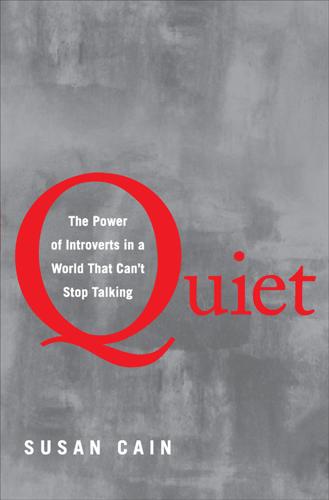
Quiet: The Power of Introverts in a World That Can't Stop Talking
by
Susan Cain
Published 24 Jan 2012
Introversion and Asperger’s both can involve feeling overwhelmed in social settings. But unlike people with Asperger’s, introverts often have strong social skills. Compared with the one third to one half of Americans who are introverts, only one in five thousand people has Asperger’s. See National Institute of Neurological Disorders and Stroke, Asperger Syndrome Fact Sheet, http://www.ninds.nih.gov/disorders/asperger/detail_asperger.htm. 36. the distinctly introverted E. M. Forster: Sunil Kumar, A Companion to E. M. Forster, vol. 1 (New Delhi: Atlantic Publishers and Distributors, 2007). 37. “human love at its height”: E. M. Forster, Howards End (London: Edward Arnold, 1910). 38.
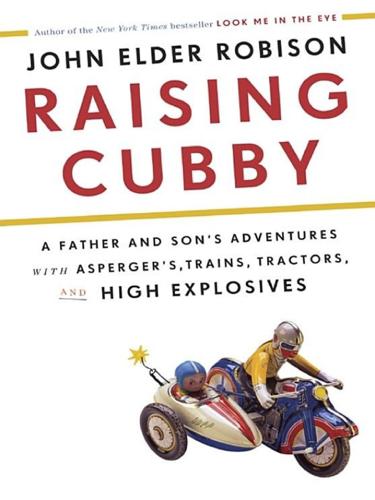
Raising Cubby: A Father and Son's Adventures With Asperger's, Trains, Tractors, and High Explosives
by
John Elder Robison
Published 12 Mar 2013
First is Lisa Greenman, a federal defense attorney who works tirelessly to help young people with disabilities charged with serious crimes. Monica Adler Werner of the Ivymount School in Rockville, Maryland, offered valuable advice about teaching kids on the spectrum. Lori Shery of ASPEN (the Asperger Syndrome Education Network) offered a parent’s perspective and wrote the reader’s group guide to this book. Pat Smith of Sewall Child Development Center in Boulder, Colorado, provided her perspective. Jan Anderson provided the valuable insights of a parent and is responsible for setting up my ongoing school events and workshops.
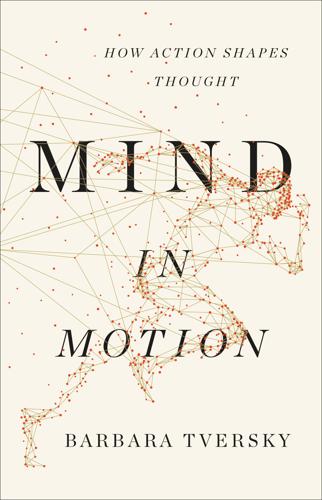
Mind in Motion: How Action Shapes Thought
by
Barbara Tversky
Published 20 May 2019
The Kuleshov effect: The influence of contextual framing on emotional attributions. Social Cognitive and Affective Neuroscience, 1(2), 95–106. Mind in the eye Baron-Cohen, S., Wheelwright, S., Hill, J., Raste, Y., & Plumb, I. (2001). The “Reading the Mind in the Eyes” test revised version: A study with normal adults, and adults with Asperger syndrome or high-functioning autism. Journal of Child Psychology and Psychiatry, 42(2), 241–251. Michaels, T. M., Horan, W. P., Ginger, E. J., Martinovich, Z., Pinkham, A. E., & Smith, M. J. (2014). Cognitive empathy contributes to poor social functioning in schizophrenia: Evidence from a new self-report measure of cognitive and affective empathy.
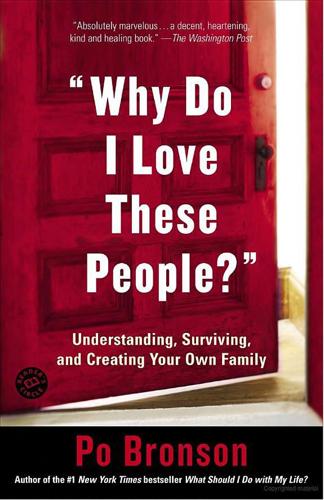
Why Do I Love These People?: Understanding, Surviving, and Creating Your Own Family
by
Po Bronson
Published 26 Dec 2006
By then she had three children under five. She was afraid to let her kids onto her own front patio. The most Denise could manage to improve her lot was to sign up for a correspondence course. Working was out of the question—the kids took every ounce of her strength. Her middle child, Ashleigh, was diagnosed with Asperger's syndrome. Denise's mother lived several miles away and helped out only a little. “That was my lowest point,” she recalled. She became antsy at the memory, and her words came urgently, rushing, as if she needed to get out of this bad neighborhood before she was recognized by someone from the old days.
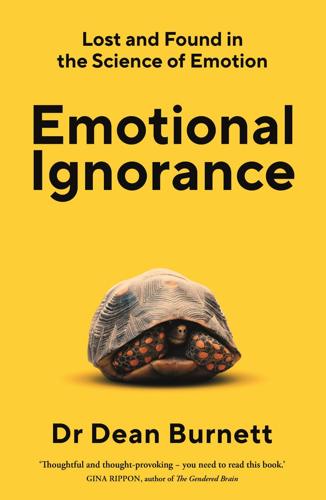
Emotional Ignorance: Lost and Found in the Science of Emotion
by
Dean Burnett
Published 10 Jan 2023
E624–E625. 64 Tone and Koziol, ‘(F)ailing women in psychiatry’. 65 Baron-Cohen, S., ‘The extreme male brain theory of autism’, Trends in Cognitive Sciences, 2002, 6(6): pp. 248–254. 66 Lawson, J., S. Baron-Cohen, and S. Wheelwright, ‘Empathising and systemising in adults with and without Asperger syndrome’, Journal of Autism and Developmental Disorders, 2004, 34(3): pp. 301–310. 67 Andrew, J., M. Cooke, and S. Muncer, ‘The relationship between empathy and Machiavellianism: an alternative to empathizing–systemizing theory’, Personality and Individual Differences, 2008, 44(5): pp. 1203–1211. 68 Baez, S., et al., ‘Men, women … who cares?

Apocalypse Never: Why Environmental Alarmism Hurts Us All
by
Michael Shellenberger
Published 28 Jun 2020
‘We should give up.’ ”81 Thunberg and her mother say that watching videos about plastic waste, polar bears, and climate change contributed to her depression and eating disorder. “So when I was eleven, I became ill. I fell into depression. I stopped talking and I stopped eating. In two months, I lost about ten kilos of weight. Later on, I was diagnosed with Asperger syndrome, OCD [obsessive-compulsive disorder], and selective mutism.”82 Twenty years ago, I discovered that the more apocalyptic environmentalist books and articles I read, the sadder and more anxious I felt. This was in sharp contrast to how I felt after reading histories of the civil rights movement, whose leaders were committed to an ethos, and politics, of love, not anger.
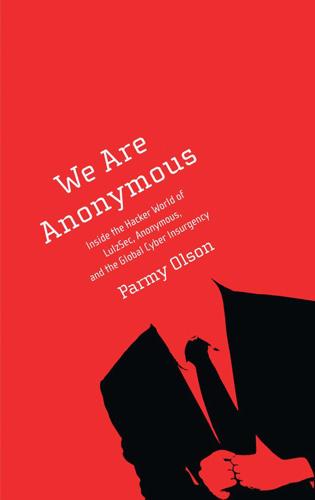
We Are Anonymous: Inside the Hacker World of LulzSec, Anonymous, and the Global Cyber Insurgency
by
Parmy Olson
Published 5 Jun 2012
Thanks to Civil and Switch, the website for one of the world’s biggest financial companies went down for twelve hours, and right on schedule. Over time, a handful of other people with botnets would help AnonOps. One of them was a young hacker named Ryan. Aged nineteen and living with his parents in Essex, England, Ryan’s real name was Ryan Cleary. In the offline world, Ryan, who would later be diagnosed with Asperger syndrome, rarely left his room, taking dinner from a plate that his mother would leave outside his bedroom door. But his dedication to becoming powerful online had paid off; over the years he amassed servers and what he claimed was a 1.3 million-computer monster botnet. Other online sources put the number at a still-enormous one hundred thousand computers.
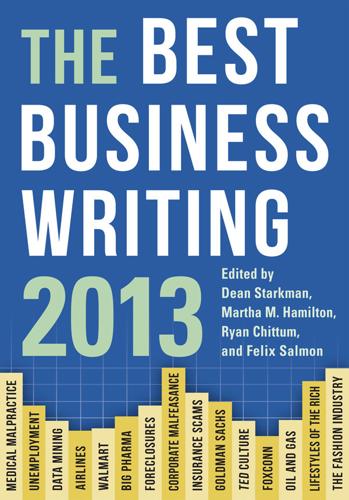
The Best Business Writing 2013
by
Dean Starkman
Published 1 Jan 2013
A labradoodle named Zelda and a rescued bichon frise, Duke, cost $17,000 a year, including food, health care, boarding, and a daily dog walker who charges $17 each per outing, he said. “Crushing Setback” Still, he sold two motorcycles he didn’t use and called his Porsche 911 Carrera 4S Cabriolet “the Volkswagen of supercars.” He and his wife have given more than $100,000 to a nonprofit she founded that promotes employment for people with Asperger syndrome, he said. Scheiner pays $30,000 a year to be part of a New York–based peer-learning group for investors called Tiger 21. Founder Michael Sonnenfeldt said members, most with a net worth of at least $10 million, have been forced to “re-examine lots of assumptions about how grand their life would be.”

Sandy Hook: An American Tragedy and the Battle for Truth
by
Elizabeth Williamson
Published 8 Mar 2022
Watt would chat online with “mostly women, because women are more into social media and Facebook, and they’d say, ‘I heard that was a hoax, and then they’d ask me, ‘Why would the government do this? What was the purpose behind it?’ And I’d say, ‘They were trying to ban the AR-15 and of course that was the weapon of choice by this kid with Asperger syndrome,’ and point out all the anomalies.” Her preoccupation migrated into the real world. “We’d be filling up our boat at a boat dock, and I would have crowds captivated. People would be like, ‘Oh my God.’ “I told my clients, people in elevators, waitresses. Duke would say, ‘Come on, we’ve gotta go.

Coders: The Making of a New Tribe and the Remaking of the World
by
Clive Thompson
Published 26 Mar 2019
“Bram will just pace around the house all day long, back and forth, in and out of the kitchen. Then he’ll suddenly go to his computer and the code just comes flowing out. And you can see by the lines that it’s clean,” she says. “It’s clean code!” She pats Cohen affectionately on his head. “My sweet little autistic nerd boy.” Cohen does, in fact, have Asperger syndrome. I was initially surprised to hear it. Although he was obviously a bit bombastic and prone to launching into minilectures on just about any subject that came up, I liked him a lot and found him witty and frequently charming. He seemed quite good at picking up on the emotional cues of those around him.
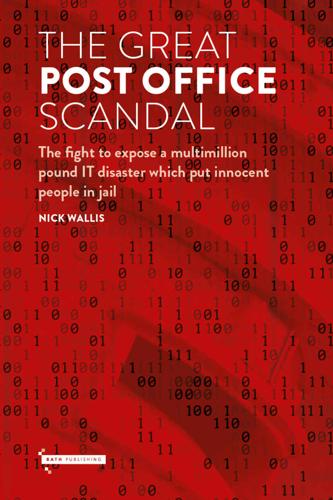
The Great Post Office Scandal: The Fight to Expose a Multimillion Pound Scandal Which Put Innocent People in Jail
by
Nick Wallis
Published 18 Nov 2021
I arrived early as I wanted to pick a table with some privacy. Wokingham isn’t far from Bracknell and Fujitsu is a big local employer. The Leathern Bottle is a vast split-level pub, full of nooks and crannies. That evening it was virtually empty. Richard arrived punctually. The first thing he did was tell me he had Asperger Syndrome.1 He apologised in case he appeared socially awkward or wasn’t that good at small talk. I apologised for my lack of technical knowledge and said I hoped we’d be able to understand each other. He smiled. I relaxed. I put my recorder on the table. Over two pints of lime and soda, Richard told me that when he saw the 2011 Inside Out broadcast, he realised he had some insider knowledge and might be able to help.

Homeland: The War on Terror in American Life
by
Richard Beck
Published 2 Sep 2024
Neuroscience seemed like the way to go but it didn’t pan out.”[82] Even as he acquired a fearsome arsenal of weapons—all purchased legally—in the months leading up to the attack, he continued to seek therapy and filled his private notebook with attempts at self-diagnosis, hoping that one of them would reveal a path to a normal life: “dysphoric mania,” “generalized anxiety disorder/social anxiety disorder/OCD/PTSD (chronic),” “asperger syndrome/autism,” “ADHD,” “schizophrenia,” “chronic insomnia,” “psychosis,” etc.[83] On page eighteen of the notebook, the journaling stopped. Over the following eight pages, Holmes just wrote the word “Why?” over and over, 249 times, the words increasing in size with each page. From then on, the notebook is dedicated to planning the attack: sketched maps of potential targets, lists of weapons with notes on their utility, different ways to kill a lot of people.

Engineering Security
by
Peter Gutmann
The Impact of Affective States on Analytic Reasoning”, Norbert Schwarz and Herbert Bless, in “Emotion and Social Judgements”, Routledge, 1991, p.55. [324] “On being happy and mistaken: mood effects on the fundamental attribution error”, Joe Forgas, Journal of Personality and Social Psychology, Vol.75, No.2 (August 1998), p.318. [325] “Mood in foreign exchange trading: Cognitive processes and performance”, Kevin Au, Forrest Chan, Denis Wang and Ilan Vertinsky, Organizational Behavior and Human Decision Processes, Vol.91, No.2 (July 2003), p.322. [326] “Flawed Self-Assessment: Implications for Health, Education, and the Workplace”, David Dunning, Chip Heath and Jerry Suls, Psychological Science in the Public Interest, Vol.5, No.3 (December 2004), p.69. [327] “The Effect of Mood on Detection of Covariation”, Julia Braverman, Personality and Social Psychology Bulletin, Vol.31, No.11 (November 2005), p.1487. [328] “The sad truth about depressive realism”, Lorraine Allan, Shepard Siegel and Samuel Hannah, Quarterly Journal of Experimental Psychology, Vol.60, No.3 (March 2007), p.482. [329] “Effects of mood and emotion on juror processing and judgments”, Carolyn Semmler and Neil Brewer, Behavioral Sciences & the Law, Vol.20, No.4 (July/August 2002), p.423. [330] “Emotional evidence and jurors’ judgments: the promise of neuroscience for informing psychology and law”, Jessica Salerno and Bette Bottoms, Behavioral Sciences & the Law, Vol.27, No.2 (March/April 2009), p.273. [331] “Myers Briggs Type Indicator personality profiles in unipolar depressed patients”, David Janowsky, Elliot Hong, Shirley Morter and Laura Howe, World Journal of Biological Psychiatry, Vol.3, No.4 (October 2002), p.207. [332] “Psychological Disorder in Adolescents and Adults with Asperger Syndrome”, Digby Tantam, Autism, Vol.4, No.1 (March 2000), p.47. [333] “Psychiatric Comorbidity in Young Adults with a Clinical Diagnosis of Asperger Syndrome”, Tove Lugnegard, Maria Hallerback and Christopher Gillberg, Research in Developmental Disabilities: A Multidisciplinary Journal, Vol.32, No.5 (September/October 2011), p.1910. [334] “Illusion and Well-Being: A Social Psychological Perspective on Mental Health”, Shelley Taylor and Jonathon Brown, Psychological Bulletin, Vol.103, No.2 (March 1988), p.193. [335] “The Folly of Fools”, Robert Trivers, Basic Books, 2011. [336] “Lob der Halbwahrheit: Warum wir so manches verschweigen“, David Nyberg, Junius Verlag, 1994. [337] “The Optimism Bias: A Tour of the Irrationally Positive Brain”, Tali Sharot, Pantheon Books, 2011. [338] “Anterior Cingulate Cortex, Error Detection, and the Online Monitoring of Performance”, Cameron Carter, Todd Braver, Deanna Barch, Matthew Botvinick, Douglas Noll and Jonathan Cohen, Science, Vol.280, No.5364 (1 May 1998), p.747. [339] “The Contribution of the Anterior Cingulate Cortex to Executive Processes in Cognition”, Cameron Carter, Matthew Botvinick and Jonathan Cohen, Reviews in the Neurosciences, Vol.10, No.1 (1999), p.49. [340] “Learned Predictions of Error Likelihood in the Anterior Cingulate Cortex”, Joshua Brown and Todd Braver, Science, Vol.307, No.5712 (18 February 2005), p.1118. [341] “Cognitive Processes in Depression”, Lauren Alloy, Guilford Press, 1988.